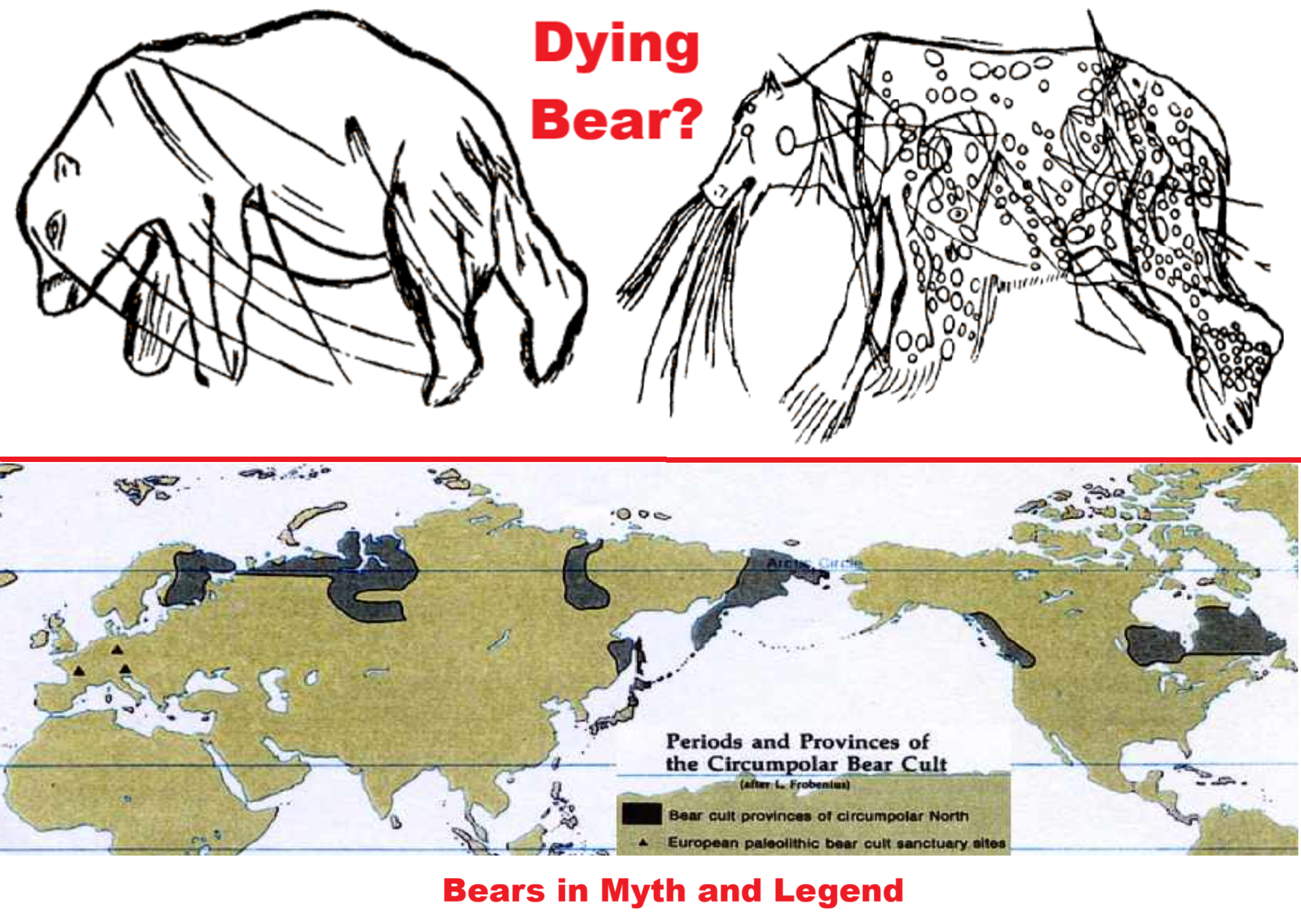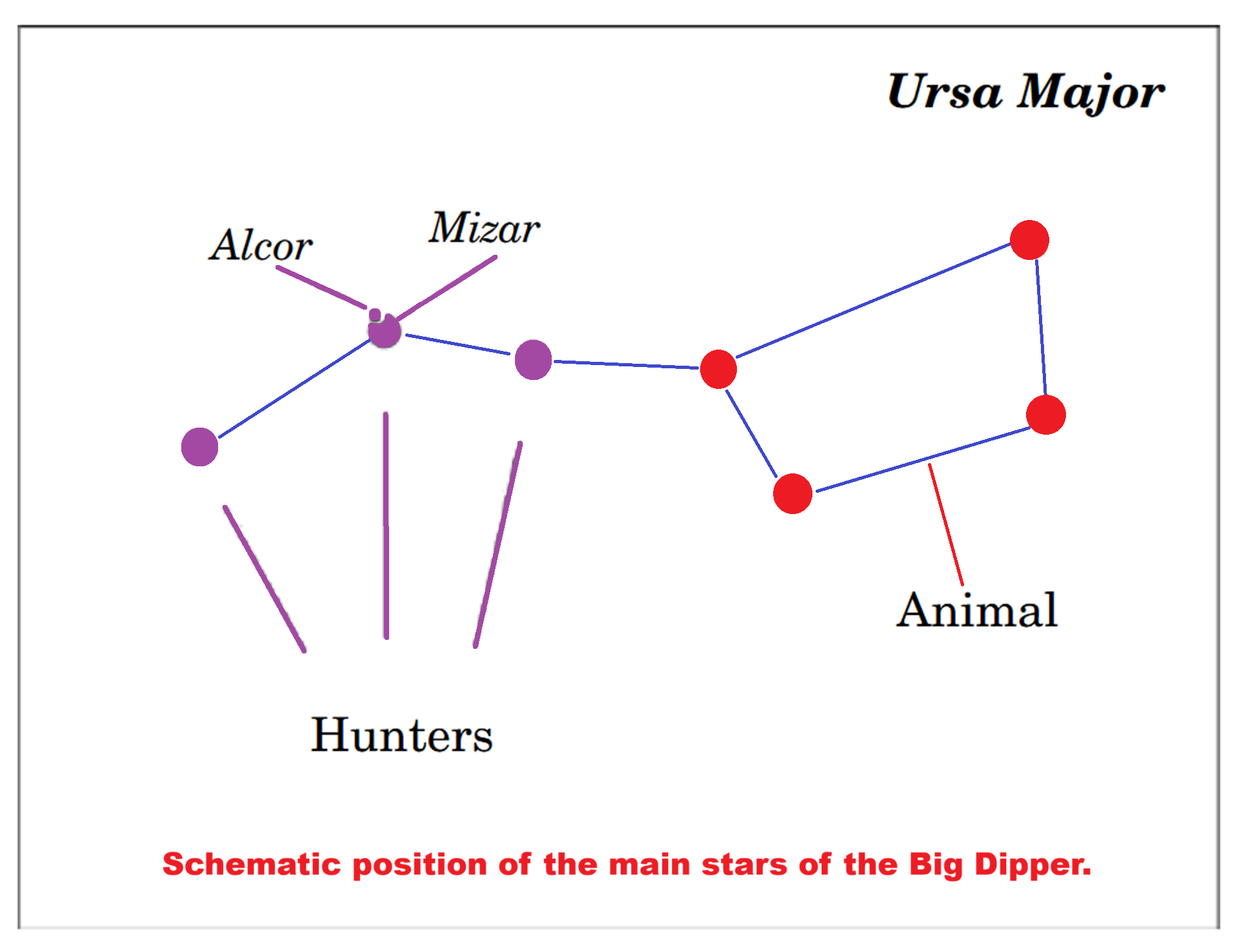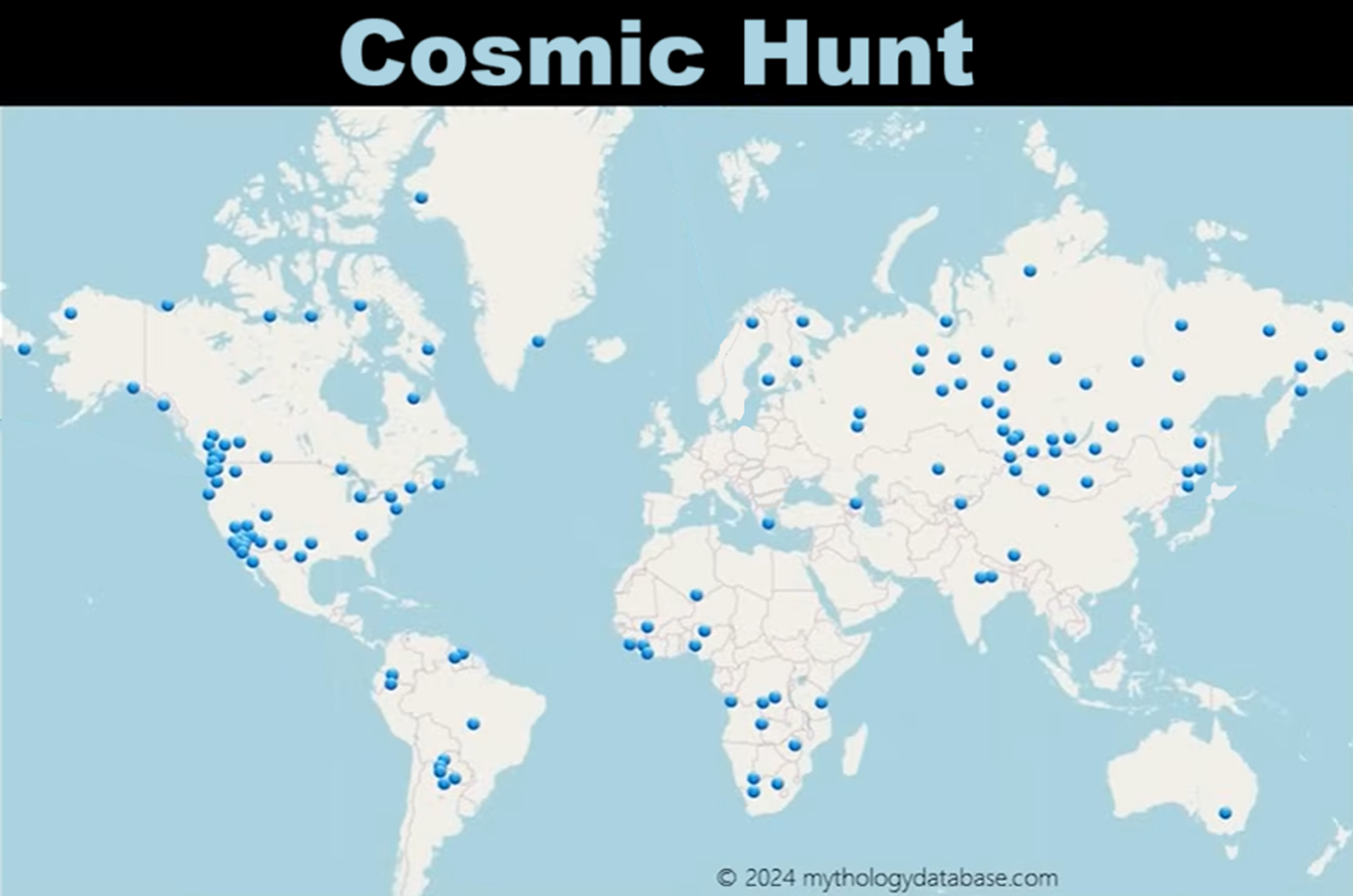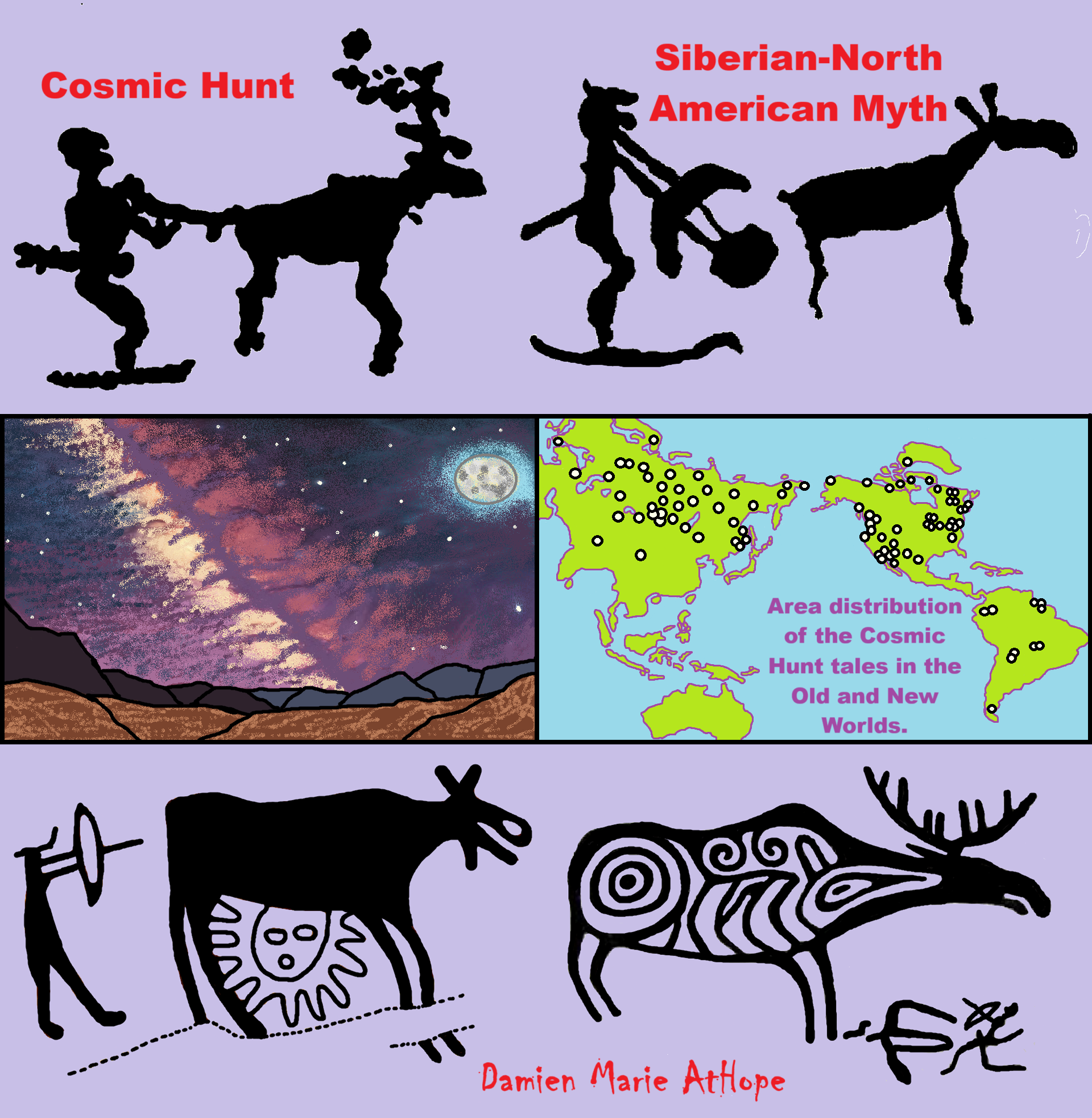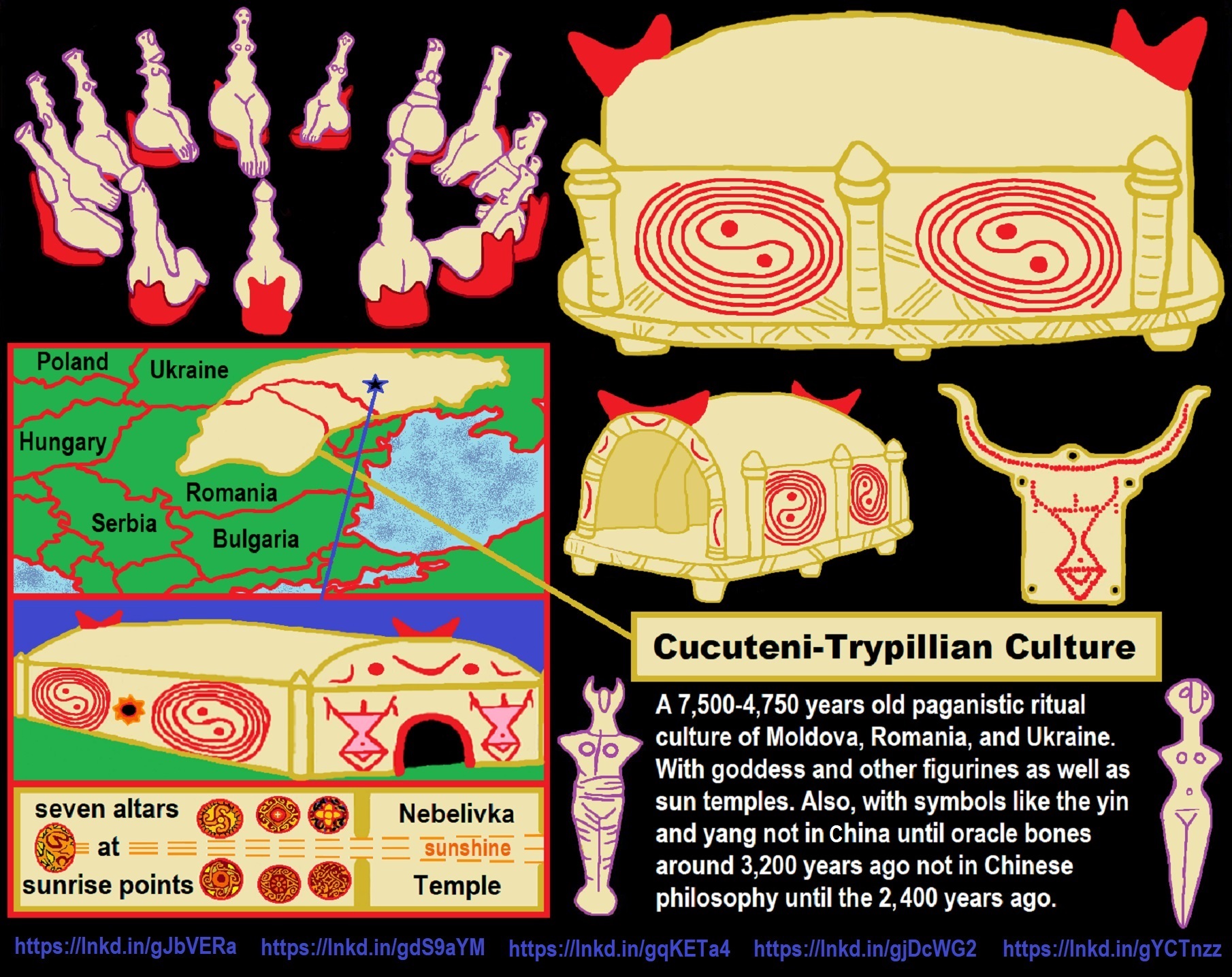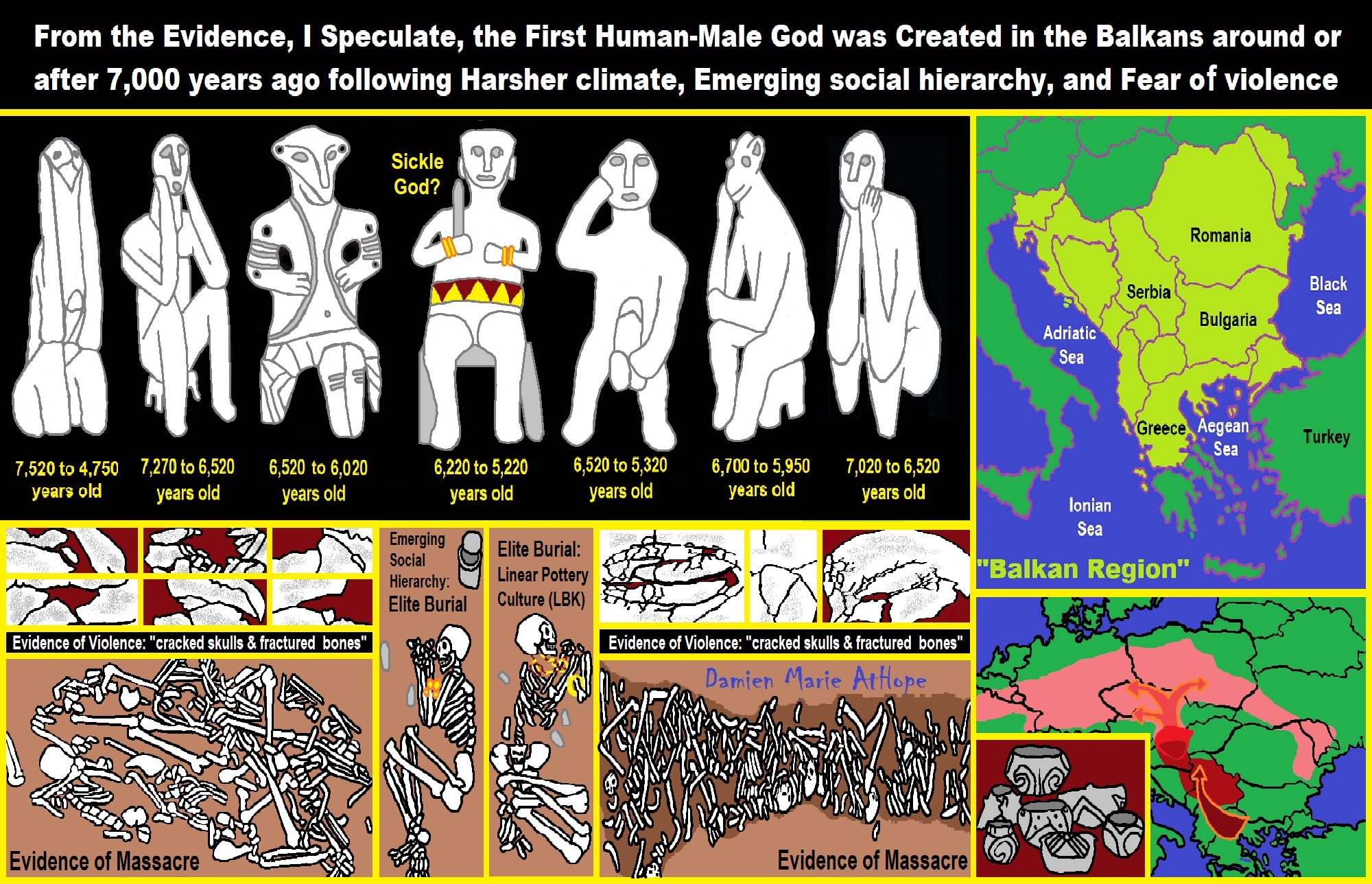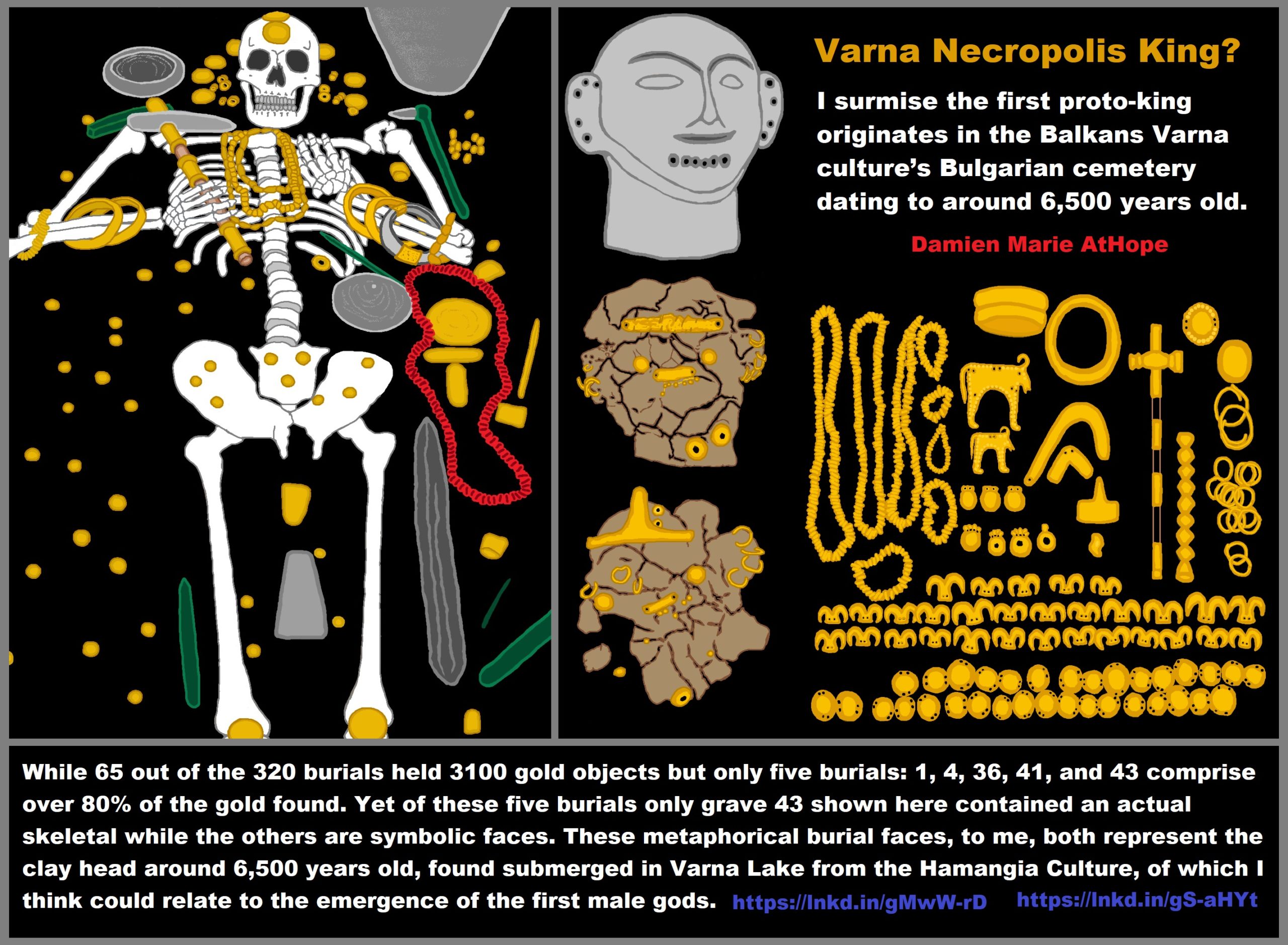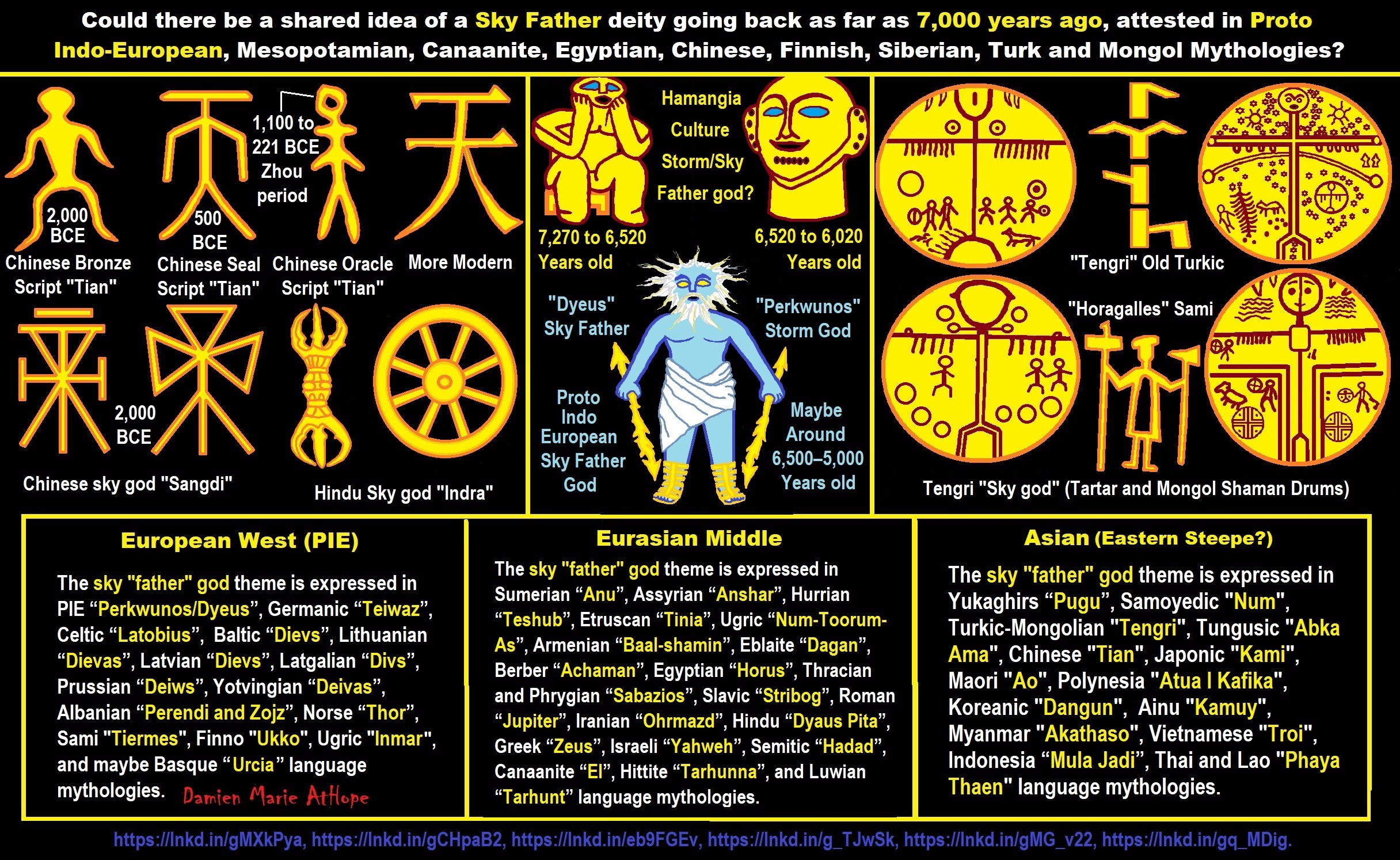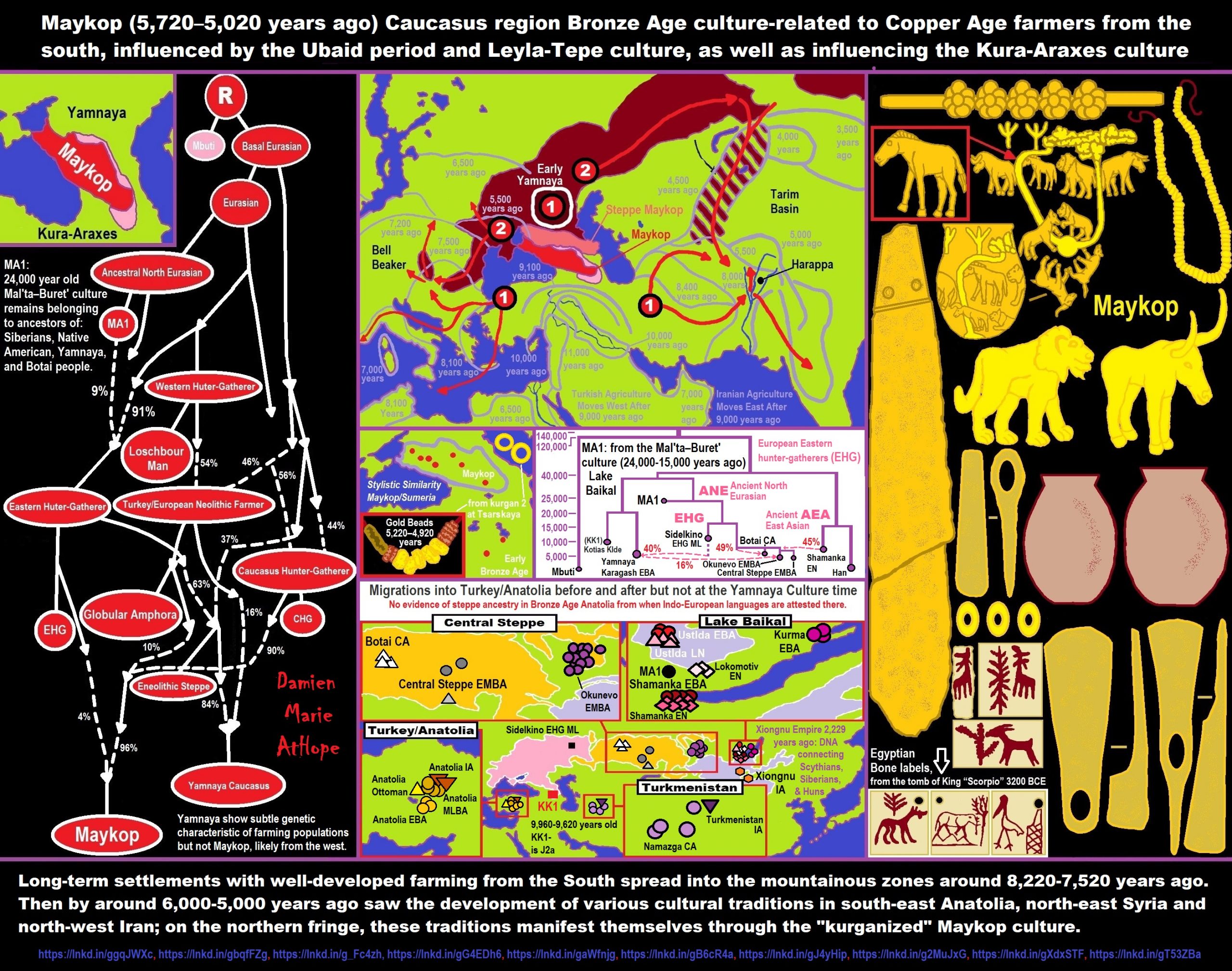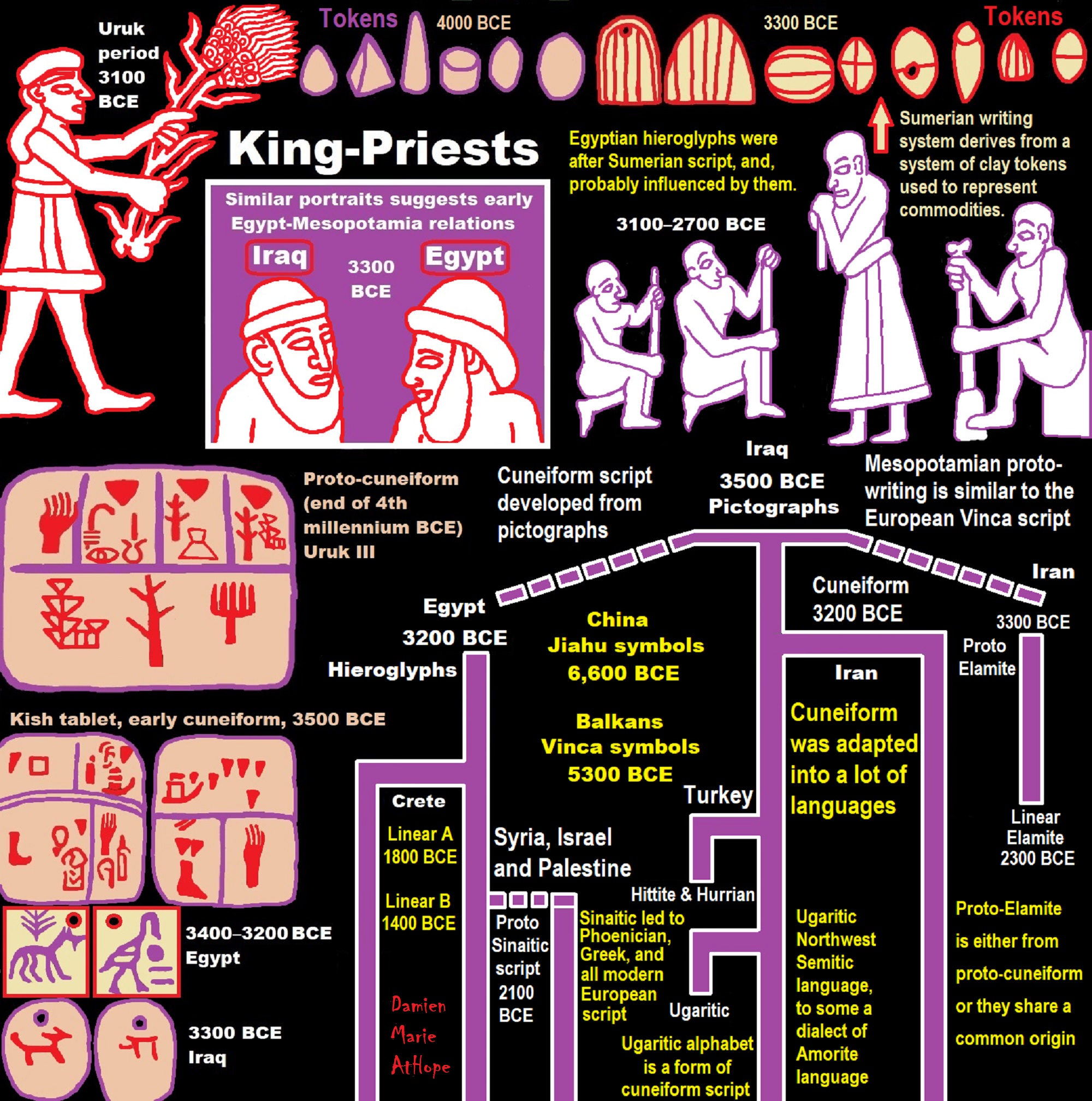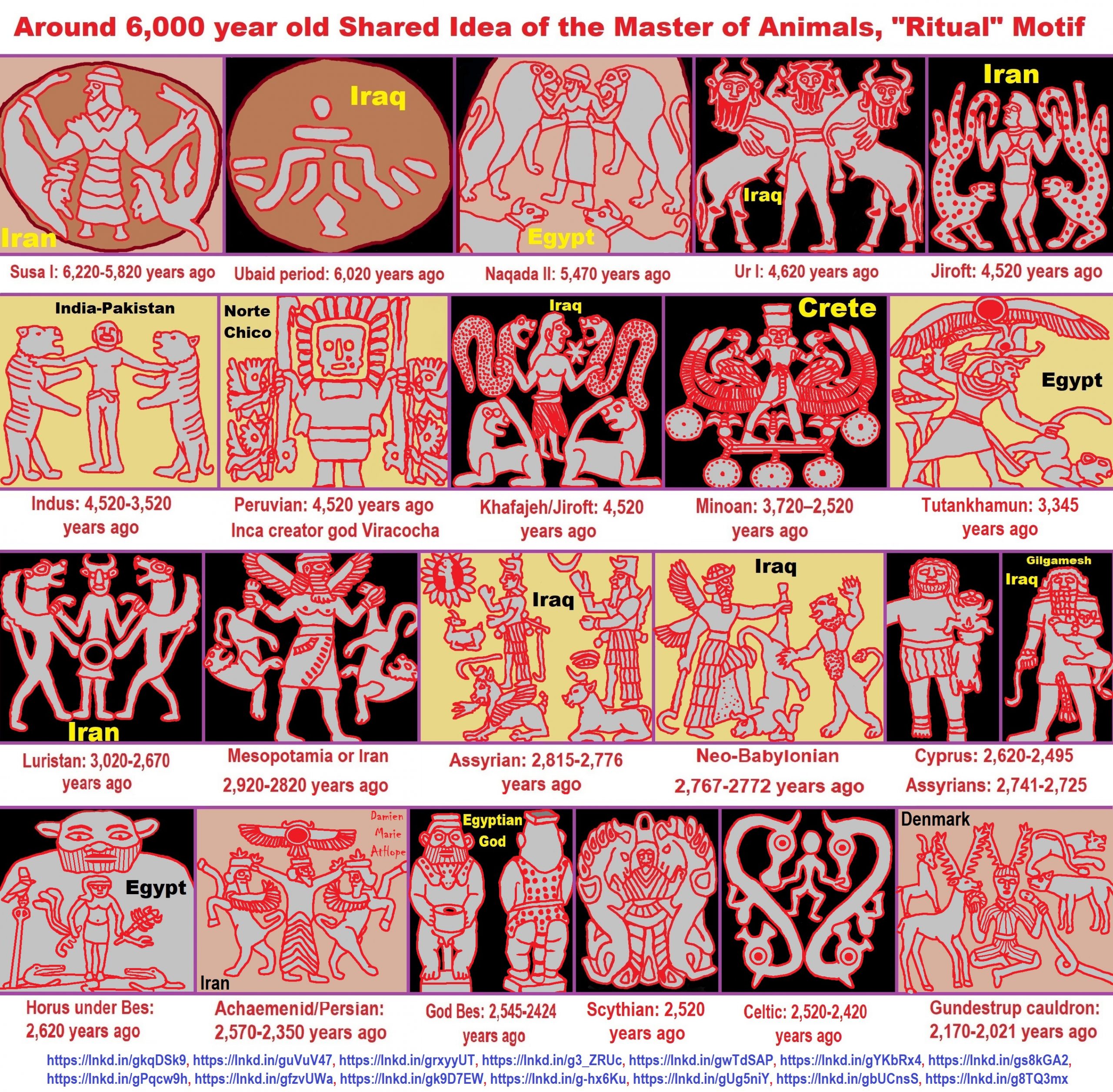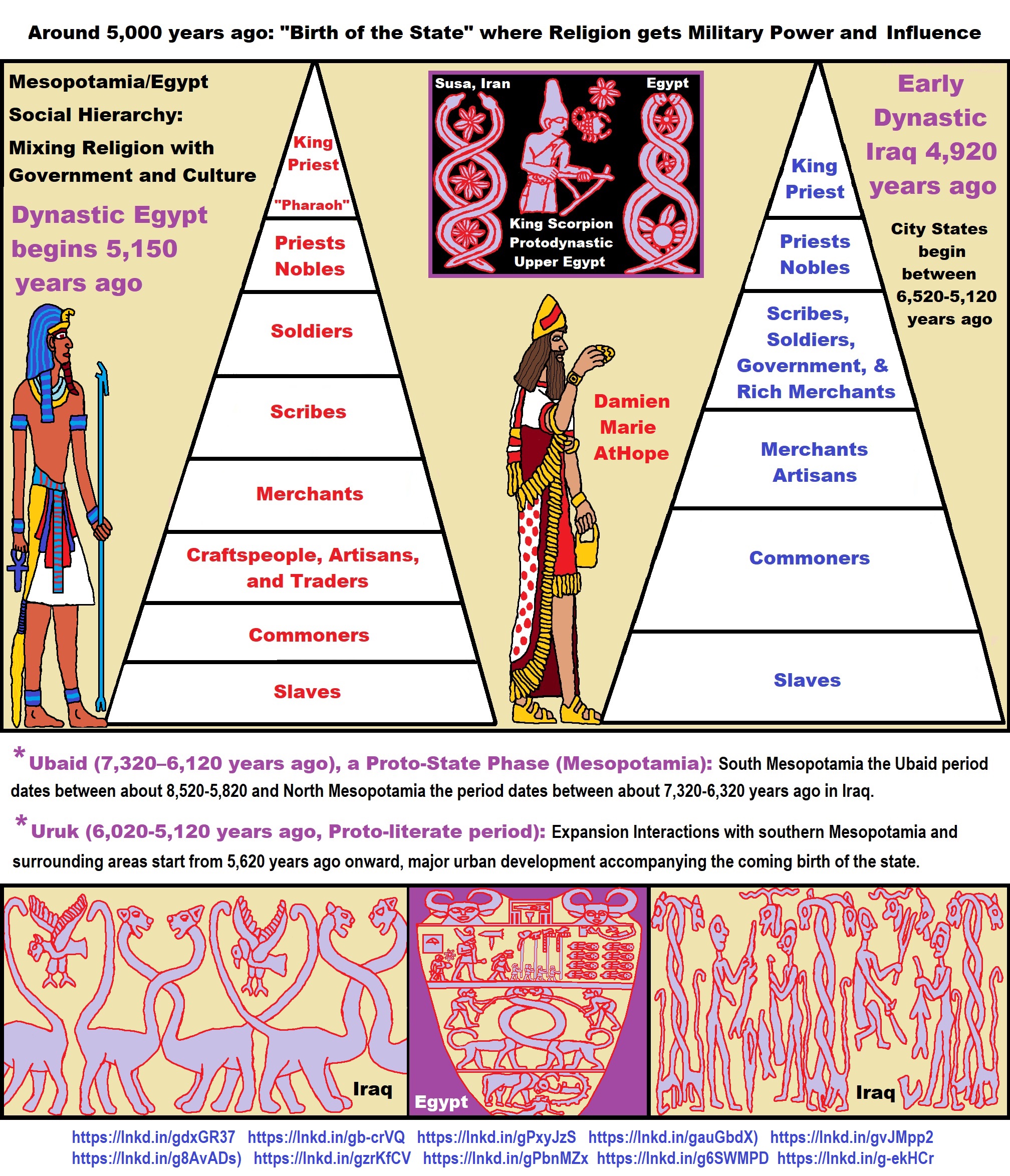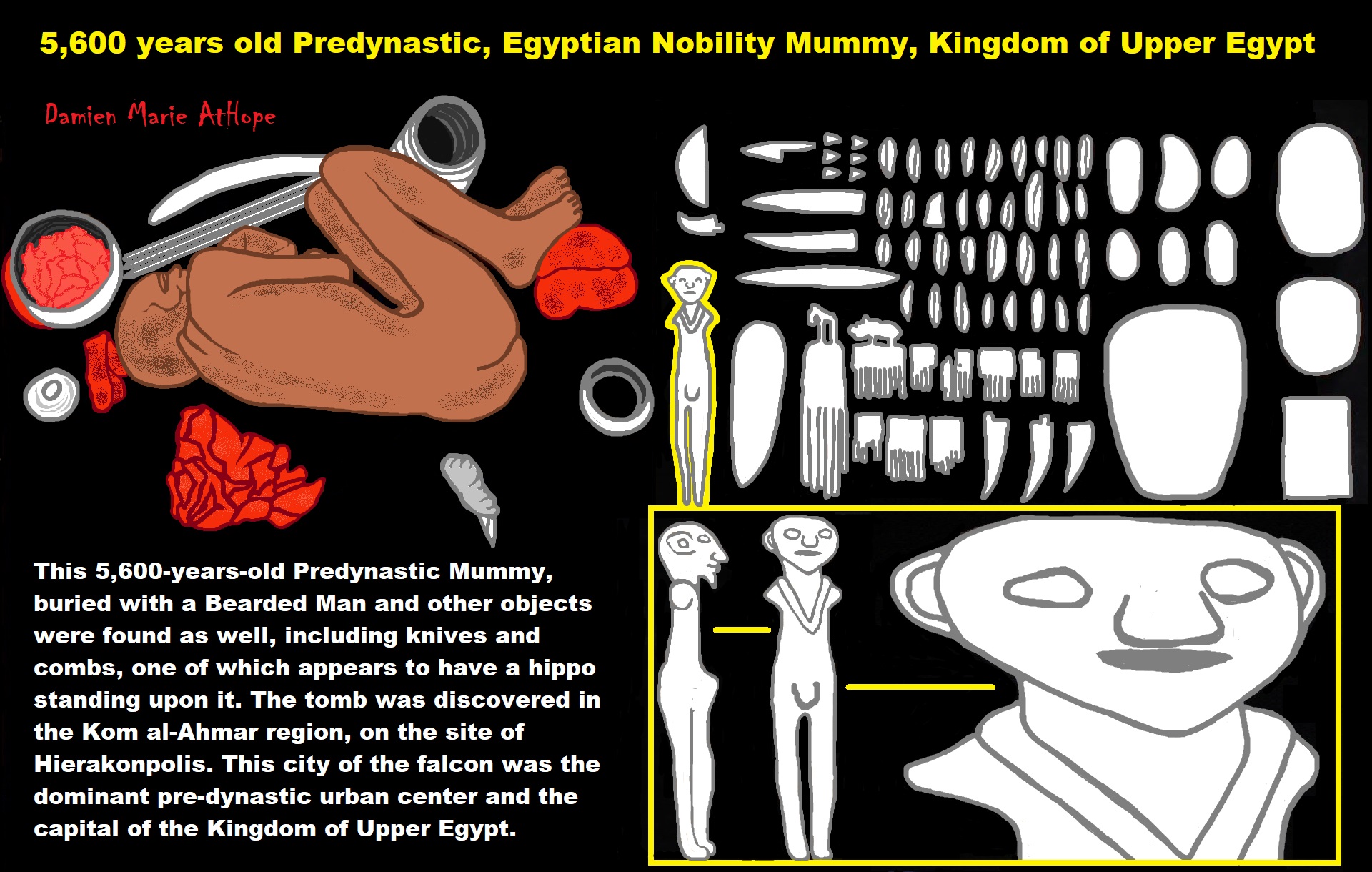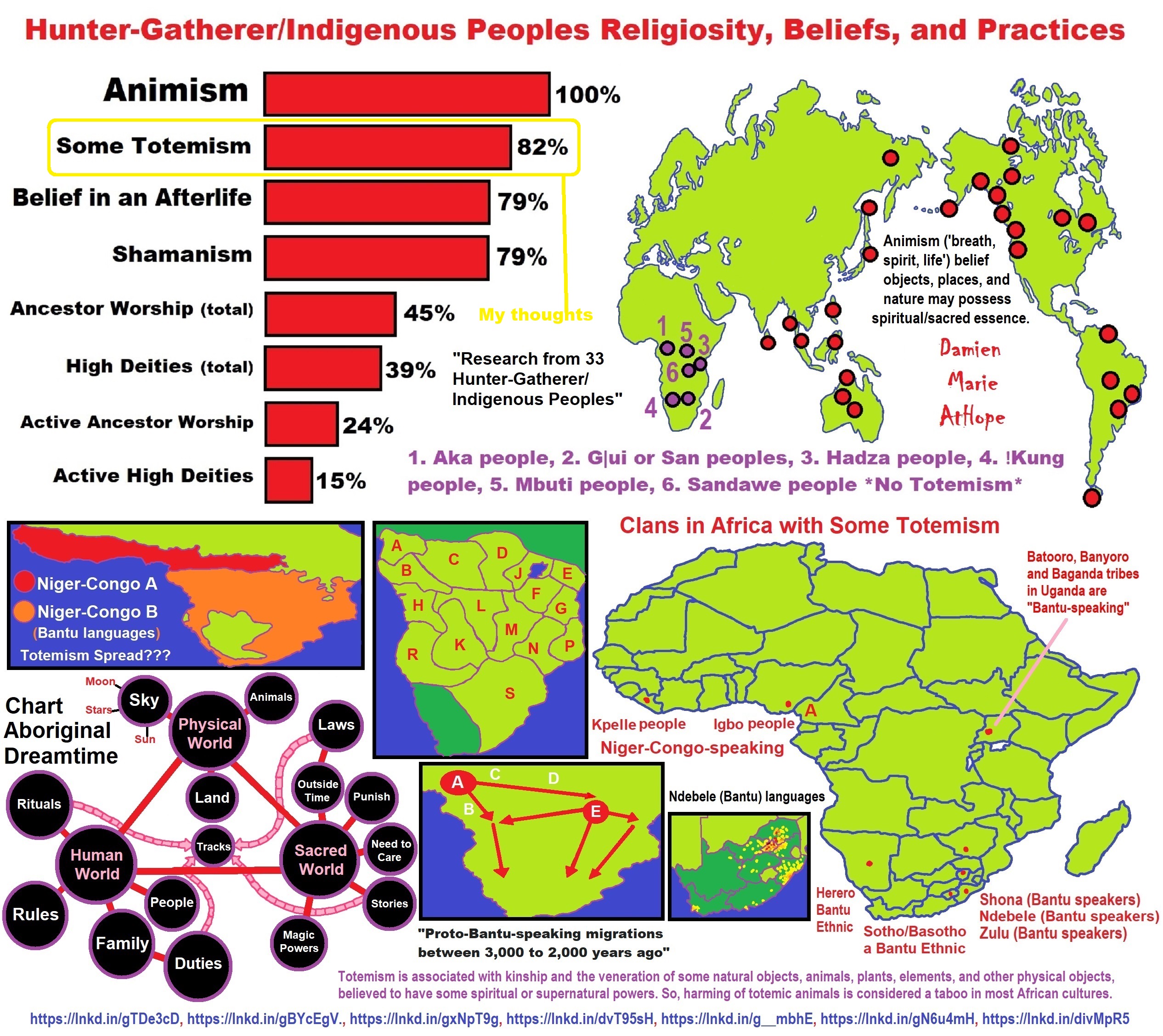
ref, ref, ref, ref, ref, ref, ref, ref, ref, ref, ref, ref, ref, ref, ref, ref, ref
“Hunting Cult” (Cosmic Hunt) becomes “Herding Cult” Paganism
“Herding societies are nearly always that of a true hierarchical chiefdom rather than of an egalitarian society. Horticulture mixed with the domestication of animals seems to have predominated until even the least cultivable zones were filled. Sometimes, a complete symbiosis between a tribe/clan of herders and an adjacent tribe/clan of horticulturalists occurs to the point that they resemble a single society composed of two specialized castes, the herders occupying the superior position. Fully committed pastoralists manifest a considerable degree of cultural uniformity in economics, social organization, political order, and even in religion. Full pastoralism, with its powerful equestrian warriors, seems to have developed around 1500 to 1000 BCE, or around 3,500 to 3,000 years ago, in Inner Asia. Herders are likely to raid settled villages and frequently raid other herders as well.” ref
“To the extent that pastoral nomadic societies achieve wealth and success in herding and in war, they tend to solidify and extend their chiefdom structure. They also add to their religious organization a hierarchical principle, together with the content known as ancestor worship. Much of the mythology by which a primitive people explains itself and its customs comes in this way to have an ingredient familiar to readers of the Old Testament. Sometimes the significance of herding leads not only to the glorification of herds and herding, but even to a religious taboo against planting. Taboos, such as a belief that plowing and planting may defile the earth spirit. Or herders, in time of need, may engage in horticulture, but it is considered degrading to toil in farming, whereas herding is a very prideful occupation.” ref
Cult, herding, and ‘pilgrimage’
1. Körtiktepe (12,000 years ago) link & link
2. Göbekli Tepe (11,500 years ago) link
3. Balıklıgöl statue “Urfa man” (11,000 years ago) link
4. Karahan Tepe (11,000 years ago) link
5. Sayburç (11,000 years ago) link
6. Nevalı Çori (10,400) link & link
7. Tell Fekheriye (11,000 years ago) link
Ganj Dareh link
Goat, Sheep, and Cattle Domestication link & link
Cosmic Hunt link
Master of Animals link
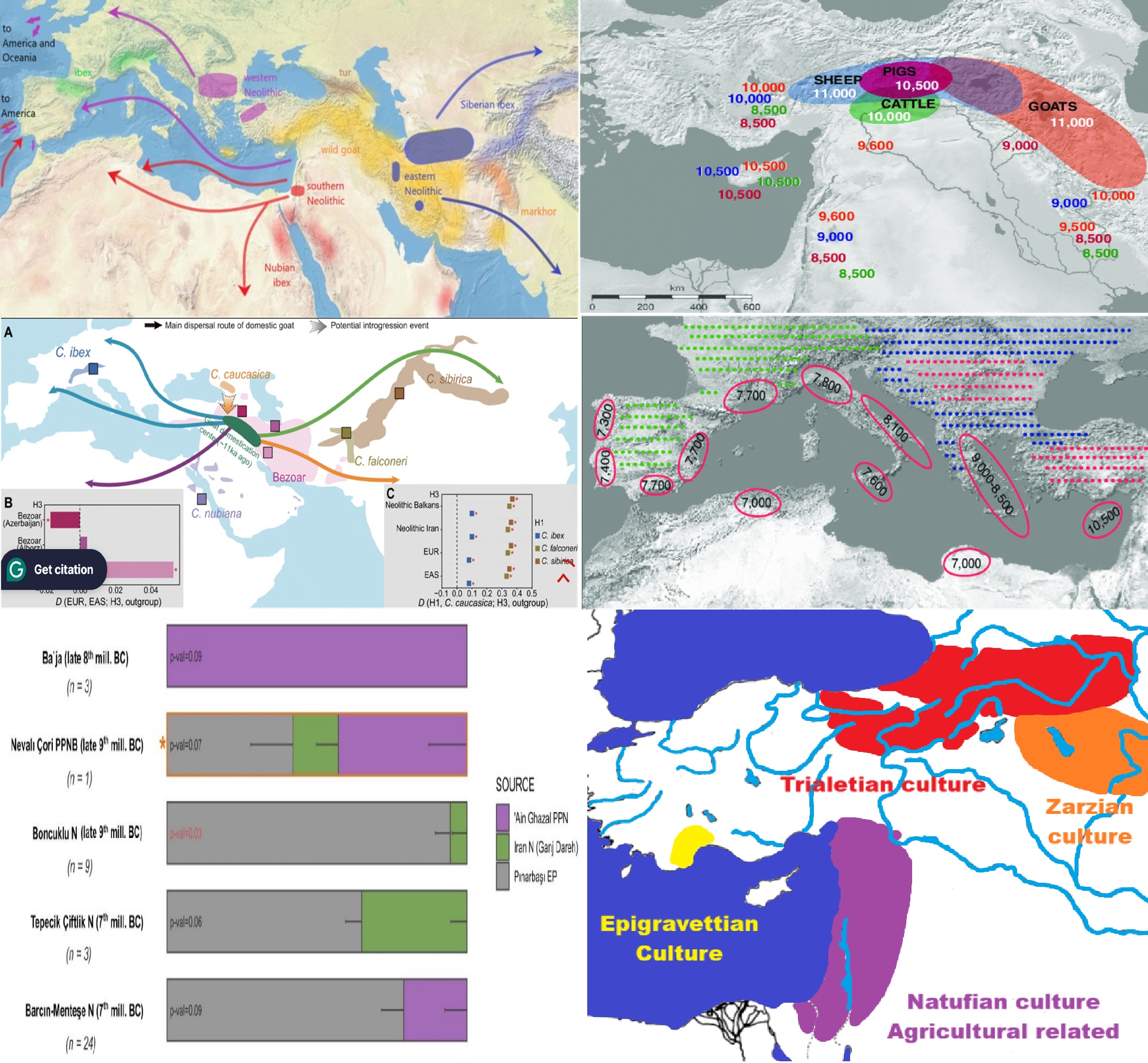
The origin of “Deities” (Sky Father/Master of Animals, a male hurding/hunting god, and Sky Mother, as seen in Earth Diver mythology, seemingly depicted together with a turtle at Nevali Cori) dates back to goat domestication 11,000 years ago, within the Trialetian culture, which is associated with R1b and also J Y-DNA haplogroups.
“The Caucasian-Anatolian area of Trialetian culture was adjacent to the Iraqi-Iranian Zarzian culture to the east and south, as well as the Levantine Natufian to the southwest. These groups were based on hunting mountain-dwelling goat-antelope “Caucasian ibex,” wild boar, and brown bear. Seen at Ali Tepe (Iran) 10,500 BCE, Cafer Hoyuk (Turkey) 8920 BCE, Hallan Çemi (Turkey) 8,600 BCE, and Nevali Çori (Turkey) 8,400 BCE.” ref
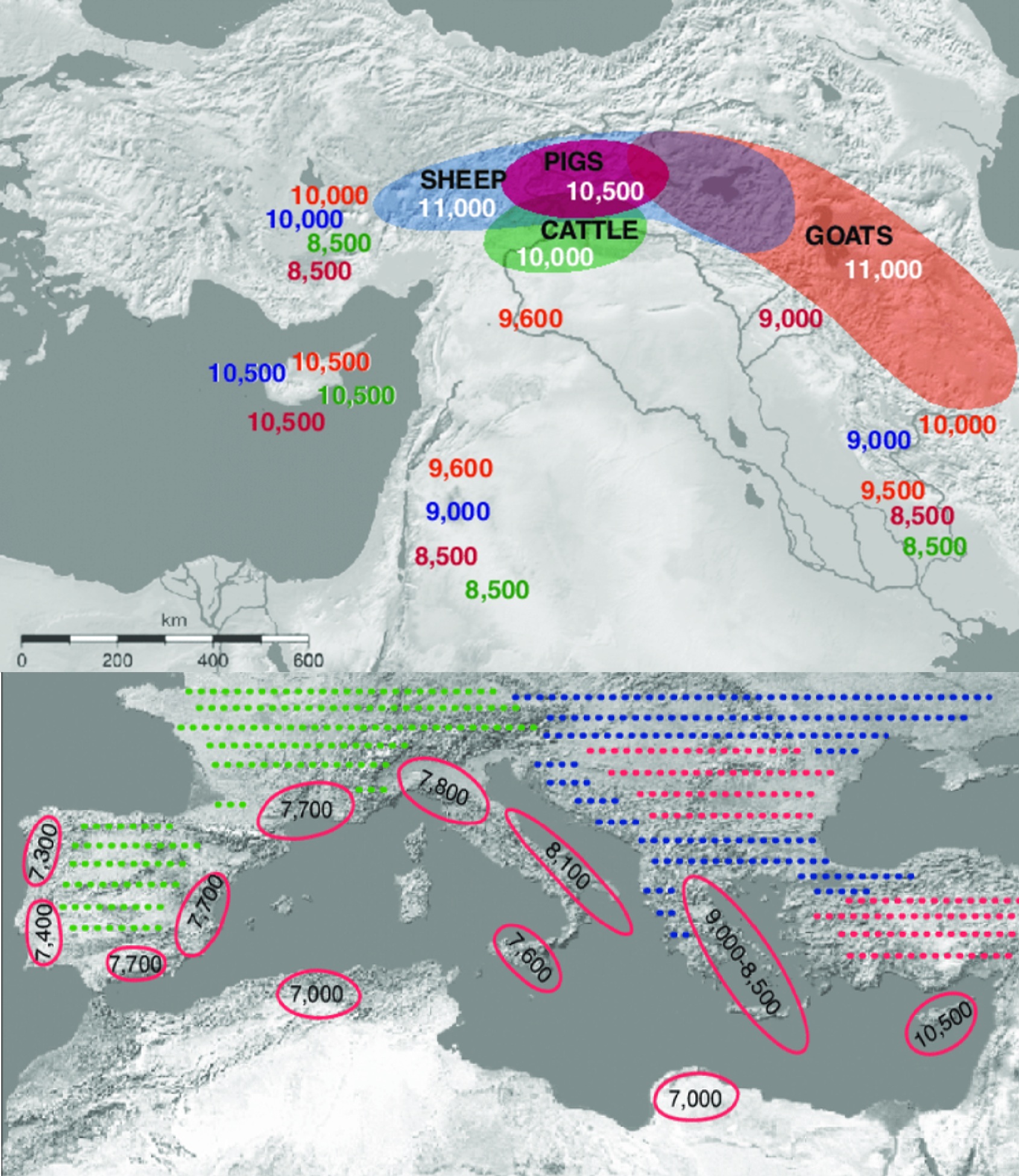
Domestication and early agriculture in the Meditrranean Basin: Origins, diffusion, and impact
“The past decade has witnessed a quantum leap in our understanding of the origins, diffusion, and impact of early agriculture in the Mediterranean Basin. In large measure these advances are attributable to new methods for documenting domestication in plants and animals. The initial steps toward plant and animal domestication in the Eastern Mediterranean can now be pushed back to the 12th millennium years ago. Evidence for herd management and crop cultivation appears at least 1,000 years earlier than the morphological changes traditionally used to document domestication. Different species seem to have been domesticated in different parts of the Fertile Crescent, with genetic analyses detecting multiple domestic lineages for each species. Recent evidence suggests that the expansion of domesticates and agricultural economies across the Mediterranean was accomplished by several waves of seafaring colonists who established coastal farming enclaves around the Mediterranean Basin. This process also involved the adoption of domesticates and domestic technologies by indigenous populations and the local domestication of some endemic species. Human environmental impacts are seen in the complete replacement of endemic island faunas by imported mainland fauna and in today’s anthropogenic, but threatened, Mediterranean landscapes where sustainable agricultural practices have helped maintain high biodiversity since the Neolithic.” ref
“The transition from foraging and hunting; to farming and herding is a significant threshold in human history. Domesticates and the agricultural economies based on them are associated with radical restructuring of human societies, worldwide alterations in biodiversity, and significant changes in the Earth’s landforms and its atmosphere. Given the momentous outcomes of this transition it comes as little surprise that the origin and spread of domesticates and the emergence of agriculture remain topics of enduring interest to both the scholarly community and the general public. The past decade has seen remarkable analytical advances in documenting domestication (1), particularly in tracking the domestication of four major Near Eastern livestock species (sheep, goats, cattle, and pigs) and their subsequent dispersal throughout the Mediterranean Basin. New morphometric methods are tracking changes in human prey strategies that mark the transition from hunting to herding.” ref
“Genetic analyses bring fresh insights into initial livestock domestication and their dispersal. Small-sample atomic mass spectrometry radiocarbon dating provides refined chronological frameworks for these developments. These recent analytical advances, in turn, have produced an explosion of new information that is calling into question prevailing hypotheses about the origin and early spread of animal domesticates and the Neolithic lifeways of which they were a part. Here, the researcher brings together these different sources of information to consider the origins, diffusion, and impacts of domesticates and agriculture in the Mediterranean Basin, outlining our current understanding of these developments and highlighting promising areas for future study.” ref
“Archaeological assemblages from Iraq and Iran has identified the clear signature of a managed herd of goats (harvesting of young males and prolonged survivorship of females) at the site of Ganj Dareh in highland Iran. Directly dated to 9,900 years ago, the goats from this site show no evidence of size reduction or any other domestication-induced morphological change. Smaller body size and changes in the size and shape of horns [a morphological change clearly linked to domestication] appear 500–1,000 years later than this demographic shift, when managed animals were moved from the natural habitat of wild goats and introduced into hotter and more arid lowland Iran. These follow-on morphological changes likely reflect responses to new selective pressures, plus the now more limited opportunities for introgression between managed and wild animals or the restocking of herds with wild animals.” ref
“Clear-cut morphological responses to domestication (i.e., changes in horns in bovids and tooth size in pigs) are not evident in these four livestock species until ca. 9,500–9,000 years ago. As is the case with animal domestication in the Near East, the leading edge of plant domestication in the region is now recognized as an extended process. Evidence from multiple locations points to a prolonged period of human manipulation of morphologically wild, but possibly cultivated, plants, which, in certain species, resulted in the development of morphologically altered domesticated crops. This period of intensified plant management dates at least as far back as ca. 12,000 years ago, with morphological markers of crop domestication (i.e., nonshattering seed heads in cereals) not well established until ca. 10,500 years ago. Agricultural economies reliant on a mix of domesticated crops and livestock apparently do not fully crystallize in the region until ca. 9,500–9,000 years ago.” ref
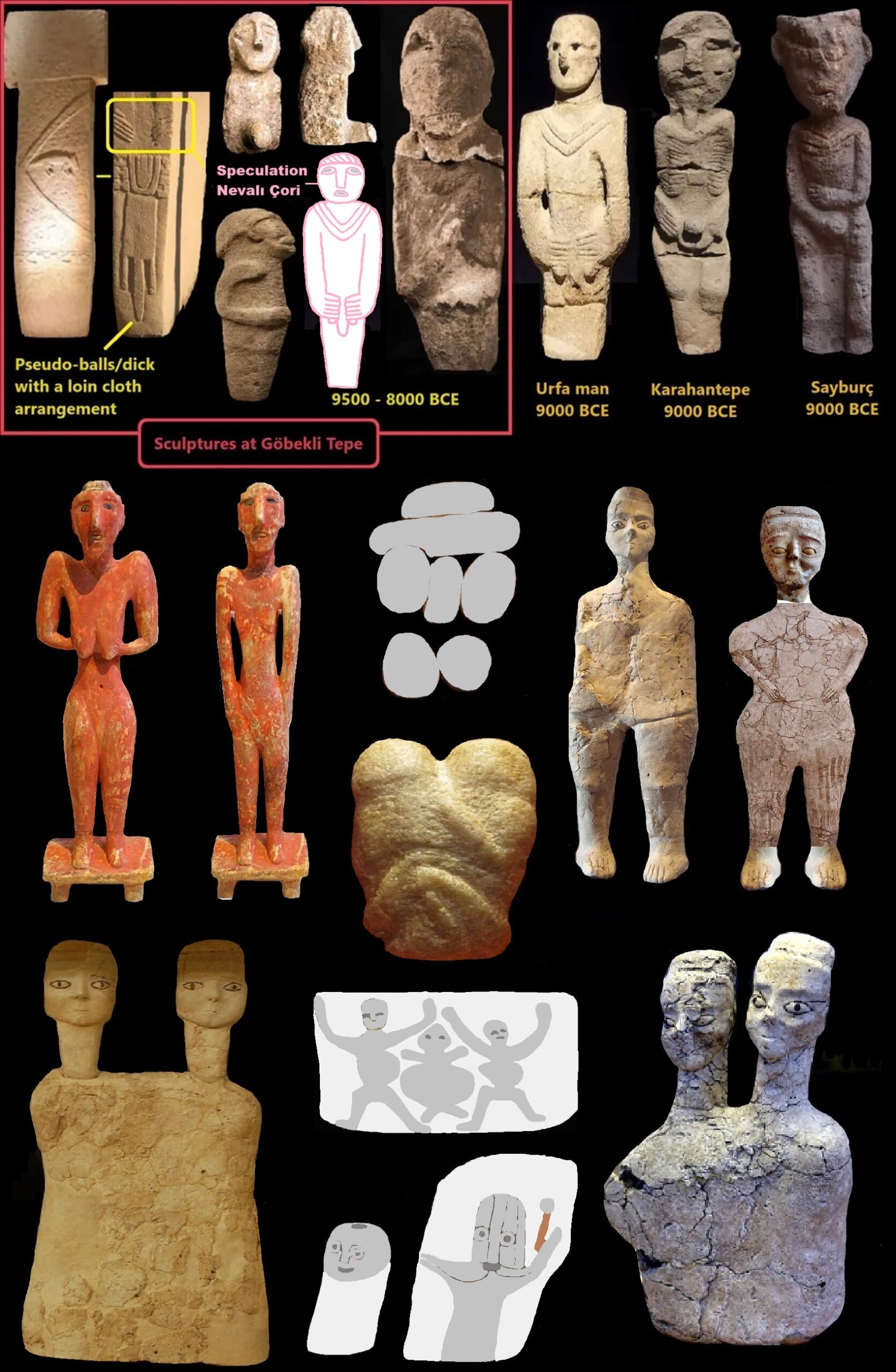
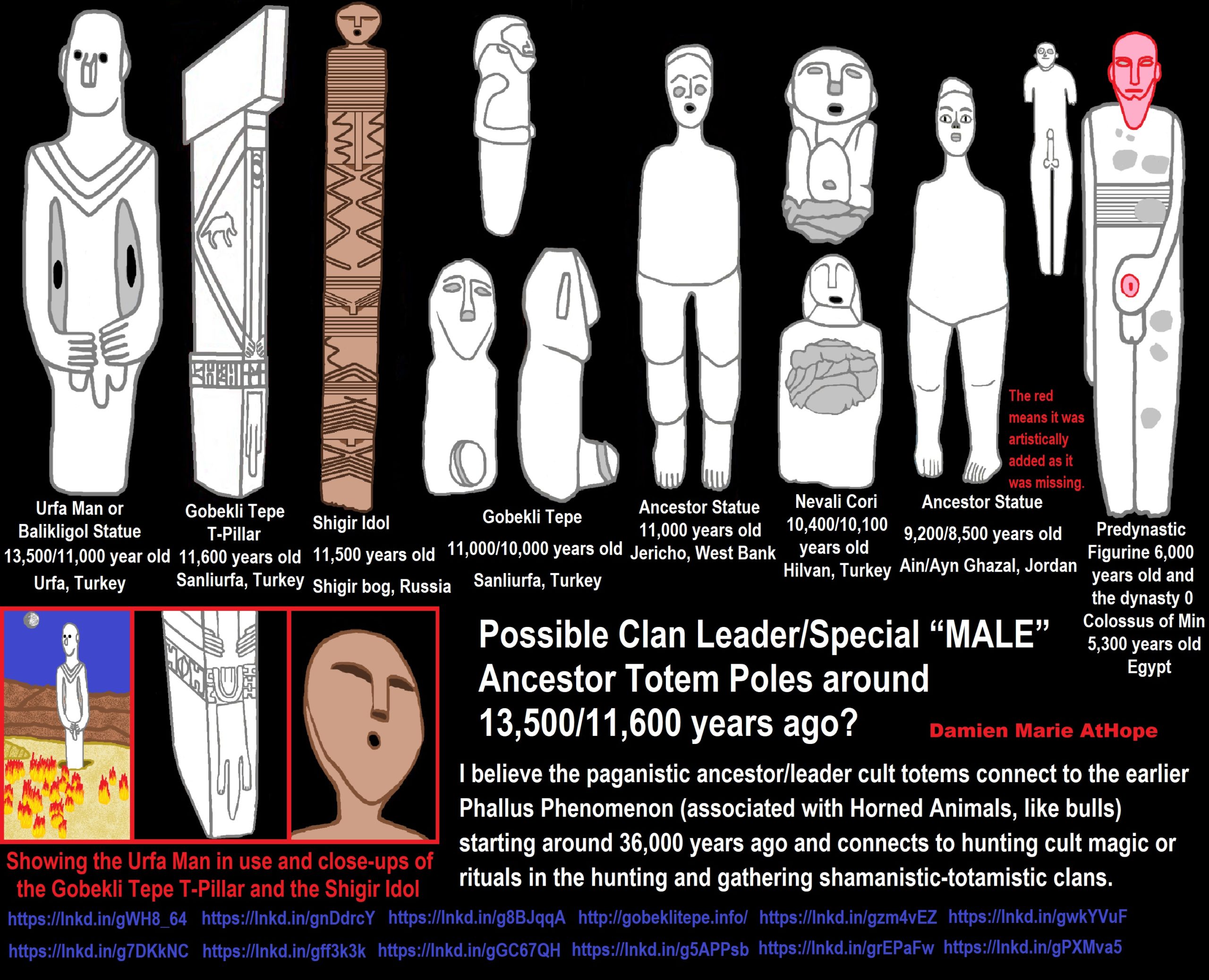
ref, ref, ref, ref, ref, ref, ref, ref, ref, ref, ref, ref, ref
I believe the paganistic ancestor/leader cult totems connect to the earlier Phallus Phenomenon (associated with Horned Animals, like bulls) starting around 36,000 years ago and connects to hunting cult magic or rituals in the hunting and gathering shamanistic-totamistic clans.

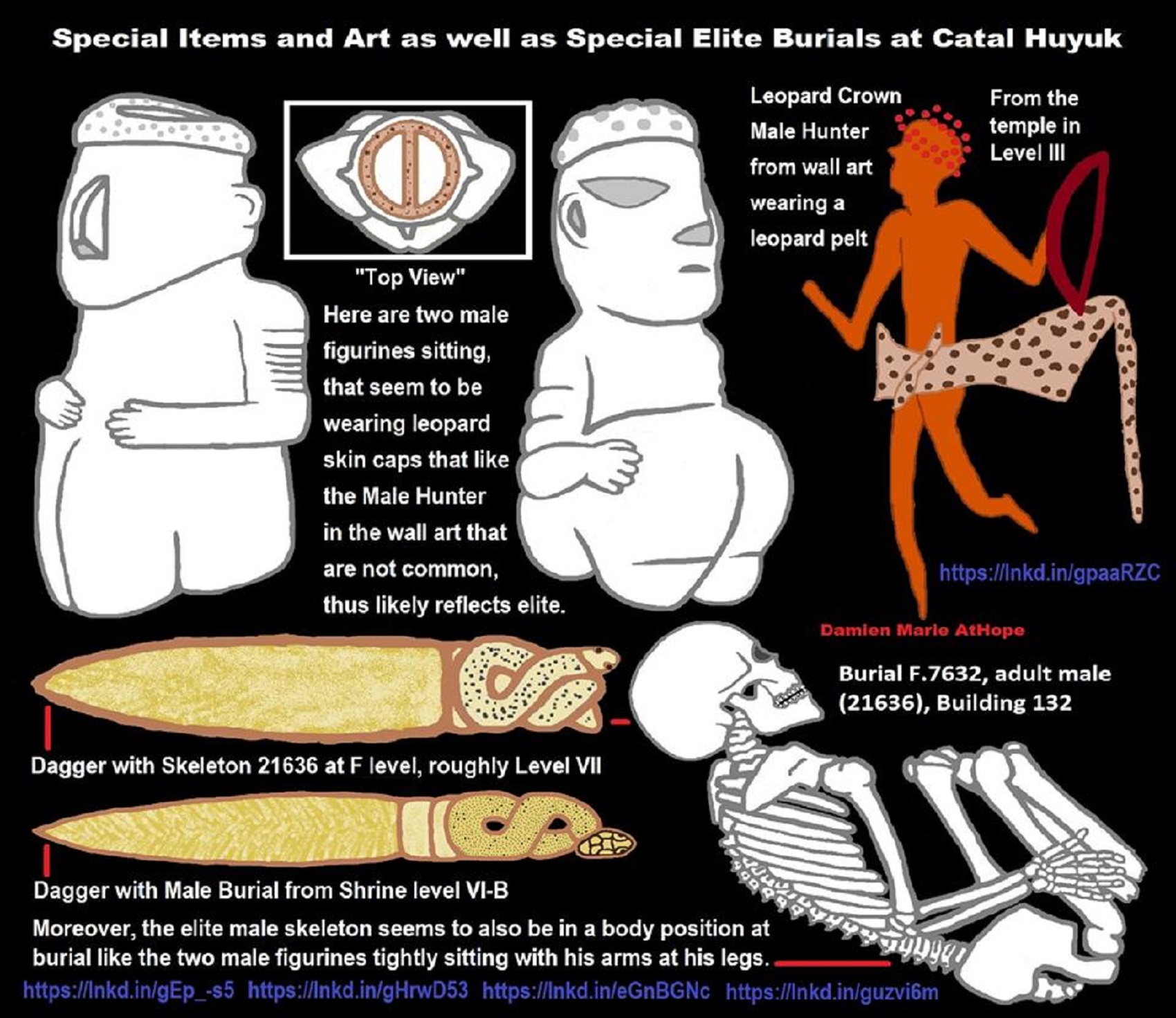
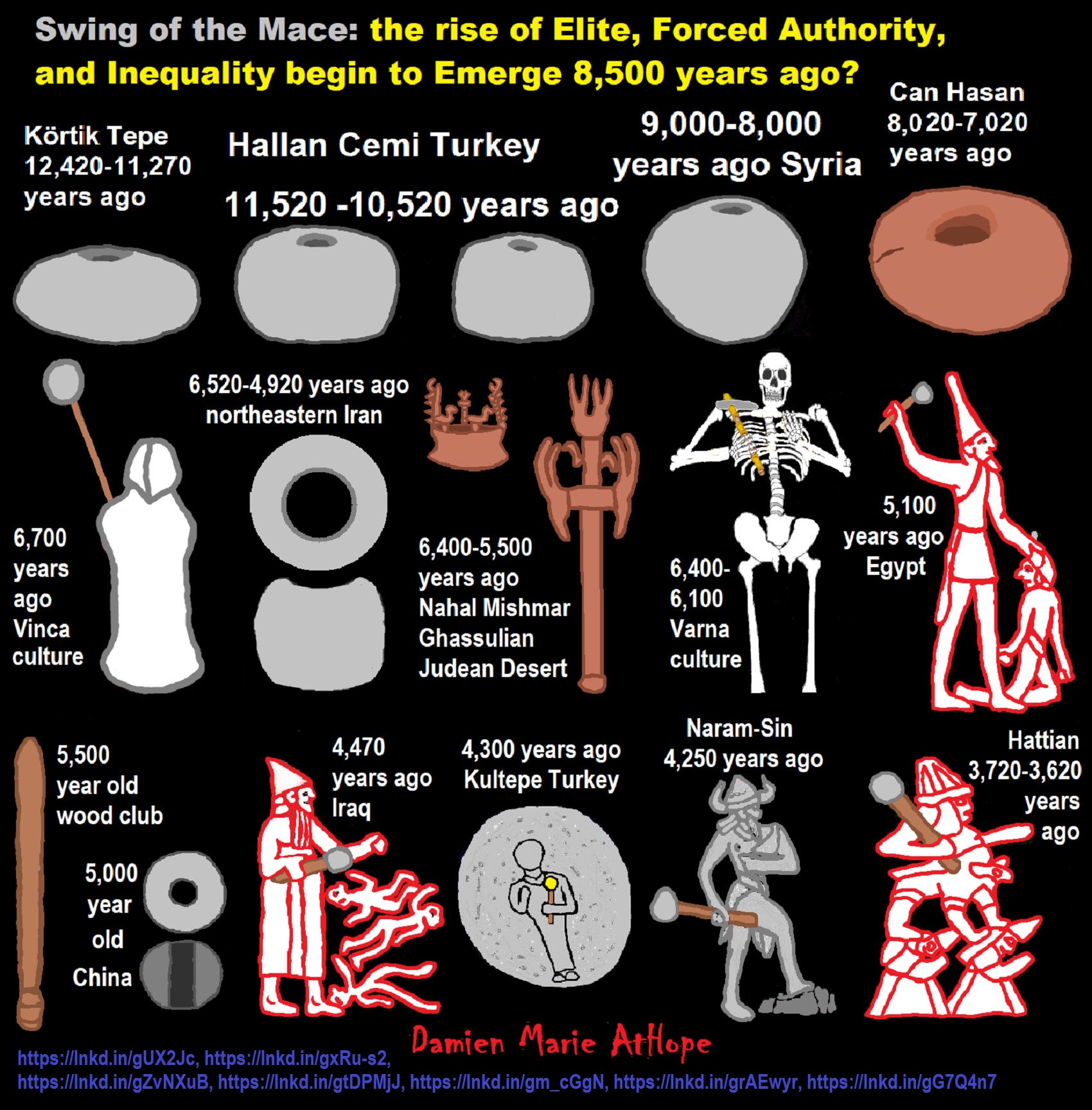
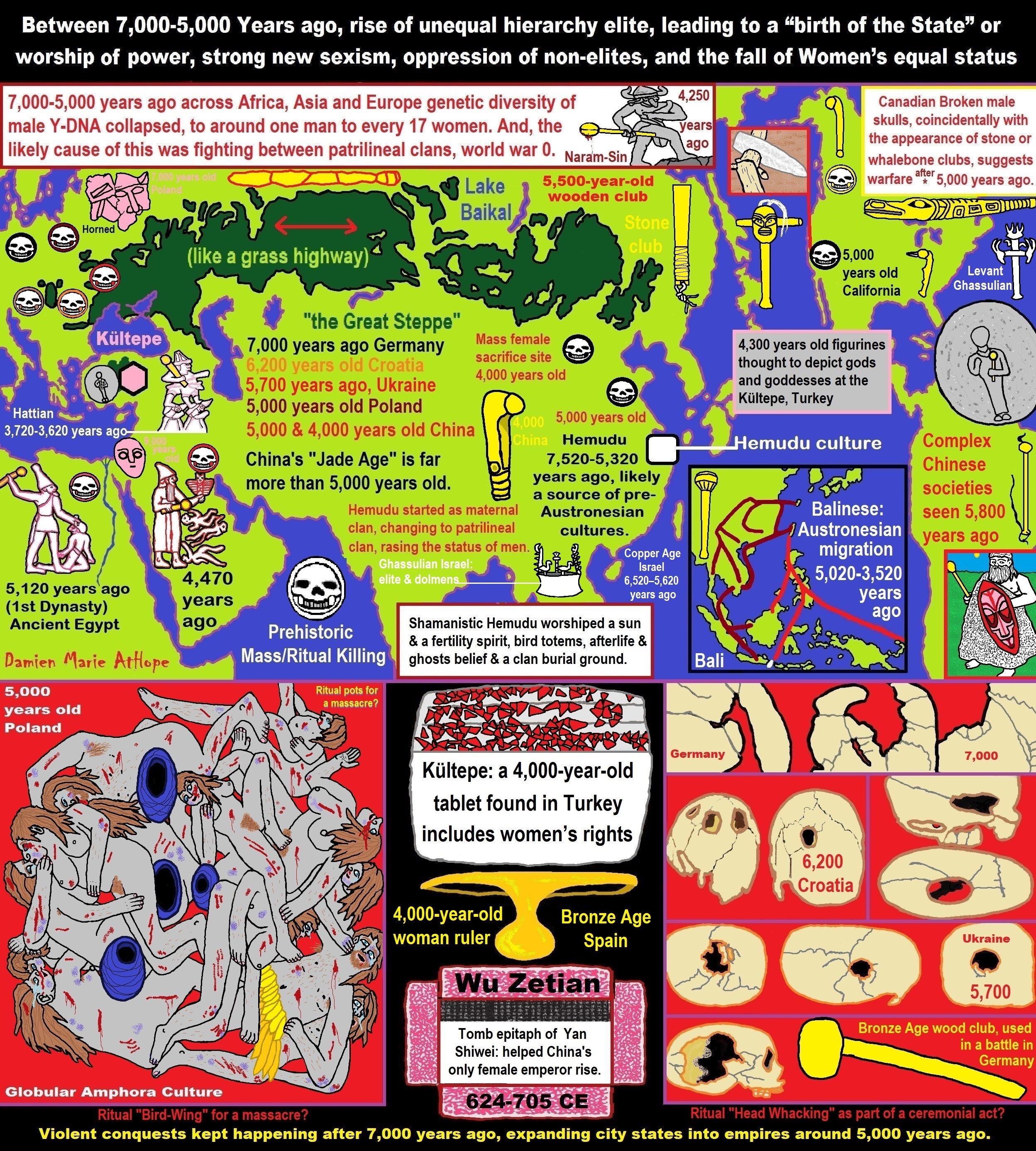
ref, ref, ref, ref, ref, ref, ref, ref, ref, ref, ref, ref, ref, ref, ref, ref, ref, ref, ref, ref, ref, ref, ref, ref, ref, ref, ref, ref, ref, ref, ref, ref, ref, ref, ref, ref, ref, ref, ref, ref, ref, ref, ref, ref, ref, ref, ref, ref, ref, ref, ref, ref, ref, ref, ref, ref, ref, ref, ref, ref, ref, ref, ref, ref, ref, ref, ref, ref, ref, ref, ref, ref, ref, ref, ref, ref, ref, ref, ref, ref, ref, ref, ref, ref, ref, ref, ref, ref, ref, ref

The Mesopotamian “Bull of Heaven”
“In ancient Mesopotamian mythology, the Bull of Heaven is a mythical beast fought by the King of Uruk, Gilgamesh. The story of the Bull of Heaven is known from two different versions: one recorded in an earlier Sumerian poem and a later episode in the Standard Babylonian (a literary dialect of Akkadian) Epic of Gilgamesh. In the Sumerian poem, the Bull is sent to attack Gilgamesh by the goddess Inanna for reasons that are unclear. In the Sumerian poem Gilgamesh and the Bull of Heaven, Gilgamesh and Enkidu slay the Bull of Heaven, who has been sent to attack them by the goddess Inanna, the Sumerian equivalent of Ishtar. The plot of this poem differs substantially from the corresponding scene in the later Akkadian Epic of Gilgamesh. In the Sumerian poem, Inanna does not seem to ask Gilgamesh to become her consort as she does in the later Akkadian epic. Furthermore, while she is coercing her father An to give her the Bull of Heaven, rather than threatening to raise the dead to eat the living as she does in the later epic, she merely threatens to let out a “cry” that will reach the earth.” ref
“The more complete Akkadian account comes from Tablet VI of the Epic of Gilgamesh, in which Gilgamesh refuses the sexual advances of the goddess Ishtar, the East Semitic equivalent of Inanna, leading the enraged Ishtar to demand the Bull of Heaven from her father Anu, so that she may send it to attack Gilgamesh in Uruk. Anu gives her the Bull, and she sends it to attack Gilgamesh and his companion, the hero Enkidu, who slay the Bull together. Numerous depictions of the slaying of the Bull of Heaven occur in extant works of ancient Mesopotamian art. Representations are especially common on cylinder seals of the Akkadian Empire (c. 2334 – 2154 BCE or 4,334 to 4,154 years ago). These show that the Bull was clearly envisioned as a bull of abnormally large size and ferocity. It is unclear exactly what the Bull of Heaven represents, however. Assyriologists Jeremy Black and Anthony Green observe that the Bull of Heaven is identified with the constellation Taurus and argue that the reason why Enkidu hurls the bull’s thigh at Ishtar in the Epic of Gilgamesh after defeating it may be an effort to explain why the constellation seems to be missing its hind quarters.” ref
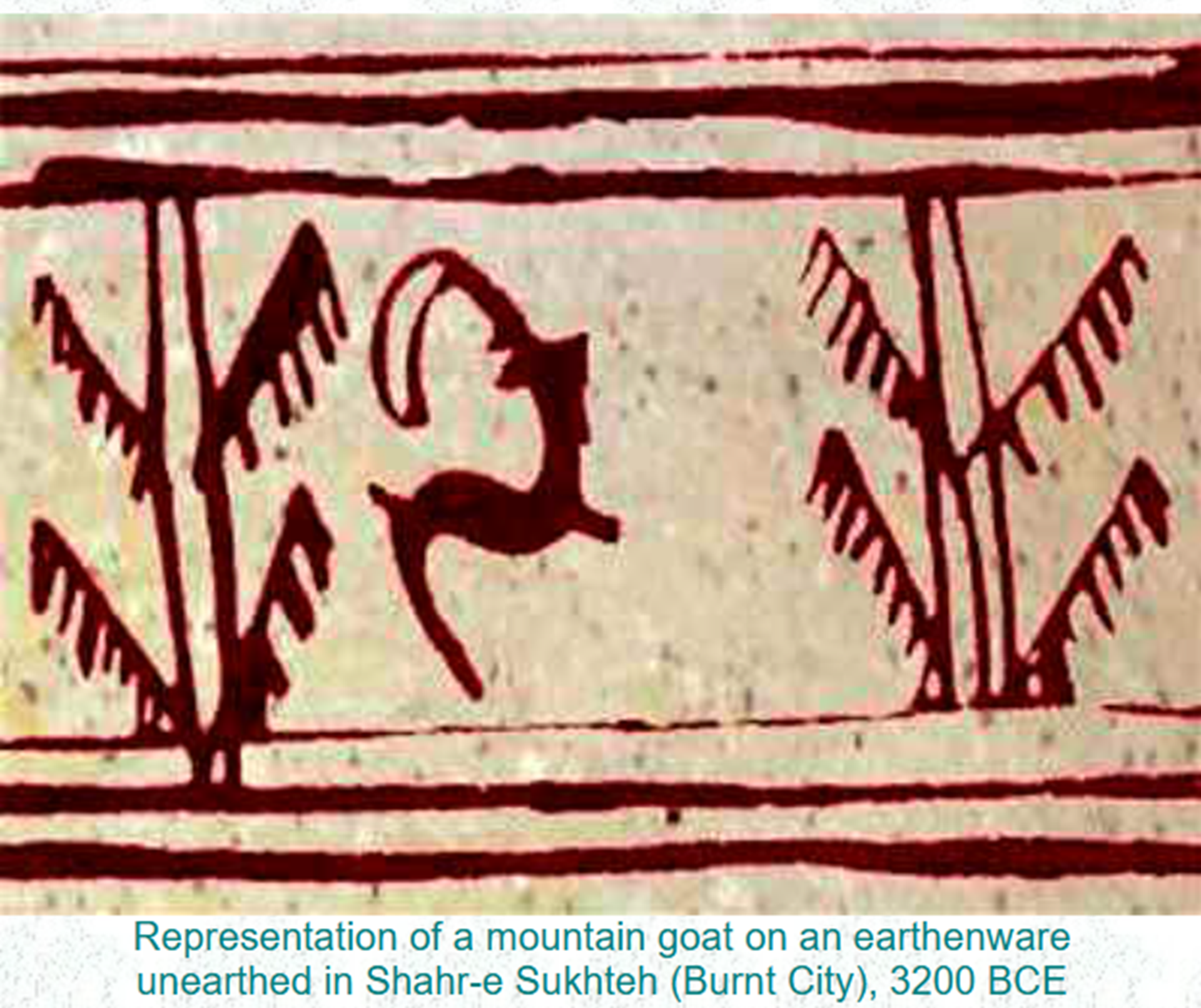
The Mountain Goat; Symbol of Rain In Iranian Pottery
“The designs drawn by the Iranians, especially drawings of Iran’s national animal, the mountain goat, have been infused with the spirit of simplicity and precision. These designs are unique in all of Asia. The prehistoric man lived in constant fear and anxiety. He feared the satanic force, and needed a stimulant to help him defend himself from this wicked force. That is the reason why he resorted to talismans, charms, and totems to the point of worshipping them. Studying prehistoric man’s creations, helps us discover his interest in exhibiting what they considered as the manifestations of the gods that they worshipped. For example, drawings of the sun, and the animals related to the sun, such as the eagle, lion, cow, deer, and the mountain goat, can be seen on pottery dating back to the 4th millennium BCE People wore necklaces with pendants of mountain goats, especially among Cassy tribes in Lorestan. These people needed a defender because they believed that, since time immemorial, hurricanes, floods, wild animals, etc. had threatened man, his home, livestock, and crops. Because they wanted to be safe, they began worshipping the gods and goddesses, or objects and animals which they presumed the gods and goddesses liked. Sometimes only one of the animal’s limbs or organs was drawn on pottery. For example, in the pottery made during the period between 3,000 to 4,000 BCE, there are drawings of the horns of cows, deer, and mountain goats, or the wings and claws of birds, together with geometrical designs. Each ancient tribe considered the mountain goat to be the symbol of one of the natural, beneficial elements. For example, in Lorestan, it symbolized the sun. Sometimes it symbolized the rain because in ancient times the moon was related to the rain, and the sun was related to the heat and dryness. There was also a relationship between the mountain goat’s twisted horns and the crescent – shaped moon.” ref
“That is why it was believed that the mountain goat’s twisted horns could bring about rainfall. In ancient Susa and Elam, the mountain goat was the symbol of prosperity and the god of vegetation. In Mesopotamia, the mountain goat symbolized the “Great god’s” bestial nature (The Great god appeared in the role of the god of plants, holding a tee branch in his hand, while the mountain goat ate its leaves). Prehistoric men had an astonishing skill in making pottery. They made the best types of pottery by hand, and by using the potter’s wheel. In these artifacts, they have demonstrated all aspects of their lives, such as their religion, mores and art. By studying these creations, we come to know the relationship between different civilizations. These ancient people, had great skill in depicting horned animals. Maybe the transformation of gods into different drawings of animals, is one of the reasons why animals were considered sacred, and why they became an interesting topic for the works of ancient artists and potters. Most of the prehistoric pottery were first designed with geometrical and decorative designs. Drawings of animals became common after some time, and after that, geometric shapes became widespread once again. This transformation is seen in most of the prehistoric Persian civilizations. The mountain goat motif emerges in different historical periods. In excavations of many hills, archeologists have discovered vessels bearing the same motif. Here, we shall refer to some of these instances: The Sialk Hill Civilization, in Kashan, lasted from the fifth millennium to the first millennium BCE The hill has six ancient layers, each layer containing distinct types of pottery and other artifacts. Flowers and trees such as the sunflower, and the ‘Tree of Life’ (The Sacred Tree), drawn in between the goat’s horns, are very interesting. The sunflower symbolized the sun, and was considered to be sacred.” ref
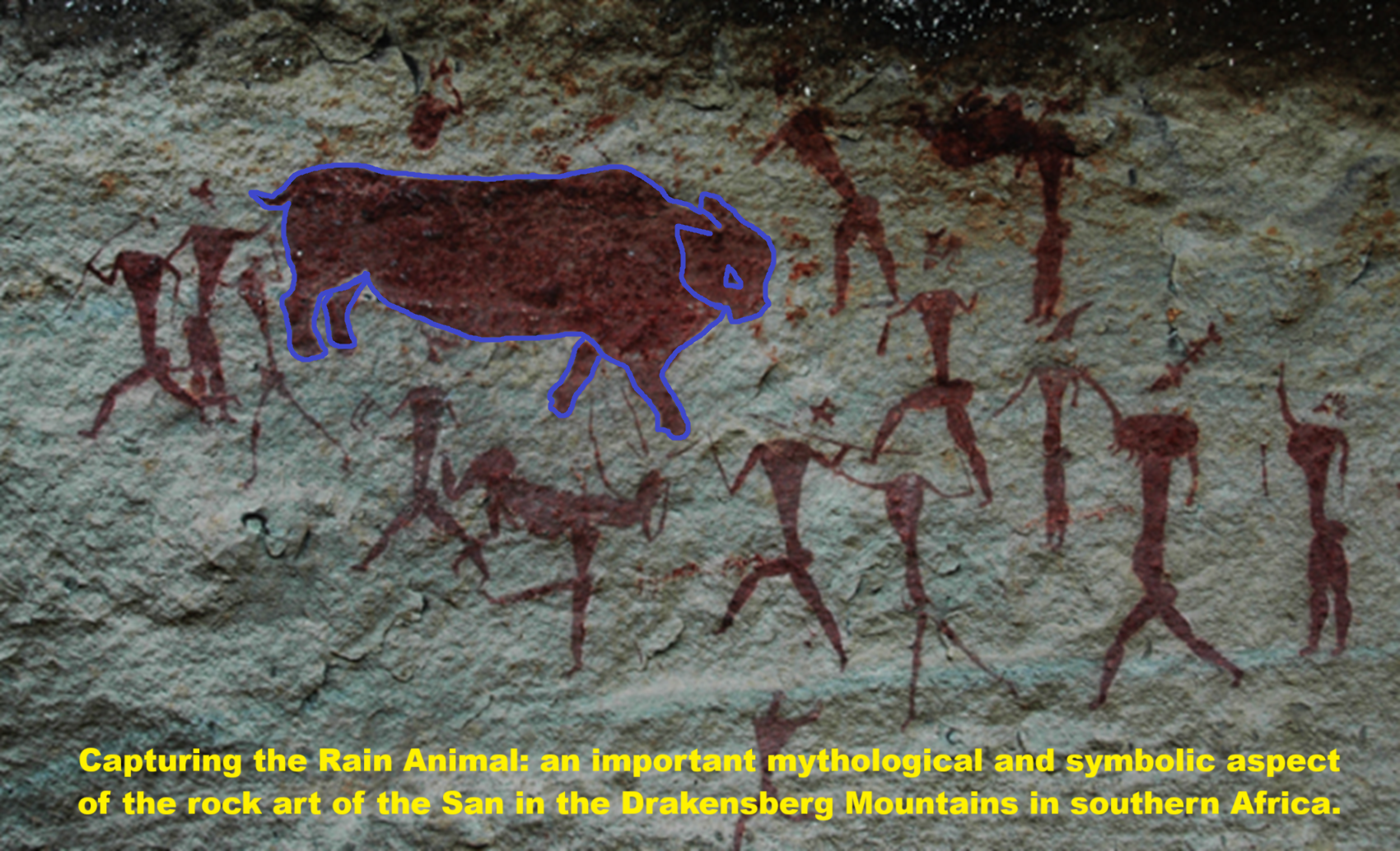
Rain Bull
“Capturing the Rain Animal: an important mythological and symbolic aspect of the rock art of the San in the Drakensberg Mountains in southern Africa. With more than 500,000 rock art sites, Africa is the world’s greatest repository of ancient rock art. Of Africa’s many rock art traditions, the San – or Bushman – rock art of the Drakensberg Mountains in southern Africa is one of the finest. Some of its images have details only the width of a hair, and its delicately shaded colours fade seamlessly from white through pink to dark red. For decades, researchers believed that San rock paintings were simply a record of daily life or a primitive form of hunting magic. But by linking specific San beliefs to recurrent features in the art, researchers such as Patricia Vinnicombe and David Lewis-Williams managed to crack the fundamental codes underlying San rock art, revealing a complex and sophisticated form of symbolic art. One aspect of this is capturing the rain animal.” ref
Rain-making was one of the San shamans’ most important tasks. The southern San thought of the rain as an animal. A male rain-animal, or rain-bull, was associated with the frightening thunderstorm that bellowed, stirred up the dust, and sometimes killed people with its lightning. The female rain animal was associated with soft, soaking rains. For the San, rain was life. When it fell, tubers that had lain hidden beneath the parched land sprang up, and the veld was renewed. Then antelopes were attracted to the new grass and bushes. Columns of falling rain were called the rain’s legs, while wisps of cloud were known as the rain’s hair; mist was said to be rain’s breath. When the San did a rain dance, they would go into a trance to capture one of these animals. In their trance, they would kill it, and its blood and milk became the rain.” ref
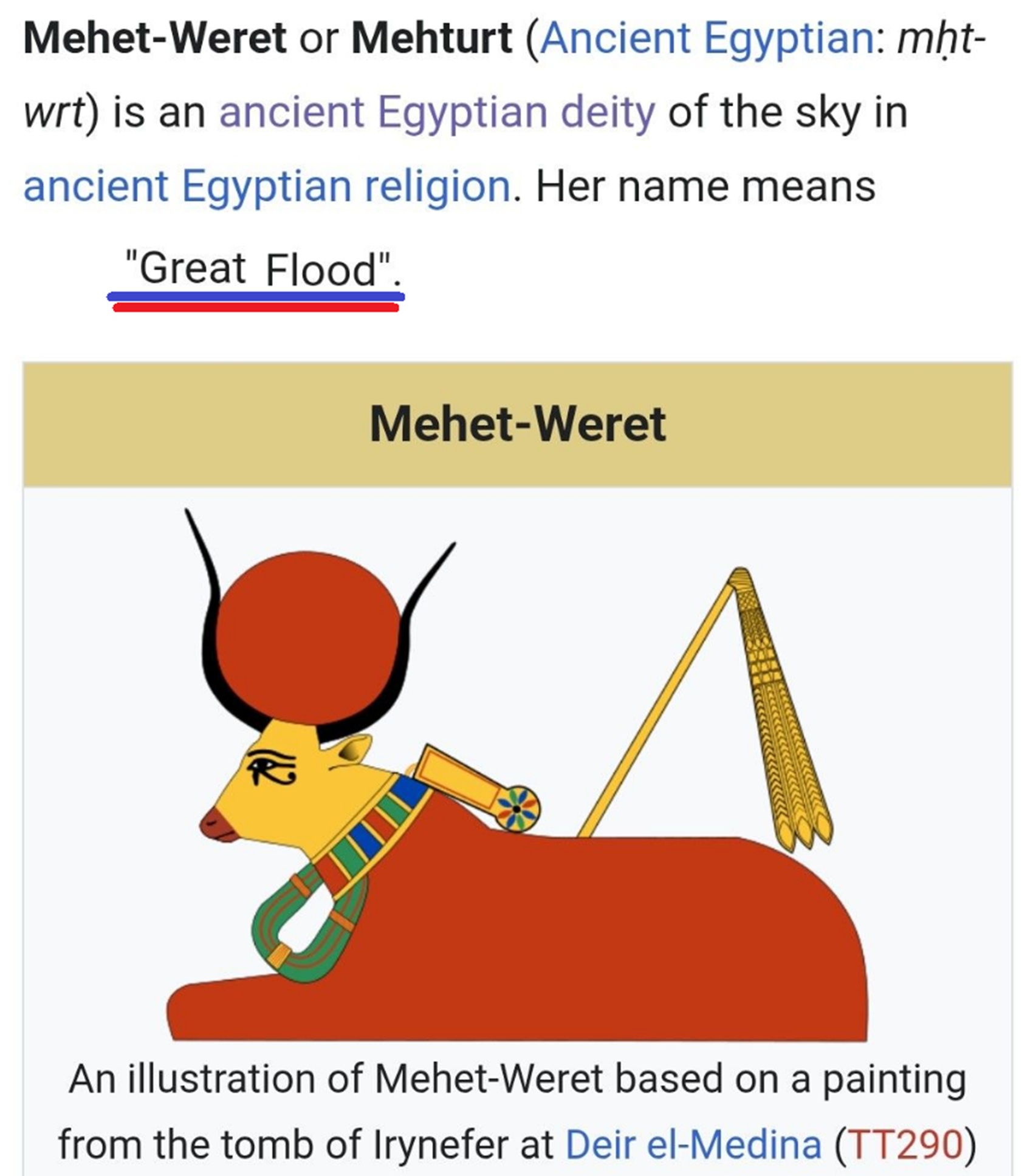
“Mehet-Weret or Mehturt (Ancient Egyptian: mḥt-wrt) is an ancient Egyptian deity of the sky in ancient Egyptian religion. Her name means “Great Flood”. She was mentioned in the Pyramid Texts. In ancient Egyptian creation myths, she gives birth to the sun at the beginning of time. In spell 17 of the Book of the Dead, the god Ra is born from her buttocks. In art, she is portrayed as a cow with a sun disk between her horns. She is associated with the goddesses Neith, Hathor, and Isis, all of whom have similar characteristics, and like them, she could be called the “Eye of Ra”. In some instances, she is simply an epithet for those goddesses. Her own titles included ‘mound’ and ‘island’ (mound of creation). Geraldine Pinch suggests that Mehet-Weret was also ‘probably’ the Milky Way in the night sky, to correspond with her identification as the celestial waters travelled by the solar barque.” ref
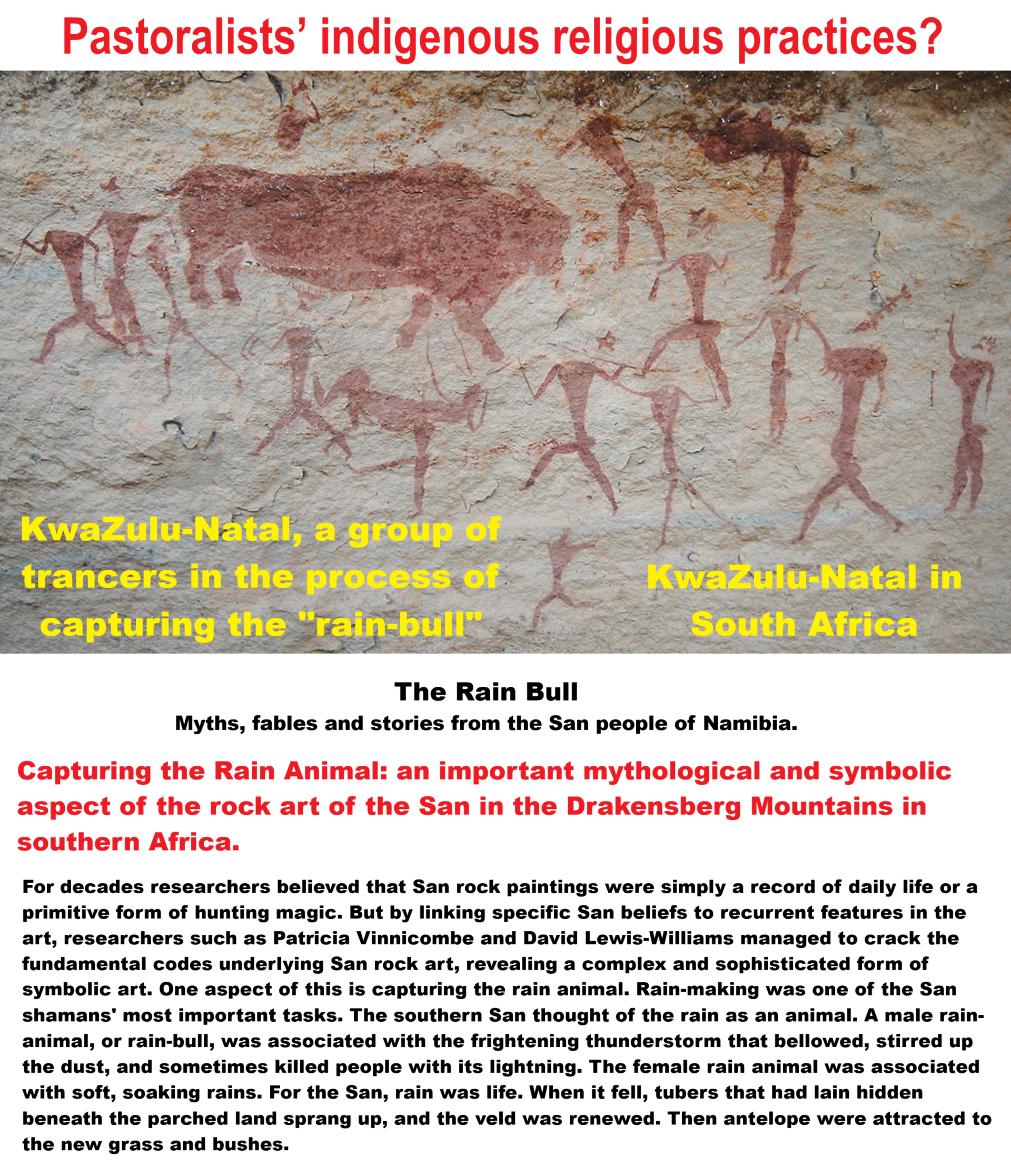
Pastoralists’ indigenous religious practices: capturing the “rain-bull”
“Ritual Cemeteries—For Cows and Then Humans—Plot Pastoralist Expansion Across Africa. As early herders spread across northern and then eastern Africa, the communities erected monumental graves which may have served as social gathering points. Testing religious beliefs Pastoralists’ indigenous religious practices: found that appeasing spirits (82%), sacrifice (89%), divination (76%), and communal ceremonies (94%) were practiced in the study areas. These systems have highly contributed to personal reproduction (55%), farming practices (45%), conflict resolution (60%), forecasting events (48%), healing (60%), social cohesion (70%), and local governing (50%) among the pastoralists.” ref

Mesopotamian Gods and the Bull
“In Mesopotamia, gods were associated with the bull from at least the Early Dynastic Period until the Neo-Babylonian or Chaldean Period. This relationship took on many forms; the bull could serve as the god’s divine animal, the god could be likened to the bull, or he could actually take on the form of the beast. In this paper, the various gods identified with or related to the bull will be identified and studied in order to identify which specific types of gods were most commonly and especially associated with the bull. The relationships between the gods and the bull are evident in textual as well as iconographic sources, although fewer instances of this connection are found in iconography. Examples of the portrayal of the association between the various gods and the bull in texts and iconography can be compared and contrasted in order to reveal differences and similarities in these portrayals.” ref

ref, ref, ref, ref, ref, ref, ref, ref, ref, ref, ref, ref
Sacred Cattle in Egyptian Mythology
“Bat is a cow goddess in Egyptian mythology who was depicted as a human face with cow ears and horns or as a woman. Other feminine bovine deities include Sekhat-Hor, Mehet-Weryt, Shedyt, Hathor, Hesat, and Celestial Cow “Sky goddess” Nut. Their masculine counterparts include Apis, Mnevis, Buchis, Sema-wer, Ageb-wer. Cattle are prominent in some religions and mythologies. As such, numerous people throughout the world have at one point in time honored bulls as sacred. In the Sumerian religion, Marduk is the “bull of Utu”. In Hinduism, Shiva’s steed is Nandi, the Bull. The sacred bull survives in the constellation Taurus. The bull, whether lunar as in Mesopotamia or solar as in India, is the subject of various other cultural and religious incarnations.” ref, ref, ref, ref, ref, ref, ref, ref, ref, ref, ref, ref
Sumerian religion, Marduk is the “Bull of Utu”
“Taurus (Latin, ‘Bull‘) is one of the constellations of the zodiac and is located in the northern celestial hemisphere. Taurus is a large and prominent constellation in the Northern Hemisphere‘s winter sky. It is one of the oldest constellations, dating back to the Early Bronze Age at least, when it marked the location of the Sun during the spring equinox. Its importance to the agricultural calendar influenced various bull figures in the mythologies of Ancient Sumer, Akkad, Assyria, Babylon, Egypt, Greece, and Rome. Its old astronomical symbol is (♉︎), which resembles a bull’s head. We cannot recreate a specific context for the bull skulls with horns (bucrania) preserved in an 8th millennium BCE sanctuary at Çatalhöyük in Central Anatolia. The sacred bull of the Hattians, whose elaborate standards were found at Alaca Höyük alongside those of the sacred stag, survived in Hurrian and Hittite mythology as Seri and Hurri (“Day” and “Night”), the bulls who carried the weather god Teshub on their backs or in his chariot and grazed on the ruins of cities.” ref
“The identification of the constellation of Taurus with a bull is very old, certainly dating to the Chalcolithic, and perhaps even to the Upper Paleolithic. Michael Rappenglück of the University of Munich believes that Taurus is represented in a cave painting at the Hall of the Bulls in the caves at Lascaux (dated to roughly 15,000 BCE), which he believes is accompanied by a depiction of the Pleiades. The name “seven sisters” has been used for the Pleiades in the languages of many cultures, including indigenous groups of Australia, North America and Siberia. This suggests that the name may have a common ancient origin. Taurus marked the point of vernal (spring) equinox in the Chalcolithic and the Early Bronze Age, from about 4000 to 1700 BCE, after which it moved into the neighboring constellation Aries. The Pleiades were closest to the Sun at vernal equinox around the 23rd century BCE. In Babylonian astronomy, the constellation was listed in the MUL.APIN as GU4.AN.NA, “The Bull of Heaven“. Although it has been claimed that “when the Babylonians first set up their zodiac, the vernal equinox lay in Taurus,” there is a claim that the MUL.APIN tablets indicate that the vernal equinox was marked by the Babylonian constellation known as “the hired man” (the modern Aries).” ref
“In the Old Babylonian Epic of Gilgamesh, the goddess Ishtar sends Taurus, the Bull of Heaven, to kill Gilgamesh for spurning her advances. Enkidu tears off the bull’s hind part and hurls the quarters into the sky where they become the stars we know as Ursa Major and Ursa Minor. Some locate Gilgamesh as the neighboring constellation of Orion, facing Taurus as if in combat, while others identify him with the sun whose rising on the equinox vanquishes the constellation. In early Mesopotamian art, the Bull of Heaven was closely associated with Inanna, the Sumerian goddess of sexual love, fertility, and warfare. One of the oldest depictions shows the bull standing before the goddess’ standard; since it has 3 stars depicted on its back (the cuneiform sign for “star-constellation”), there is good reason to regard this as the constellation later known as Taurus. The same iconic representation of the Heavenly Bull was depicted in the Dendera zodiac, an Egyptian bas-relief carving in a ceiling that depicted the celestial hemisphere using a planisphere. In these ancient cultures, the orientation of the horns was portrayed as upward or backward. This differed from the later Greek depiction where the horns pointed forward. To the Egyptians, the constellation Taurus was a sacred bull that was associated with the renewal of life in spring. When the spring equinox entered Taurus, the constellation would become covered by the Sun in the western sky as spring began. This “sacrifice” led to the renewal of the land. To the early Hebrews, Taurus was the first constellation in their zodiac and consequently it was represented by the first letter in their alphabet, Aleph.” ref
“In Greek mythology, Taurus was identified with Zeus, who assumed the form of a magnificent white bull to abduct Europa, a legendary Phoenician princess. In illustrations of Greek mythology, only the front portion of this constellation is depicted; this was sometimes explained as Taurus being partly submerged as he carried Europa out to sea. A second Greek myth portrays Taurus as Io, a mistress of Zeus. To hide his lover from his wife Hera, Zeus changed Io into the form of a heifer. Greek mythographer Acusilaus marks the bull Taurus as the same that formed the myth of the Cretan Bull, one of The Twelve Labors of Heracles. Taurus became an important object of worship among the Druids. Their Tauric religious festival was held while the Sun passed through the constellation. Among the arctic people known as the Inuit, the constellation is called Sakiattiat and the Hyades is Nanurjuk, with the latter representing the spirit of the polar bear. Aldebaran represents the bear, with the remainder of the stars in the Hyades being dogs that are holding the beast at bay.” ref
“In Buddhism, legends hold that Gautama Buddha was born when the full moon was in Vaisakha, or Taurus. Buddha’s birthday is celebrated with the Wesak Festival, or Vesākha, which occurs on the first or second full moon when the Sun is in Taurus. In 1990, due to the precession of the equinoxes, the position of the Sun on the first day of summer (June 21) crossed the IAU boundary of Gemini into Taurus. The Sun will slowly move through Taurus at a rate of 1° east every 72 years until approximately 2600, at which point it will be in Aries on the first day of summer.” ref
“The Sumerian guardian deity called lamassu was depicted as hybrids with bodies of either winged bulls or lions and heads of human males. The motif of a winged animal with a human head is common to the Near East, first recorded in Ebla around 3000 BCE. The first distinct lamassu motif appeared in Assyria during the reign of Tiglath-Pileser II as a symbol of power. “The human-headed winged bulls protective genies called shedu or lamassu, … were placed as guardians at certain gates or doorways of the city and the palace. Symbols combining man, bull, and bird, they offered protection against enemies.” ref
“The bull was also associated with the storm and rain god Adad, Hadad or Iškur. The bull was his symbolic animal. He appeared bearded, often holding a club and thunderbolt while wearing a bull-horned headdress. Hadad was equated with the Greek god Zeus; the Roman god Jupiter, as Jupiter Dolichenus; the Indo-European Nasite Hittite storm-god Teshub; the Egyptian god Amun. When Enki distributed the destinies, he made Iškur inspector of the cosmos. In one litany, Iškur is proclaimed again and again as “great radiant bull, your name is heaven” and also called son of Anu, lord of Karkara; twin-brother of Enki, lord of abundance, lord who rides the storm, lion of heaven.” ref
“The Sumerian Epic of Gilgamesh depicts the horrors of the rage-fueled deployment of the Bull of Heaven by Ishtar and its slaughter by Gilgamesh and Enkidu as an act of defiance that seals their fates:
Ishtar opened her mouth and said again, “My father, give me the Bull of Heaven to destroy Gilgamesh. Fill Gilgamesh, I say, with arrogance to his destruction; but if you refuse to give me the Bull of Heaven I will break in the doors of hell and smash the bolts; there will be a confusion of people, those above with those from the lower depths. I shall bring up the dead to eat food like the living; and the hosts of the dead will outnumber the living.” Anu said to great Ishtar, “If I do what you desire there will be seven years of drought throughout Uruk when corn will be seedless husks. Have you saved grain enough for the people and grass for the cattle?” Ishtar replied “I have saved grain for the people, grass for the cattle.”…When Anu heard what Ishtar had said he gave her the Bull of Heaven to lead by the halter down to Uruk. When they reached the gates of Uruk the Bull of Heaven went to the river; with his first snort cracks opened in the earth and a hundred young men fell down to death.” ref
“With his second snort cracks opened and two hundred fell down to death. With his third snort cracks opened, Enkidu doubled over but instantly recovered, he dodged aside and leapt onto the Bull and seized it by the horns. The Bull of Heaven foamed in his face, it brushed him with the thick of its tail. Enkidu cried to Gilgamesh, “My friend we boasted that we would leave enduring names behind us. Now thrust your sword between the nape and the horns.” So Gilgamesh followed the Bull, he seized the thick of its tail, he thrust the sword between the nape and the horns and slew the Bull. When they had killed the Bull of Heaven they cut out its heart and gave it to Shamash, and the brothers rested.” ref
“In Ancient Egypt multiple sacred bulls were worshiped. A long succession of ritually perfect bulls were identified by the god’s priests, housed in the temple for their lifetime, then embalmed and buried. The mother-cows of these animals were also revered, and buried in separate locations.
- In the Memphite region, the Apis was seen as the embodiment of Ptah and later of Osiris. Some of the Apis bulls were buried in large sarcophagi in the underground vaults of the Serapeum of Saqqara, which was rediscovered by Auguste Mariette in 1851.
- Mnevis of Heliopolis was the embodiment of Atum–Ra.
- Buchis of Hermonthis was linked with the gods Ra and Montu. The catacombs for these bulls are now known as the Bucheum. Multiple Buchis mummies were found in situ during excavations in the 1930s. Some of their sarcophagi are similar to those in the Serapeum, others are polylithic (made from multiple stones).” ref
“Ka, in Egyptian, is both a religious concept of life-force/power and the word for bull. Andrew Gordon, an Egyptologist, and Calvin Schwabe, a veterinarian, argue that the origin of the ankh is related to two other signs of uncertain origin that often appear alongside it: the was-sceptre, representing “power” or “dominion”, and the djed pillar, representing “stability”. According to this hypothesis, the form of each sign is drawn from a part of the anatomy of a bull, like some other hieroglyphic signs that are known to be based on body parts of animals. In Egyptian belief semen was connected with life and, to some extent, with “power” or “dominion”, and some texts indicate the Egyptians believed semen originated in the bones. Therefore, Calvin and Schwabe suggest the signs are based on parts of the bull’s anatomy through which semen was thought to pass: the ankh is a thoracic vertebra, the djed is the sacrum and lumbar vertebrae, and the was is the dried penis of the bull.” ref
“In Cyprus, bull masks made from real skulls were worn in rites. Bull-masked terracotta figurines and Neolithic bull-horned stone altars have been found in Cyprus. Bulls were a central theme in the Minoan civilization, with bull heads and bull horns used as symbols in the Knossos palace. Minoan frescos and ceramics depict bull-leaping, in which participants of both sexes vaulted over bulls by grasping their horns.” ref
“The Iranian language texts and traditions of Zoroastrianism have several different mythological bovine creatures. One of these is Gavaevodata, which is the Avestan name of a hermaphroditic “uniquely created (-aevo.data) cow (gav-)”, one of Ahura Mazda‘s six primordial material creations that becomes the mythological progenitor of all beneficent animal life. Another Zoroastrian mythological bovine is Hadhayans, a gigantic bull so large that it could straddle the mountains and seas that divide the seven regions of the earth, and on whose back men could travel from one region to another.” ref
“In medieval times, Hadhayans also came to be known as Srīsōk (Avestan *Thrisaok, “three burning places”), which derives from a legend in which three “Great Fires” were collected on the creature’s back. Yet another mythological bovine is that of the unnamed creature in the Cow’s Lament, an allegorical hymn attributed to Zoroaster himself, in which the soul of a bovine (geush urvan) despairs over her lack of protection from an adequate herdsman. In the allegory, the cow represents humanity’s lack of moral guidance, but in later Zoroastrianism, Geush Urvan became a yazata representing cattle. The 14th day of the month is named after her and is under her protection.” ref
“Bulls appear on seals from the Indus Valley civilisation. In The Rig Veda, the earliest collection of Vedic hymns (c. 1500-1000 BCE), Indra is often praised as a Bull (Vṛṣabha – vrsa (he) plus bha (being) or as uksan, a bull aged five to nine years, which is still growing or just reached its full growth). The bull is an icon of power and virile strength in Aryan literature and other Indo-European traditions. Vrsha means “to shower or to spray”, in this context Indra showers strength and virility. Vṛṣabha is also an astrological sign in Indian horoscope systems, corresponding to Taurus.” ref
“The storm god Rudra is called a bull as are the Maruts or storm deities referred to as bulls under the command of Indra, thus Indra is called “bull with bulls.” The following excerpts from The Rig Veda demonstrate these attributes:
“As a bull I call to you, the bull with the thunderbolt, with various aids, O Indra, bull with bulls, greatest killer of Vrtra.” — Atri and the Last Sun” ref
“He the mighty bull who with his seven reins let loose the seven rivers to flow, who with his thunderbolt in his hand hurled down Ruhina as he was climbing up to the sky, he my people is Indra.” — Who is Indra?
“I send praise to the high bull, tawny and white. I bow low to the radiant one. We praise the dreaded name of Rudra.” — Rudra, father of the Maruts” ref.
“Nandi later appears in the Puranas as the primary vahana (mount) and the principal gana (follower) of Shiva. Nandi figures depicted as a seated bull are present at Shiva temples throughout the world. Kao (bull), a supernatural divine bull, appears in ancient Meitei mythology and folklore of Ancient Manipur (Kangleipak). In the legend of the Khamba Thoibi epic, Nongban Kongyamba, a nobleman of ancient Moirang realm, pretended to be an oracle and falsely prophesied that the people of Moirang would lead to miserable lives, if the powerful Kao (bull) roaming freely in the Khuman kingdom, wasn’t offered to the god Thangjing (Old Manipuri: Thangching), the presiding deity of Moirang. Orphan Khuman prince Khamba was chosen to capture the bull, as he was known for his valor and faithfulness.” ref
“Since to capture the bull without killing it was not an easy task, Khamba’s motherly sister Khamnu disclosed to Khamba the secrets of the bull, by means of which the animal could be captured. Bull figurines are common finds on archaeological sites across the Levant; two examples are the 16th century BCE (Middle Bronze Age) bull calf from Ashkelon, and the 12th century BCE (Iron Age I) bull found at the so-called Bull Site in Samaria on the West Bank. Both Baʿal and El were associated with the bull in Ugaritic texts, as it symbolized both strength and fertility.” ref
Exodus 32:4 reads “He took this from their hand, and fashioned it with a graving tool and made it into a molten calf; and they said, ‘This is your god, O Israel, who brought you up from the land of Egypt’.” ref
Nehemiah 9:18 reads “even when they made an idol shaped like a calf and said, ‘This is your god who brought you out of Egypt!’ They committed terrible blasphemies.” ref
“Calf-idols are referred to later in the Tanakh, such as in the Book of Hosea, which would seem accurate as they were a fixture of near-eastern cultures. Solomon‘s “Molten Sea” basin stood on twelve brazen bulls. Young bulls were set as frontier markers at Dan and Bethel, the frontiers of the Kingdom of Israel. Much later, in Abrahamic religions, the bull motif became a bull demon or the “horned devil” in contrast and conflict to earlier traditions. The bull is familiar in Judeo-Christian cultures from the Biblical episode wherein an idol of the golden calf (Hebrew: עֵגֶּל הַזָהָב) is made by Aaron and worshipped by the Hebrews in the wilderness of the Sinai Peninsula (Book of Exodus). The text of the Hebrew Bible can be understood to refer to the idol as representing a separate god, or as representing Yahweh himself, perhaps through an association or religious syncretism with Egyptian or Levantine bull gods, rather than a new deity in itself.” ref
“Among the Twelve Olympians, Hera‘s epithet Bo-opis is usually translated “ox-eyed” Hera, but the term could just as well apply if the goddess had the head of a cow, and thus the epithet reveals the presence of an earlier, though not necessarily more primitive, iconic view. (Heinrich Schlieman, 1976) Classical Greeks never otherwise referred to Hera simply as the cow, though her priestess Io was so literally a heifer that she was stung by a gadfly, and it was in the form of a heifer that Zeus coupled with her. Zeus took over the earlier roles, and, in the form of a bull that came forth from the sea, abducted the high-born Phoenician Europa and brought her, significantly, to Crete.” ref
“Dionysus was another god of resurrection who was strongly linked to the bull. In a worship hymn from Olympia, at a festival for Hera, Dionysus is also invited to come as a bull, “with bull-foot raging.” “Quite frequently he is portrayed with bull horns, and in Kyzikos he has a tauromorphic image,” Walter Burkert relates, and refers also to an archaic myth in which Dionysus is slaughtered as a bull calf and impiously eaten by the Titans.” ref
“For the Greeks, the bull was strongly linked to the Cretan Bull: Theseus of Athens had to capture the ancient sacred bull of Marathon (the “Marathonian bull”) before he faced the Minotaur (Greek for “Bull of Minos”), who the Greeks imagined as a man with the head of a bull at the center of the labyrinth. Minotaur was fabled to be born of the Queen and a bull, bringing the king to build the labyrinth to hide his family’s shame. Living in solitude made the boy wild and ferocious, unable to be tamed or beaten. Yet Walter Burkert‘s constant warning is, “It is hazardous to project Greek tradition directly into the Bronze Age.” Only one Minoan image of a bull-headed man has been found, a tiny Minoan sealstone currently held in the Archaeological Museum of Chania.” ref
“In the Classical period of Greece, the bull and other animals identified with deities were separated as their agalma, a kind of heraldic show-piece that concretely signified their numinous presence. The religious practices of the Roman Empire of the 2nd to 4th centuries included the taurobolium, in which a bull was sacrificed for the well-being of the people and the state. Around the mid-2nd century, the practice became identified with the worship of Magna Mater, but was not previously associated only with that cult (cultus). Public taurobolia, enlisting the benevolence of Magna Mater on behalf of the emperor, became common in Italy and Gaul, Hispania and Africa. The last public taurobolium for which there is an inscription was carried out at Mactar in Numidia at the close of the 3rd century. It was performed in honor of the emperors Diocletian and Maximian.” ref
“Another Roman mystery cult in which a sacrificial bull played a role was that of the 1st–4th century Mithraic Mysteries. In the so-called “tauroctony” artwork of that cult (cultus), and which appears in all its temples, the god Mithras is seen to slay a sacrificial bull. Although there has been a great deal of speculation on the subject, the myth (i.e. the “mystery”, the understanding of which was the basis of the cult) that the scene was intended to represent remains unknown. Because the scene is accompanied by a great number of astrological allusions, the bull is generally assumed to represent the constellation of Taurus. The basic elements of the tauroctony scene were originally associated with Nike, the Greek goddess of victory. Macrobius lists the bull as an animal sacred to the god Neto/Neito, possibly being sacrifices to the deity.” ref
“Tarvos Trigaranus (the “bull with three cranes”) is pictured on ancient Gaulish reliefs alongside images of gods, such as in the cathedrals at Trier and at Notre Dame de Paris. In Irish mythology, the Donn Cuailnge and the Finnbhennach are prized bulls that play a central role in the epic Táin Bó Cúailnge (“The Cattle Raid of Cooley”). Early medieval Irish texts also mention the tarbfeis (bull feast), a shamanistic ritual in which a bull would be sacrificed and a seer would sleep in the bull’s hide to have a vision of the future king. Pliny the Elder, writing in the first century CE, describes a religious ceremony in Gaul in which white-clad druids climbed a sacred oak, cut down the mistletoe growing on it, sacrificed two white bulls and used the mistletoe to cure infertility.” ref
“The druids—that is what they call their magicians—hold nothing more sacred than the mistletoe and a tree on which it is growing, provided it is Valonia oak. … Mistletoe is rare and when found it is gathered with great ceremony, and particularly on the sixth day of the moon….Hailing the moon in a native word that means ‘healing all things,’ they prepare a ritual sacrifice and banquet beneath a tree and bring up two white bulls, whose horns are bound for the first time on this occasion. A priest arrayed in white vestments climbs the tree and, with a golden sickle, cuts down the mistletoe, which is caught in a white cloak. Then finally they kill the victims, praying to a god to render his gift propitious to those on whom he has bestowed it. They believe that mistletoe given in drink will impart fertility to any animal that is barren and that it is an antidote to all poisons. Bull sacrifices at the time of the Lughnasa festival were recorded as late as the 18th century at Cois Fharraige in Ireland (where they were offered to Crom Dubh) and at Loch Maree in Scotland (where they were offered to Saint Máel Ruba).” ref
Cattle in religion and mythology
There are varying beliefs about cattle in societies and religions.
“Cattle are considered sacred in the Indian religions of Hinduism, Jainism and Buddhism, as well as in some Chinese folk religion and in African paganism. Cattle played other major roles in many religions, including those of ancient Egypt, ancient Greece, ancient Israel, and ancient Rome. In some regions, especially most states of India, the slaughter of cattle is prohibited and their meat (beef) may be taboo.” ref
“In ancient Egyptian religion, bulls symbolized strength and male sexuality and were linked with aggressive deities such as Montu and virile deities such as Min. Some Egyptian cities kept sacred bulls that were said to be incarnations of divine powers, including the Mnevis bull, Buchis bull, and the Apis bull, which was regarded as a manifestation of the god Ptah and was the most important sacred animal in Egypt. Cows were connected with fertility and motherhood. One of several ancient Egyptian creation myths said that a cow goddess, Mehet-Weret, who represented the primeval waters that existed before creation, gave birth to the sun at the beginning of time. The sky was sometimes envisioned as a goddess in the form of a cow, and several goddesses, including Hathor, Nut, and Neith, were equated with this celestial cow. The Egyptians did not regard cattle as uniformly positive. Wild bulls, regarded as symbols of the forces of chaos, could be hunted and ritually killed.” ref
“As cattle were a central part of the pastoralist economy of Ancient Nubia, Africa, they also played a prominent role in their culture and mythology, as evidenced by their inclusion in burials and rock art. Starting in the Neolithic period, cattle skulls, also known as bucrania, were often placed alongside human burials. Bucrania were a status symbol, and they were used frequently in adult male burials, occasionally in adult female burials, and rarely in child burials. In cemeteries at Kerma, there is a strong correlation between the number of bucrania and the quantity and lavishness of other grave goods. Dozens if not hundreds of cattle were often slaughtered as tribute for the burial of one individual; 400 bucrania were found at one tumulus alone at Kerma. The use of cattle skulls rather than those of sheep or goats reveals the importance of cattle in their pastoral economy, as well as the cultural associations of cattle with wealth, prosperity, and passage into the afterlife. Sometimes complete cattle were buried alongside their owner, symbolic of their relationship continuing into the afterlife.” ref
“Beginning in the third millennium BCE, cattle became the most popular motif in Nubian rock art. The bodies are usually depicted in profile, while the horns are facing forward. The length and shape of the horns and the pattern on the hide varied widely. Human silhouettes are often drawn alongside the cattle, symbolic of the important symbiotic relationship between cattle and humans. For pastoralists, drawing cattle may have also been a way to ensure the health of their herd. The role of cattle in Nubian mythology is more covert than in Egypt to the north, where several gods are often depicted as cattle; however, the significance of cattle in Nubian culture is evident in burial practices, understandings of the afterlife, and rock art.” ref
“Hinduism specifically considers the zebu (Bos indicus) to be sacred. Respect for the lives of animals including cattle, diet in Hinduism and vegetarianism in India are based on the Hindu ethics. The Hindu ethics are driven by the core concept of Ahimsa, i.e. non-violence towards all beings, as mentioned in the Chandogya Upanishad (~ 800 BCE). By mid 1st millennium BCE, all three major religions – Buddhism, Hinduism, and Jainism – were championing non-violence as an ethical value, and something that impacted one’s rebirth. By about 200 CE, food and feasting on animal slaughter were widely considered as a form of violence against life forms, and became a religious and social taboo. India, which has 79.80% Hindu population as of (2011 census), had the lowest rate of meat consumption in the world according to the 2007 UN FAO statistics, and India has more vegetarians than the rest of the world put together.” ref
“According to Ludwig Alsdorf, “Indian vegetarianism is unequivocally based on ahimsa (non-violence)” as evidenced by ancient smritis and other ancient texts of Hinduism.” He adds that the endearment and respect for cattle in Hinduism is more than a commitment to vegetarianism and has become integral to its theology. The respect for cattle is widespread but not universal. Animal sacrifices have been rare among the Hindus outside a few eastern states. To the majority of modern Indians, states Alsdorf, respect for cattle and disrespect for slaughter is a part of their ethos, and there is “no ahimsa without renunciation of meat consumption”. The cow in Hindu society is traditionally identified as a caretaker and a maternal figure, and Hindu society honors the cow as a symbol of unselfish giving, selfless sacrifice, gentleness, and tolerance.” ref
“Several scholars explain the veneration for cows among Hindus in economic terms, including the importance of dairy in the diet, the use of cow dung as fuel and fertilizer, and the importance that cattle have historically played in agriculture. Ancient texts such as Rig Veda, Puranas highlight the importance of cattle. The scope, extent, and status of cows throughout ancient India is a subject of debate. Cattle, including cows, were neither inviolable nor as revered in ancient times as they were later. A Gryhasutra recommends that beef be eaten by the mourners after a funeral ceremony as a ritual rite of passage. In contrast, the Vedic literature is contradictory, with some suggesting ritual slaughter and meat consumption, while others suggesting a taboo on meat eating. Many ancient and medieval Hindu texts debate the rationale for a voluntary stop to cow slaughter and the pursuit of vegetarianism as a part of a general abstention from violence against others and all killing of animals.” ref
“The interdiction of the meat of the bounteous cow as food was regarded as the first step to total vegetarianism. Dairy cows are called aghnya “that which may not be slaughtered” in the Rigveda. Yaska, the early commentator of the Rigveda, gives nine names for cow, the first being “aghnya”. The literature relating to cow veneration became common in 1st millennium CE, and by about 1000 CE vegetarianism, along with a taboo against beef, became a well accepted mainstream Hindu tradition. This practice was inspired by the beliefs in Hinduism that a soul is present in all living beings, life in all its forms is interconnected, and non-violence towards all creatures is the highest ethical value. The god Krishna and his Yadava kinsmen are associated with cows, adding to its endearment.” ref
“The cow veneration in ancient India during the Vedic era, the religious texts written during this period called for non-violence towards all bipeds and quadrupeds, and often equated killing of a cow with the killing of a human being specifically a Brahmin. The hymn 8.3.25 of the Hindu scripture Atharvaveda (~1200–1500 BCE) condemns all killings of men, cattle, and horses, and prays to god Agni to punish those who kill.” ref
“In the Puranas, which are part of the Hindu texts, the earth-goddess Prithvi was in the form of a cow, successively milked of beneficent substances for the benefit of humans, by deities starting with the first sovereign: Prithu milked the cow to generate crops for humans to end a famine. Kamadhenu, the miraculous “cow of plenty” and the “mother of cows” in certain versions of the Hindu mythology, is believed to represent the generic sacred cow, regarded as the source of all prosperity. In the 19th century, a form of Kamadhenu was depicted in poster-art that depicted all major gods and goddesses in it. Govatsa Dwadashi, which marks the first day of Diwali celebrations, is the main festival connected to the veneration and worship of cows as chief source of livelihood and religious sanctity in India, wherein the symbolism of motherhood is most apparent with the sacred cows Kamadhenu and her daughter Nandini.” ref
“Jainism is against violence to all living beings, including cattle. According to the Jaina sutras, humans must avoid all killing and slaughter because all living beings are fond of life, they suffer, they feel pain, they like to live, and long to live. All beings should help each other live and prosper, according to Jainism, not kill and slaughter each other. In the Jain religious tradition, neither monks nor laypersons should cause others or allow others to work in a slaughterhouse. Jains believe that vegetarian sources can provide adequate nutrition, without creating suffering for animals such as cattle. According to some Jain scholars, slaughtering cattle increases ecological burden from human food demands since the production of meat entails intensified grain demands, and reducing cattle slaughter by 50 percent would free up enough land and ecological resources to solve all malnutrition and hunger worldwide. The Jain community leaders, states Christopher Chapple, has actively campaigned to stop all forms of animal slaughter including cattle.” ref
“The texts of Buddhism state ahimsa to be one of five ethical precepts, which requires a practicing Buddhist to “refrain from killing living beings”. Slaughtering cow has been a taboo, with some texts suggesting that taking care of a cow is a means of taking care of “all living beings”. Cattle are seen in some Buddhist sects as a form of reborn human beings in the endless rebirth cycles in samsara, protecting animal life and being kind to cattle and other animals is good karma. Not only do some, mainly Mahayana, Buddhist texts state that killing or eating meat is wrong, it urges Buddhist laypersons to not operate slaughterhouses, nor trade in meat. Indian Buddhist texts encourage a plant-based diet.” ref
“According to Saddhatissa, in the Brahmanadhammika Sutta, the Buddha “describes the ideal mode of life of Brahmins in the Golden Age” before him as follows: Like mother (they thought), father, brother or any other kind of kin, cows are our kin most excellent from whom come many remedies. Givers of good and strength, of good complexion and the happiness of health, having seen the truth of this cattle, they never killed. Those Brahmins, then by Dharma, did what should be done, not what should not, and so aware they graceful were, well-built, fair-skinned, of high renown. While in the world, this lore was found, these people happily prospered. — Buddha, Brahmanadhammika Sutta 13.24, Sutta Nipāta” ref
“Saving animals from slaughter for meat, is believed in Buddhism to be a way to acquire merit for better rebirth. According to Richard Gombrich, there has been a gap between Buddhist precepts and practice. Vegetarianism is admired, states Gombrich, but often it is not practiced. Nevertheless, adds Gombrich, there is a general belief among Theravada Buddhists that eating beef is worse than other meat and the ownership of cattle slaughterhouses by Buddhists is relatively rare. Meat eating remains controversial within Buddhism, with most Theravada sects allowing it, reflecting early Buddhist practice, and most Mahayana sects forbidding it. Early suttas indicate that the Buddha himself ate meat and was clear that no rule should be introduced to forbid meat eating to monks. The consumption, however, appears to have been limited to pork, chicken and fish and may well have excluded cattle.” ref
“The term geush urva means “the spirit of the cow” and is interpreted as the soul of the earth. In the Ahunavaiti Gatha, Zoroaster accuses some of his co-religionists of abusing the cow while Ahura Mazda tells him to protect them. After fleeing to India, many Zoroastrians stopped eating beef out of respect for Hindus living there. The lands of Zoroaster and the Vedic priests were those of cattle breeders. The 9th chapter of the Vendidad of the Avesta expounds the purificatory power of cow urine. It is declared to be a panacea for all bodily and moral evils and features prominently in the 9-night purification ritual Barashnûm.” ref
“According to the Bible, the Israelites worshipped a cult image of a golden calf when the prophet Moses went up to Mount Sinai. Moses considered this a great sin against God. As a result of their abstention from the act, the Levite tribe attained a priestly role. A cult of golden calves appears later during the rule of Jeroboam. According to the Hebrew Bible, an unblemished red cow was an important part of ancient Jewish rituals. The cow was sacrificed and burned in a precise ritual, and the ashes were added to water used in the ritual purification of a person who had come in to contact with a human corpse. The ritual is described in the Book of Numbers in Chapter 19, verses 1–14.” ref
“Observant Jews study this passage every year as part of the weekly Torah portion called Chukat. A contemporary Jewish organization called the Temple Institute is trying to revive this ancient religious observance. Traditional Judaism considers beef kosher and permissible as food, as long as the cow is slaughtered in a religious ritual called shechita, and the meat is not served in a meal that includes any dairy foods. Some Jews committed to Jewish vegetarianism believe that Jews should refrain from slaughtering animals altogether and have condemned widespread cruelty towards cattle on factory farms. The red heifer or red cow is a particular kind of cow brought to priests for sacrifice in the Hebrew Bible. Jews and some Christian fundamentalists believe that once a red heifer is born they will be able to rebuild the Third Temple on the Temple Mount in Jerusalem.” ref
“Oxen are one of the animals sacrificed by Greek Orthodox believers in some villages of Greece. It is especially associated with the feast of Saint Charalambos. This practice of kourbania has been repeatedly criticized by church authorities. The ox is the symbol of Luke the Evangelist. Among the Visigoths, the oxen pulling the wagon with the corpse of Saint Emilian lead to the correct burial site (San Millán de la Cogolla, La Rioja). In Greek mythology, the Cattle of Helios pastured on the island of Thrinacia, which is believed to be modern Sicily. Helios, the sun god, is said to have had seven herds of oxen and seven flocks of sheep, each numbering fifty head. A hecatomb was a sacrifice to the gods Apollo, Athena, and Hera, of 100 cattle (hekaton = one hundred).” ref
“The Greek gods also transformed themselves or others into cattle as a form of deception or punishment, such as in the myths of Io and Europa. In the myth of Pasiphaë, she falls in love with a bull as punishment by Poseidon. She gives birth to the Minotaur, a human-bull hybrid. In the ancient Anatolian civilization Hatti, the storm god was closely linked to a bull. Tarvos Trigaranus (the “bull with three cranes”) is pictured on ancient Gaulish reliefs alongside images of gods. There is evidence that ancient Celtic peoples sacrificed animals, which were almost always cattle or other livestock. Early medieval Irish texts mention the tarbfeis (bull feast), a shamanistic ritual in which a bull would be sacrificed and a seer would sleep in the bull’s hide to have a vision of the future king.” ref
“Cattle appear often in Irish mythology. The Glas Gaibhnenn is a mythical prized cow that could produce plentiful supplies of milk, while Donn Cuailnge and Finnbhennach are prized bulls that play a central role in the epic Táin Bó Cúailnge (“The Cattle Raid of Cooley”). The mythical lady Flidais, the main figure in the Táin Bó Flidhais, owns a herd of magical cattle.The name of the goddess of the River Boyne, Bóinn, comes from Archaic Irish *Bóu-vinda meaning the “bright or white cow”; while the name of the Corcu Loígde means “tribe of the calf goddess”. In Norse mythology, the primeval cow Auðumbla suckled Ymir, the ancestor of the frost giants, and licked Búri, Odin‘s grandfather and ancestor of the gods, out of the ice.” ref
“A beef taboo in ancient China was historically a dietary restriction, particularly among the Han Chinese, as oxen and buffalo (bovines) are useful in farming and are respected. During the Zhou dynasty, they were not often eaten, even by emperors. Some emperors banned killing cows. Beef is not recommended in Chinese medicine, as it is considered a hot food and is thought to disrupt the body’s internal balance. In written sources (including anecdotes and Daoist liturgical texts), this taboo first appeared in the 9th to 12th centuries (Tang–Song transition, with the advent of pork meat.)” ref
“By the 16th to 17th centuries, the beef taboo had become well accepted in the framework of Chinese morality and was found in morality books (善書), with several books dedicated exclusively to this taboo. The beef taboo came from a Chinese perspective that relates the respect for animal life and vegetarianism (ideas shared by Buddhism, Confucianism, and Daoism, and state protection for draught animals.) In Chinese society, only ethnic and religious groups not fully assimilated (such as the Muslim Huis and the Miao) and foreigners consumed this meat. This taboo, among Han Chinese, led Chinese Muslims to create a niche for themselves as butchers who specialized in slaughtering oxen and buffalo. Occasionally, some cows seen weeping before slaughter are often released to temples nearby.” ref
“Islam allows the slaughter of cows and consumption of beef, as long as the cow is slaughtered in a religious ritual called dhabīḥah or zabiha similar to the Jewish shechita. Although slaughter of cattle plays a role in a major Muslim holiday, Eid al-Adha, many rulers of the Mughal Empire had imposed a ban on the slaughter of cows owing to the large Hindu and Jain populations living under their rule. The second and longest surah of the Quran is named Al-Baqara (“The Cow”). Out of the 286 verses of the surah, 7 mention cows (Al Baqarah 67–73). The name of the surah derives from this passage in which Moses orders his people to sacrifice a cow in order to resurrect a man murdered by an unknown person. Per the passage, the “Children of Israel” quibbled over what kind of cow was meant when the sacrifice was ordered.” ref
“While addressing to children of Israel, it was said:
And when We did appoint for Moses forty nights (of solitude), and then ye chose the calf, when he had gone from you, and were wrong-doers. Then, even after that, We pardoned you in order that ye might give thanks. And when We gave unto Moses the Scripture and the criterion (of right and wrong), that ye might be led aright. And when Moses said unto his people: O my people! Ye have wronged yourselves by your choosing of the calf (for worship) so turn in penitence to your Creator, and kill (the guilty) yourselves. That will be best for you with your Creator, and He will relent toward you. Lo! He is the Relenting, the Merciful. (Al-Quran 2:51–54)” ref
“And when Moses said unto his people: Lo! God commandeth you that ye sacrifice a cow, they said: Dost thou make game of us ? He answered: God forbid that I should be among the foolish! They said: Pray for us unto thy Lord that He make clear to us what (cow) she is. (Moses) answered: Lo! He saith, Verily she is a cow neither with calf nor immature; (she is) between the two conditions; so do that which ye are commanded. They said: Pray for us unto thy Lord that He make clear to us of what colour she is. (Moses) answered: Lo! He saith: Verily she is a yellow cow. Bright is her colour, gladdening beholders. They said: Pray for us unto thy Lord that He make clear to us what (cow) she is. Lo! cows are much alike to us; and Lo! if God wills, we may be led aright. (Moses) answered: Lo! He saith: Verily she is a cow unyoked; she plougheth not the soil nor watereth the tilth; whole and without mark. They said: Now thou bringest the truth. So they sacrificed her, though almost they did not. And (remember) when ye slew a man and disagreed concerning it, and God brought forth that which ye were hiding. And We said: Smite him with some of it. Thus God bringeth the dead to life and showeth you His portents so that ye may understand. (Al-Quran 2:67–73)” ref
“Classical Sunni and Shia commentators recount several variants of this tale. Per some of the commentators, though any cow would have been acceptable, but after they “created hardships for themselves” and the cow was finally specified, it was necessary to obtain it at any cost. Historically, there was a beef taboo in ancient Japan, as a means of protecting the livestock population and due to Buddhist influence. Meat-eating had long been taboo in Japan, beginning with a decree in 675 that banned the consumption of cattle, horses, dogs, monkeys, and chickens, influenced by the Buddhist prohibition of killing. In 1612, the shōgun declared a decree that specifically banned the killing of cattle.” ref
“This official prohibition was in place until 1872, when it was officially proclaimed that Emperor Meiji consumed beef and mutton, which transformed the country’s dietary considerations as a means of modernizing the country, particularly with regard to consumption of beef. With contact from Europeans, beef increasingly became popular, even though it had previously been considered barbaric. Several shrines and temples are decorated with cow figurines, which are believed to cure illnesses when stroked.” ref

Herding societies
“The best known and purest pastoral nomads are found in the enormous arid belt from Morocco to Manchuria, passing through North Africa, Arabia, Iran, Turkistan, Tibet, and Mongolia. They include people as diverse as the Arabized North Africans and the Mongol hordes. Other less specialized and successful pastoralists include the Siberian reindeer herders, cattle herders of the grasslands of north-central Africa, and the Khoekhoe and Herero of southern Africa.” ref, ref
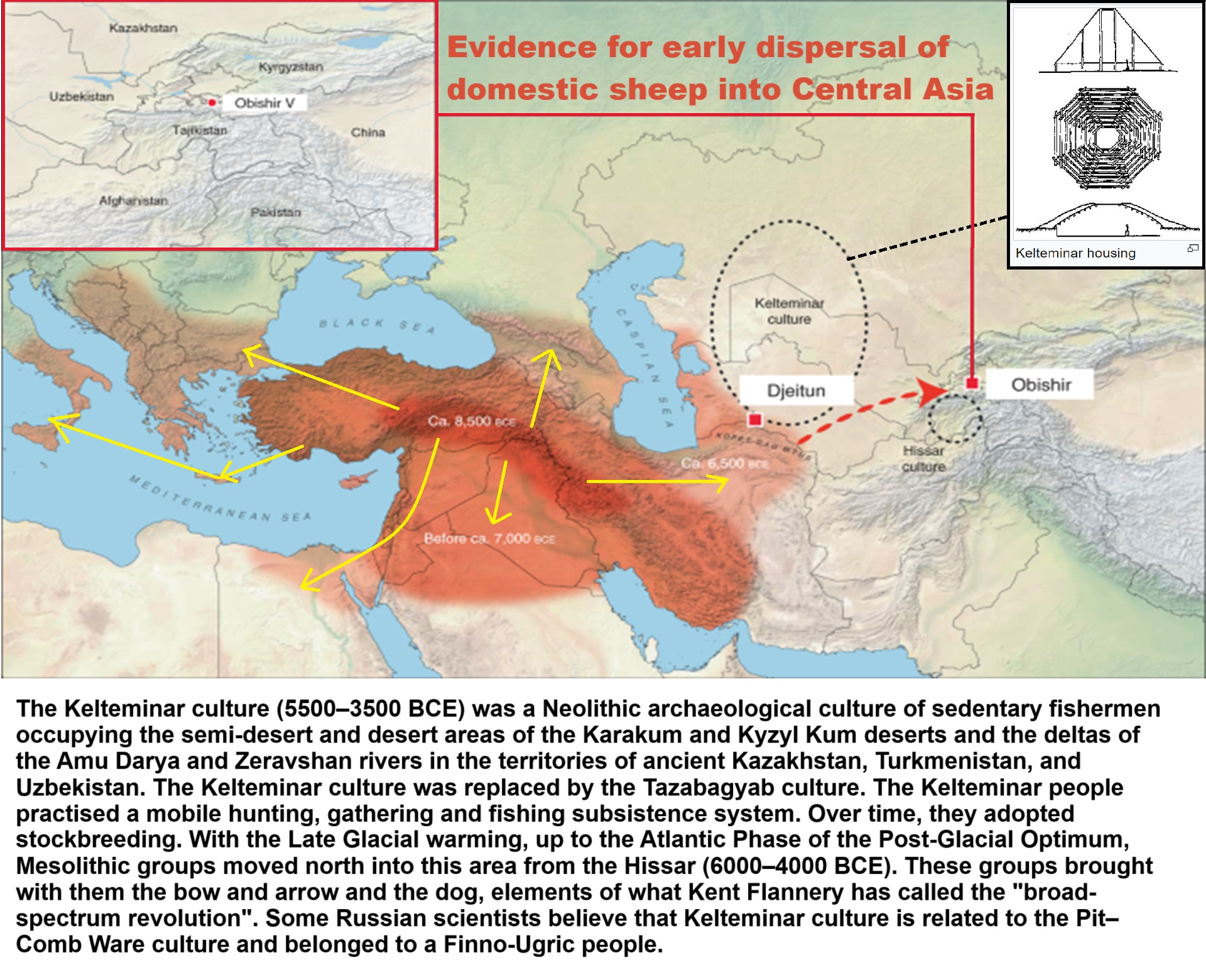
Evidence for the early dispersal of domestic sheep into Central Asia
“Archaeological and biomolecular evidence from Obishir V in southern Kyrgyzstan, establishing the presence of domesticated sheep by ca. 6,000 BCE. Zooarchaeological and collagen peptide mass fingerprinting show exploitation of Ovis and Capra, while cementum analysis of intact teeth implicates possible pastoral slaughter during the fall season. Most significantly, ancient DNA reveals these directly dated specimens as the domestic O. aries, within the genetic diversity of domesticated sheep lineages. Together, these results provide the earliest evidence for the use of livestock in the mountains of the Ferghana Valley, predating previous evidence by 3,000 years and suggesting that domestic animal economies reached the mountains of interior Central Asia far earlier than previously recognized.” ref, ref
Tutelary Deities
“A tutelary is a deity or spirit who is a guardian, patron, or protector of a particular place, geographic feature, person, lineage, nation, culture, or occupation. The etymology of “tutelary” expresses the concept of safety, and thus of guardianship. Chinese folk religion, both past and present, includes a myriad of tutelary deities. Exceptional individuals may become deified after death. In Hinduism, tutelary deities are known as ishta-devata and Kuldevi or Kuldevta. Gramadevata are guardian deities of villages. In Korean shamanism, jangseung and sotdae were placed at the edge of villages to frighten off demons. They were also worshiped as deities. In Shinto, the spirits, or kami, which give life to human bodies come from nature and return to it after death. Ancestors are therefore themselves tutelaries to be worshiped. In Philippine animism, Diwata or Lambana are deities or spirits that inhabit sacred places like mountains and mounds and serve as guardians. Thai provincial capitals have tutelary city pillars and palladiums. The guardian spirit of a house is known as Chao Thi or Phra Phum. Almost every Buddhist household in Thailand has a miniature shrine housing this tutelary deity, known as a spirit house. And in Tibetan Buddhism has Yidam as a tutelary deity.” ref
Grandmother-Mother Ancestor Spirits
“Ancestor worship is perhaps the world’s oldest religion. Some anthropologists theorize that it grew out of belief in some societies that dead people still exist in some form because they appear in dreams. Ancestor worship involves the belief that the dead live on as spirits and that it is the responsibility of their family members and descendants to make sure that they are well taken care of. If they are not they may come back and cause trouble to the family members and descendants that have ignored or disrespected them. Unhappy dead ancestors are greatly feared and every effort is made to make sure they are comfortable in the afterlife. Accidents and illnesses are often attributed to deeds performed by the dead and cures are often attempts to placate them.” ref
“In some societies, people go out of their way to be nice to one another, especially older people, out of fear of the nasty things they might do when they die. Ancestor worship is found in many forms in cultures throughout the world, Veneration of ancestors is regarded as a means through which an individual can assure his or her own immortality. Children are valued because they could provide for the spirits of their parents after death. Family members who remained together and venerated their forebears with strict adherence to prescribed ritual find comfort in the belief that the souls of their ancestors are receiving proper spiritual nourishment and that they are insuring their own soul’s nourishment after death.” ref
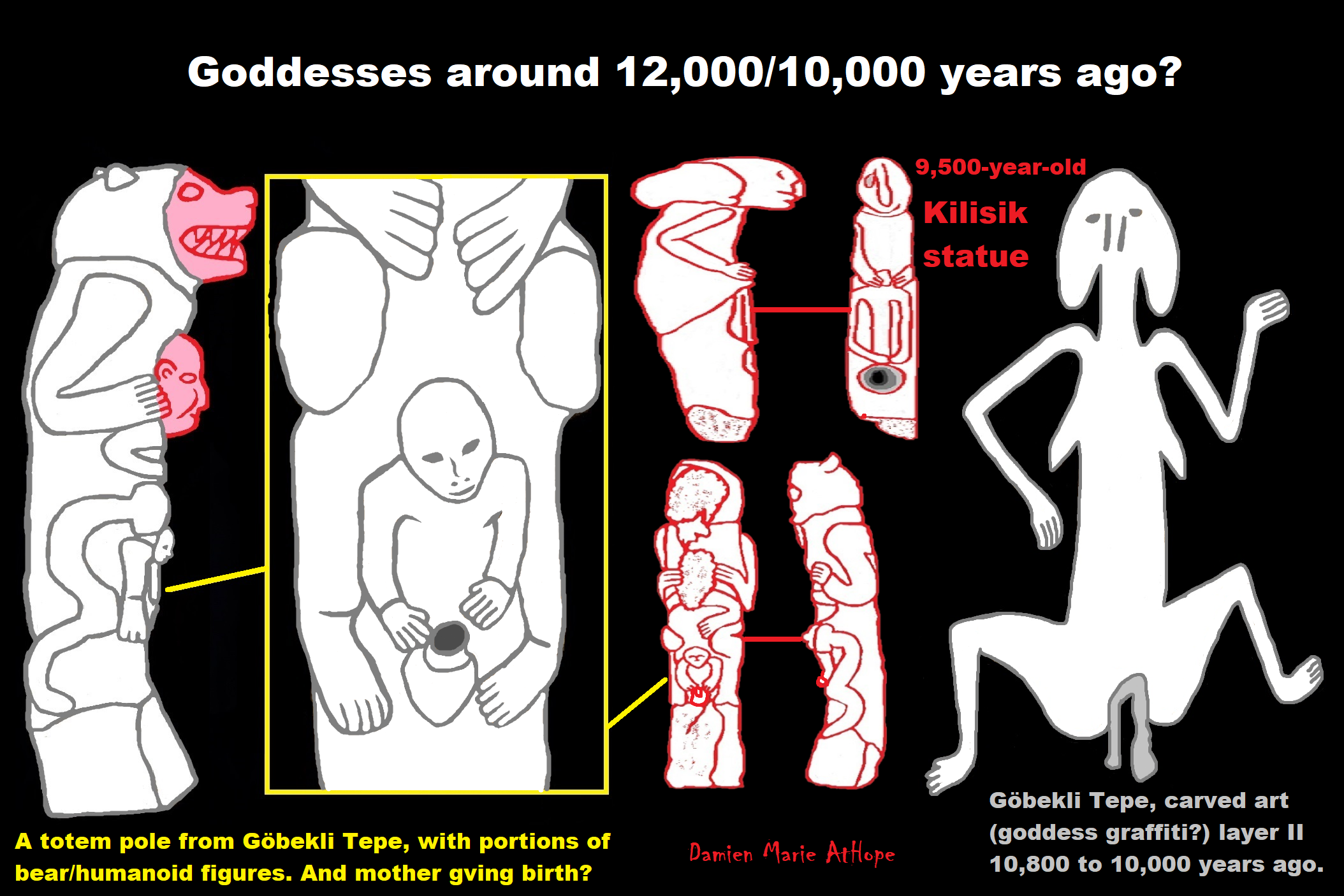
“Göbekli Tepe, engraving of a female person (seemingly in the birth position) and the Bear totem pole
giving birth to a human with pottery are from layer II, around 10,000 years ago.” ref
“Göbekli Tepe is a Neolithic archaeological site in Upper Mesopotamia (al-Jazira) in modern-day Turkey. The settlement was inhabited from around 9500 BCE to at least 8000 BCE or around 11,500 to 10,000 years ago, during the Pre-Pottery Neolithic. Elements of village life appeared as early as 10,000 years before the Neolithic in places, and the transition to agriculture took thousands of years, with different paces and trajectories in different regions. It is famous for its large circular structures that contain massive stone pillars – among the world’s oldest known megaliths. Many of these pillars are decorated with anthropomorphic details, clothing, and sculptural reliefs of wild animals, providing archaeologists rare insights into prehistoric religion and the particular iconography of the period. The 15 m (50 ft) high, 8 ha (20-acre) tell is densely covered with ancient domestic structures and other small buildings, quarries, and stone-cut cisterns from the Neolithic, as well as some traces of activity from later periods. The site was first used at the dawn of the southwest Asian Neolithic period, which marked the appearance of the oldest permanent human settlements anywhere in the world. Prehistorians link this Neolithic Revolution to the advent of agriculture but disagree on whether farming caused people to settle down or vice versa. Göbekli Tepe, a monumental complex built on a rocky mountaintop with no clear evidence of agricultural cultivation, has played a prominent role in this debate. Recent findings suggest a settlement at Göbekli Tepe, with domestic structures, extensive cereal processing, a water supply, and tools associated with daily life. This contrasts with a previous interpretation of the site as a sanctuary used by nomads, with few or no permanent inhabitants. No definitive purpose has been determined for the megalithic structures, which have been popularly described as the “world’s first temple[s]”. They were likely roofed and appear to have regularly collapsed, been inundated by slope slides, and subsequently repaired or rebuilt. The iconography of these objects is similar to that of the pillars, mostly depicting animals but also humans, again primarily male.” ref
“The architecture and iconography are similar to other contemporary sites in the vicinity, such as Karahan Tepe. Evidence indicates the inhabitants of Göbekli Tepe were hunter-gatherers who supplemented their diet with early forms of domesticated cereal and lived in villages for at least part of the year. Archaeologists divide the Pre-Pottery Neolithic into two subperiods: the Pre-Pottery Neolithic A (PPNA, c. 9600–8800 BCE) and the Pre-Pottery Neolithic B (PPNB, c. 8800 and 7000 BCE). The earliest phases at Göbekli Tepe have been dated to the PPNA; later phases to the PPNB. PPN villages consisted mainly of clusters of stone or mud brick houses, but sometimes also substantial monuments and large buildings. These include the tower and walls at Tell es-Sultan (Jericho), as well as large, roughly contemporaneous circular buildings at Göbekli Tepe, Nevalı Çori, Çayönü, Wadi Feynan 16, Jerf el-Ahmar, Tell ‘Abr 3, and Tepe Asiab. Archaeologists typically associate these structures with communal activities which, together with the communal effort needed to build them, helped to maintain social interactions in PPN communities as they grew in size. The T-shaped pillar tradition seen at Göbekli Tepe is unique to the Urfa region but is found at most PPN sites. These include Nevalı Çori, Hamzan Tepe, Karahan Tepe, Harbetsuvan Tepesi, Sefer Tepe, and Taslı Tepe. Other stone stelae—without the characteristic T shape—have been documented at contemporary sites further afield, including Çayönü, Qermez Dere, and Gusir Höyük.” ref

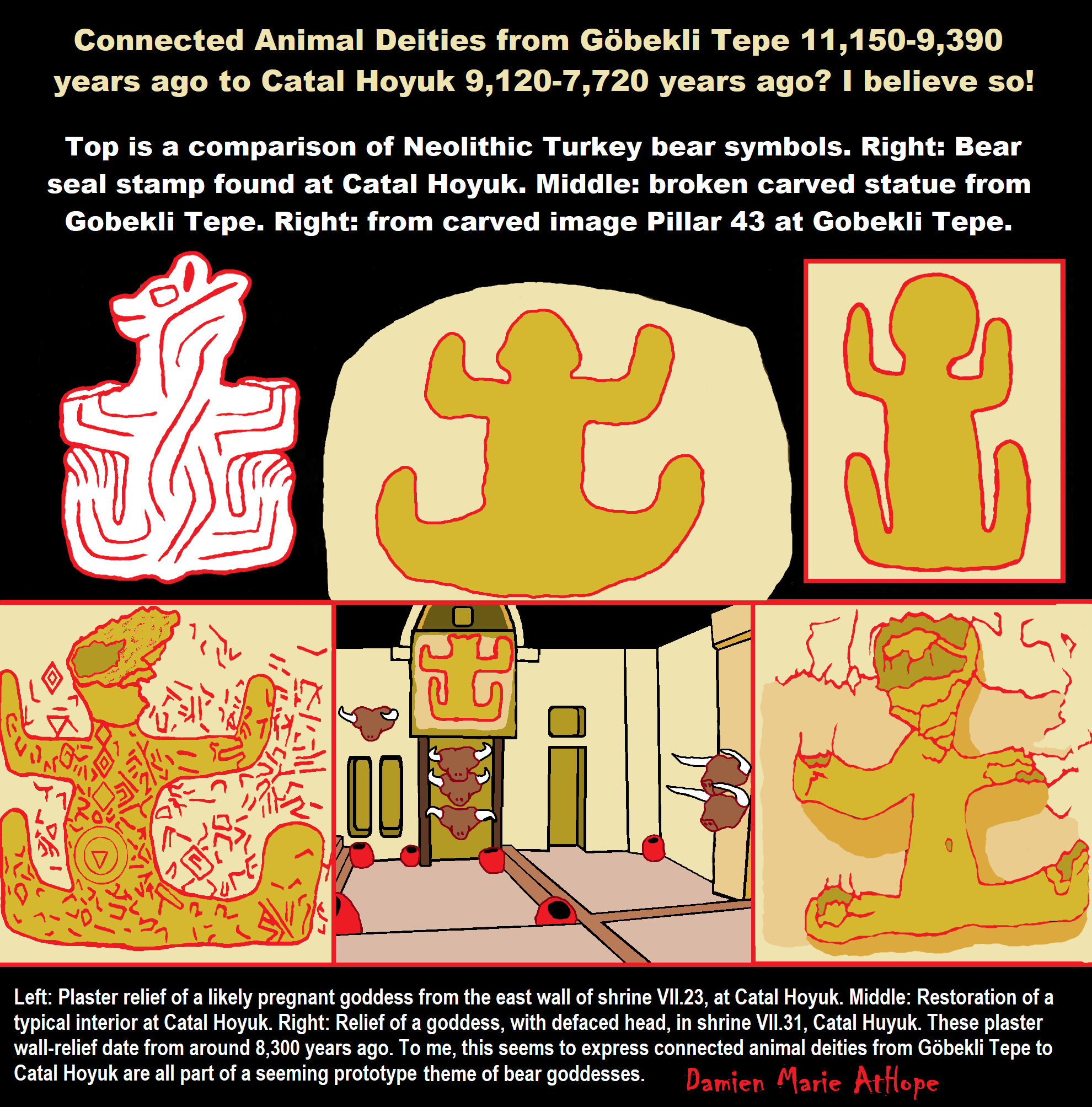
Animal Deities? Are the Bull symbol on the side and the big cat a Possible Type of or similar to a Tutelary Deity? Then there is yet another grouping of three animals, one being an odd bulged head bull, could they possibly be a Type of or similar to Tutelary Deities?
Göbekli Tepe involves a male-dominated society?
“So far, every known depiction – as long as their sex is clearly recognizable – seems to be male, be it animals or humans. The only exception is a later added graffiti of a single woman on a stone slab in one of the later PPN B buildings. While this may somehow denote the site of Göbekli Tepe as a refuge of male hunters, it does, of course, not at all mean that women did not play a role in PPN society. There is a wide range of finds clearly connected to women in the contemporary settlements for instance – however, at Göbekli Tepe they (respectively their activity) remain invisible as of yet.” ref
I see a similarity in the bear art that I think could be female as well as doing the same spread leg gesture.
Women and Sacred (BEARS) Animals?
“In the “hunters’ religion” preserved among the northern Finno-Ugric peoples, bear ceremonies are central. The Khanty, Mansi, Nenets, Sami, Finns, and Karelians have all been acquainted with myths and rites connected with the bear. The myths recount that the bear is of heavenly origin and is the son of the god of the sky; it descends from heaven and, when it dies, returns there. There is also a story about a marriage between a bear and a woman from which a tribe of the Skolt Sami (in Finland) is said to be descended. The bear-killing ceremony is divided into two acts—the killing itself and the feast afterward. Killing a bear that was protected by a forest guardian spirit involved a complicated ritual, which ended with bringing the bear home. Women believed that they had to keep at a distance so that the bear would not make them pregnant.” ref
Ancestor veneration in China: “Chinese traditional primordial religion” has been defined as the traditional religious system organized around the worship of ancestor-gods. Chinese ancestor worship, or Chinese ancestor veneration, also called the Chinese patriarchal religion, is an aspect of the Chinese traditional religion that revolves around the ritual celebration of the deified ancestors and tutelary deities of people with the same surname organized into lineage societies in ancestral shrines. Ancestors, their ghosts, or spirits, and gods are considered part of “this world”, that is, they are neither supernatural (in the sense of being outside nature) nor transcendent in the sense of being organized beyond nature. The ancestors are humans who have become godly beings, beings who keep their individual identities. For this reason, Chinese religion is founded on the veneration of ancestors. Ancestors are believed to be a means of connection to the supreme power of god Tian as they are considered embodiments or reproducers of the creative order of Heaven.” ref
“A household deity is a deity or spirit that protects the home, looking after the entire household or certain key members. It has been a common belief in pagan religions as well as in folklore across many parts of the world. Household deities fit into two types; firstly, a specific deity – typically a goddess – often referred to as a hearth goddess or domestic goddess who is associated with the home and hearth, with examples including the Greek Hestia and Norse Frigg. The second type of household deities are those that are not one singular deity, but a type, or species of animistic deity, who usually have lesser powers than major deities. This type was common in the religions of antiquity, such as the Lares of ancient Roman religion, the Gashin of Korean shamanism, and Cofgodas of Anglo-Saxon paganism.” ref

I view these art scenes as hunting cult behavior of the early paganist males with a totemistic type of warrior-shaman, in demonstrations of bravery taunting and ritually playing with strong animals such as bears and bulls. Cult ritual, not just standard hunting. None of the average male hunters are depicted as wearing a leopard skin crown. It is thus a special or elite thing to wear a leopard skin crown and only a few have this. Moreover, I see this not as standard hunting for food but rather cult ritual hunting behaviors. At Catal Huyuk, some of the cultic hunting scenes depict possible goddesses, female shamanistic pagan figures, or female ancestor spirits. However, possibly it could be all of these characteristics, which was a female ancestor spirit of a female shaman that turned into a goddess or demigoddess protector. Is there one ancestor goddess or demigoddess in each of these three hunting scenes? Well, I think it likely could be so or at least something like that as all others seem to be men. ref, ref, ref, ref
To me, my referencing of Catal Huyuk cultic hunting totemistic “warrior-shaman” type it meant to be similar in some ways to the Norse and Germanic peoples paganistic shamanism that involved a sacred trance-like battle-fury closely linked to a particular totem animal, which for Catal Huyuk males was seemingly the leopard (wearer of “leopard -shirts”) and whom I surmise believed they drew their power from the leopard and were devoted to leopard cults. Viking Age “warrior-shamans” had two main totem animal groups, such as the berserkers (wearer of “bear-shirts”) who thought they drew their power from the bear and were devoted to bear cults and ulfheonar (“wolf-hides”) who thought they drew their power from the bear and were devoted to bear cults. Moreover, the wolf type of warrior-shamans appears among the legends of the Indo-Europeans, Turks, Mongols, and even Native American cultures. ref, ref
Cultic Hunting at Catal Huyuk “first religious designed city”
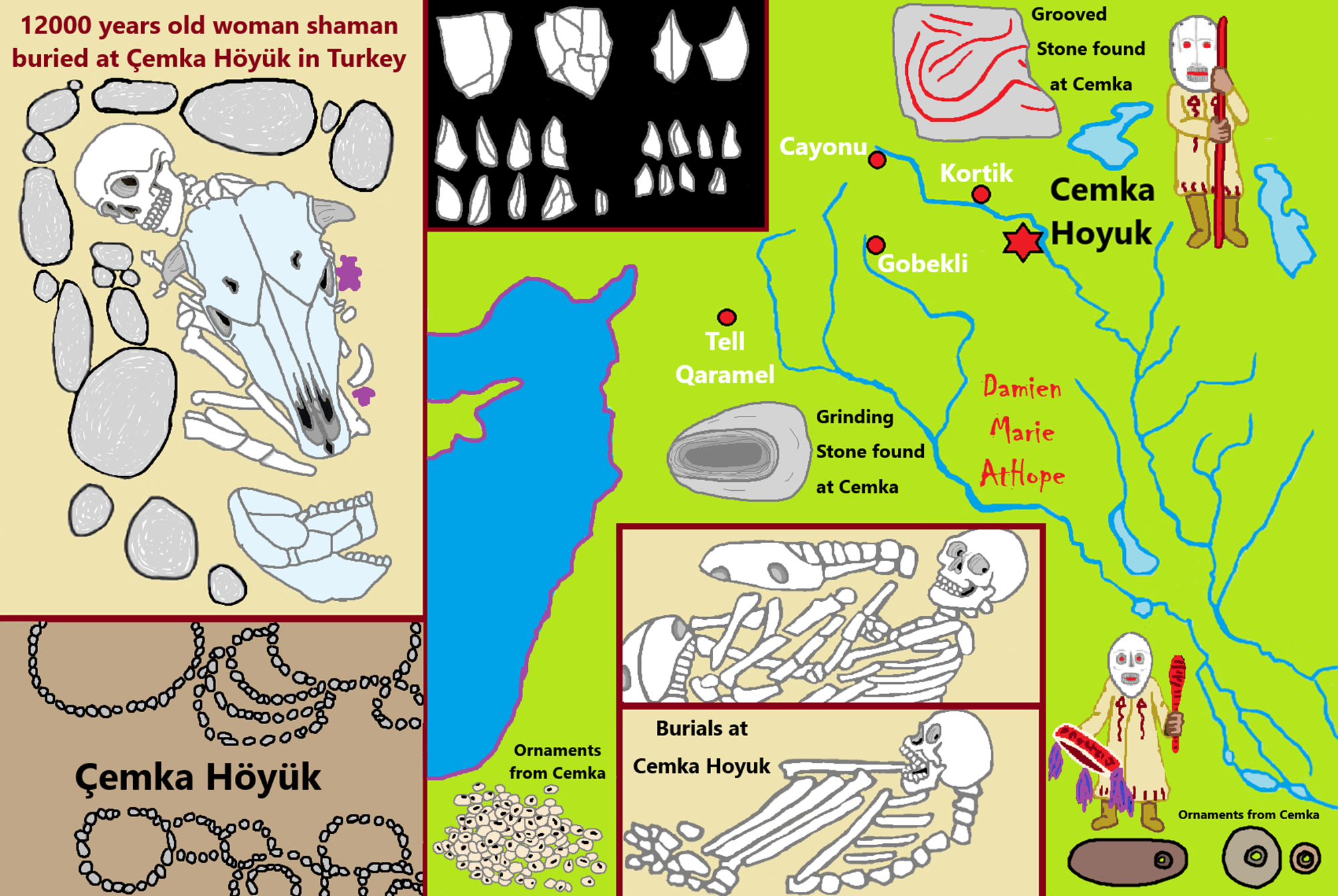
12,000 years ago, a shaman woman was buried at Çemka Höyük in Turkey, similar to others, like the 12,000 shaman woman burial in Israel as well as the phenomenon of Shamanism and the feminine

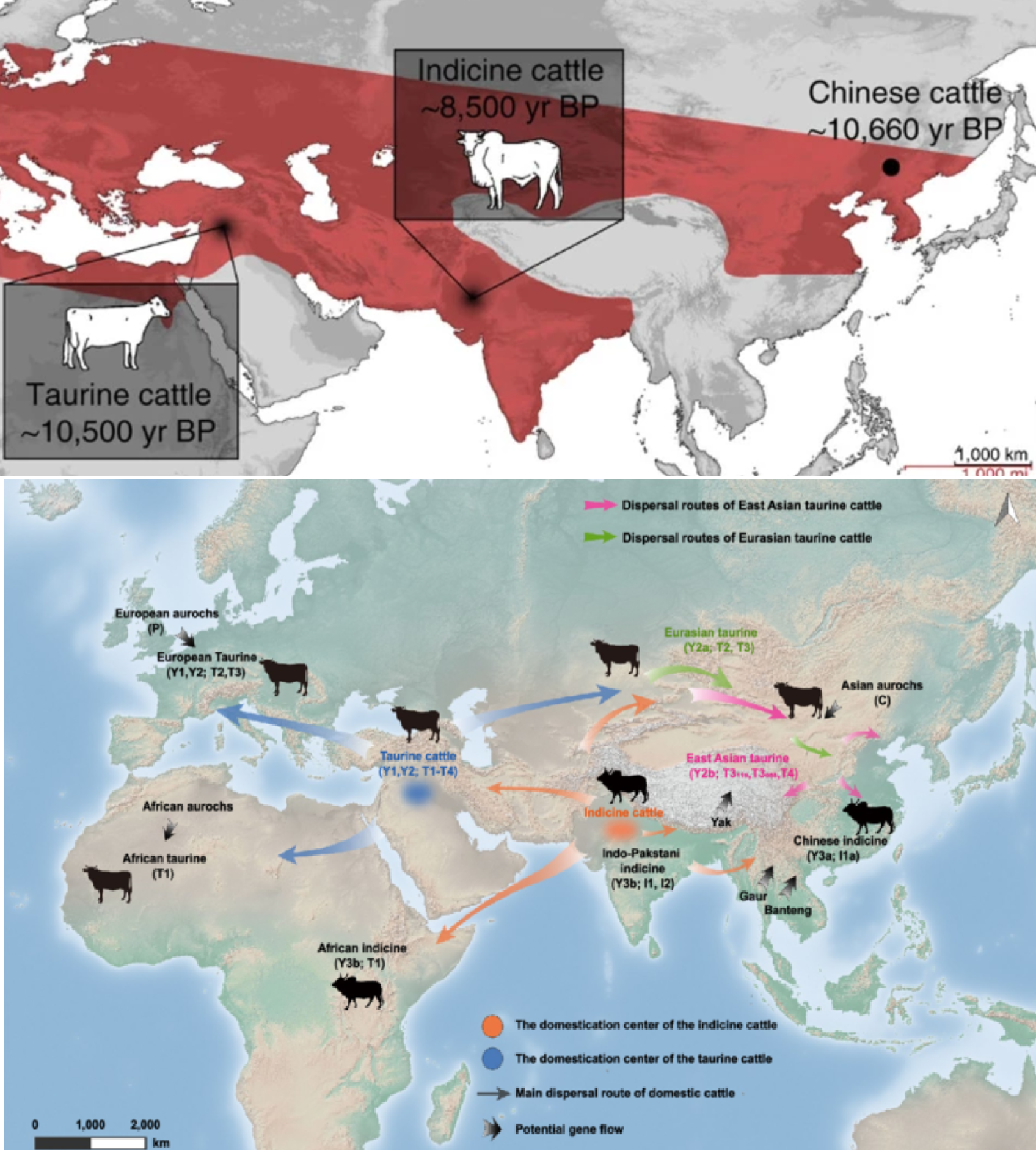

“Approximate migration route and the origin of Africa domestic cattle. Circle regions represent the expected center of cattle domestication. Migration route from outside Africa and within Africa was shown by color arrows, and the color of the arrow represents the migration time and its origin.” ref
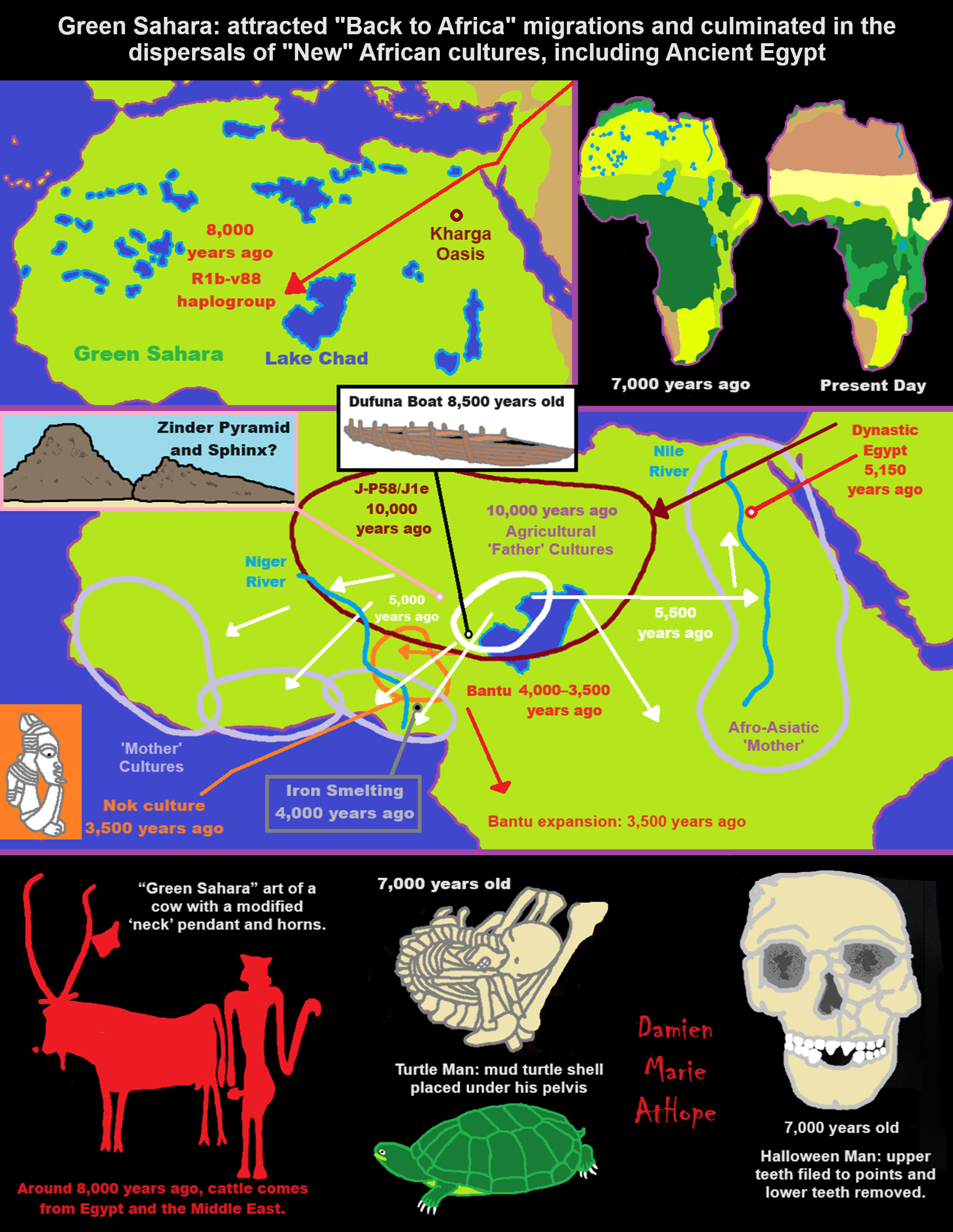
Cattle
“Cattle (Bos taurus) are large, domesticated, bovid ungulates widely kept as livestock. They are prominent modern members of the subfamily Bovinae and the most widespread species of the genus Bos. Mature female cattle are called cows and mature male cattle are bulls. Cattle are commonly raised for meat, for dairy products, and for leather. As draft animals, they pull carts and farm implements. Around 10,500 years ago, taurine cattle were domesticated from wild aurochs progenitors in central Anatolia, the Levant, and Western Iran. A separate domestication event occurred in the Indian subcontinent, which gave rise to zebu. The term cattle was borrowed from Anglo-Norman catel (replacing native Old English terms like kine, now considered archaic, poetic, or dialectal), itself from Medieval Latin capitale ‘principal sum of money, capital’, itself derived in turn from Latin caput ‘head’. Cattle originally meant movable personal property, especially livestock of any kind, as opposed to real property (the land, which also included wild or small free-roaming animals such as chickens—they were sold as part of the land).” ref
“The word is a variant of chattel (a unit of personal property) and closely related to capital in the economic sense. The word cow came via Anglo-Saxon cū (plural cȳ), from Common Indo-European gʷōus (genitive gʷowés) ‘a bovine animal’, cf. Persian: gâv, Sanskrit: go-. In older English sources such as the King James Version of the Bible, cattle often means livestock, as opposed to deer, which are wild. Cattle have played a key role in human history, having been domesticated since at least the early Neolithic age. Archaeozoological and genetic data indicate that cattle were first domesticated from wild aurochs (Bos primigenius) approximately 10,500 years ago. There were two major areas of domestication: one in central Anatolia, the Levant, and Western Iran, giving rise to the taurine line, and a second in the area that is now Pakistan, resulting in the indicine line. Modern mitochondrial DNA variation indicates the taurine line may have arisen from as few as 80 aurochs tamed in the upper reaches of Mesopotamia near the villages of Çayönü Tepesi in what is now southeastern Turkey, and Dja’de el-Mughara in what is now northern Syria.” ref
“Although European cattle are largely descended from the taurine lineage, gene flow from African cattle (partially of indicine origin) contributed substantial genomic components to both southern European cattle breeds and their New World descendants. A study on 134 breeds showed that modern taurine cattle originated from Africa, Asia, North and South America, Australia, and Europe. Some researchers have suggested that African taurine cattle are derived from a third independent domestication from the North African aurochs. Whether there have been two or three domestications, European, African, and Asian cattle share much of their genomes both through their species ancestry and through repeated migrations of livestock and genetic material between species, as shown in the diagram.” ref
“Cattle were originally identified as three separate species: Bos taurus, the European or “taurine” cattle (including similar types from Africa and Asia); Bos indicus, the Indicine or “zebu”; and the extinct Bos primigenius, the aurochs. The aurochs is ancestral to both zebu and taurine cattle. They were later reclassified as one species, Bos taurus, with the aurochs (B. t. primigenius), zebu (B. t. indicus), and taurine (B. t. taurus) cattle as subspecies. However, this taxonomy is contentious, and authorities such as the American Society of Mammalogists treat these taxa as separate species.” ref
“Complicating the matter is the ability of cattle to interbreed with other closely related species. Hybrid individuals and even breeds exist, not only between taurine cattle and zebu (such as the sanga cattle (Bos taurus africanus x Bos indicus), but also between one or both of these and some other members of the genus Bos – yaks (the dzo or yattle), banteng, and gaur. Hybrids such as the beefalo breed can even occur between taurine cattle and either species of bison, leading some authors to consider them part of the genus Bos, as well. The hybrid origin of some types may not be obvious – for example, genetic testing of the Dwarf Lulu breed, the only taurine-type cattle in Nepal, found them to be a mix of taurine cattle, zebu, and yak.” ref
“The aurochs originally ranged throughout Europe, North Africa, and much of Asia. In historical times, its range became restricted to Europe, and the last known individual died in Mazovia, Poland, around 1627. Breeders have attempted to recreate a similar appearance to the aurochs by crossing traditional types of domesticated cattle, producing the Heck breed. A group of taurine-type cattle exist in Africa; they either represent an independent domestication event or were the result of crossing taurines domesticated elsewhere with local aurochs, but they are genetically distinct; some authors name them as a separate subspecies, Bos taurus africanus. The only pure African taurine breeds remaining are the N’Dama, Kuri, and some varieties of the West African Shorthorn.” ref
“Feral cattle are those that have been allowed to go wild. Populations exist in many parts of the world, sometimes on small islands. Some, such as Amsterdam Island cattle, Chillingham cattle, and Aleutian wild cattle have become sufficiently distinct to be described as breeds. From early in civilisation, cattle have been used in barter. Cattle play a part in several religions. The ox is one of the 12-year cycle of animals which appear in the Chinese zodiac. The astrological sign Taurus is represented as a bull in the Western zodiac.” ref
“New zooarchaeological discoveries in the Middle Nile support the scenario that proto-pastoralist communities arrived from the sub-Saharan region with large ruminants at the beginning of the Holocene. Although cattle were domesticated slightly later than sheep and goats, they seem to be an extremely important species in the history of mankind in Eurasia and especially in Africa. Until now, it has been accepted that domesticated cattle arrived in Africa in 6000 BCE or around 8,000 years ago from the Middle East. New osteometric data from Letti Desert 2 (LTD2) in Sudan analysed through point-scale method as well as age-profile suggest that cattle could had been domesticated independently in Africa at the same time as in the Middle East, that is around 10,000 years ago.” ref
“Currently, the oldest archaeozoological evidence of domestication of the wild ancestor of cattle – the aurochs (Bos primigenius) comes from the Middle Euphrates and is dated to 10,000-9,000 BCE. The identification of the wild ancestor, the aurochs, from domesticated cattle is relatively straightforward, based on the change in body proportions and, above all, the reduction in size with the disappearance of sexual dimorphism. However, the identification of animals in the early stages of domestication is a highly complex task that requires multi-faceted contextual studies. Such studies must take into account a number of natural factors, including climatic changes, the hunting impact, and those resulting from herding, such as selection.” ref
“Although studies employing statistical analyses of osteometric data or age-of-death profiles are beset with significant shortcomings, they have proved invaluable for identifying the early stages of domestication. This is particularly the case when changes in sexual dimorphism in cattle in western Asia are under consideration. Nevertheless, this kind of comprehensive research and examination of morphological alterations within early cattle populations is only feasible in the Middle East, where access to extensive archaeozoological collections and a multitude of chronologically and ecologically consistent sites is far greater than in the Nile Valley.” ref
“Genetic studies also play a pivotal role in the cattle domestication debate. The prevailing theory suggests that cattle around the world are descendants of a small population of aurochs domesticated around 11,000 years ago in the Middle Euphrates zone. From there, via Sinai, at the turn of 7/6 millennium BCE, cattle and other domesticated animals, such as sheep, goats, and pigs, are thought to have spread across Africa. Thus, the prevailing view currently encountered in academic discourse is that the domestication of animals in Asia, Europe, and Africa was a homogenous process “invented” in the Middle East, from where the know-how or the animals themselves spread with humans.” ref
“Half a century ago, based on discoveries made in the Southwest of Egypt (Nabta Playa in Western Desert), a hypothesis was proposed about the possibility of local cattle domestication in Africa. Although it was supported by ecological, archaeological, linguistic, and some genetic evidence, the hypothesis was poorly supported by direct osteological data. The very early dating (9-8 millennium BCE) of the Nabta Playa sites, the lack of conclusive, statistically significant osteological data, and the generally limited state of research on early Holocene settlement in North Africa led to the rejection of the idea of domestication of cattle in Africa.” ref
“Intensive genetic research conducted in the early 21st century additionally ruled out the domestication of cattle in Africa, even though it was assumed for a long time that the African aurochs (Bos primigenius opistonomus/africanus) influenced the genotype of modern African cattle. Due to natural conditions (high temperatures, extremely dry climate), ancient DNA from African aurochs and an early form of domestic cattle has been very difficult to obtain and analysed to a very limited extent. The first and the only genomic data to date from a single aurochs from 9000 years ago comes from Morocco. The earliest autosomal genomes and mitogenomes of African domestic cattle come from bones dated between 2800 and 2000 years ago, but it should be noted that positive genetic results are usually only obtained from 300 (!) year old remains. Research is therefore almost exclusively based on modern genetic material or fossil data from outside Africa.” ref
“Today, nearly 500 million people around the globe sustain themselves through itinerant pastoralism; half of them are Africans. The emergence of cattle herding in Africa marked a key moment in the continent’s history. Pastoral communities with complex social systems are perceived as the main element that initiated the emergence of the oldest civilisations in the Northeast of Africa. Also, today, a complex system of herding fundamentally affects the economy, society, and demography of sub-Saharan and East Africa. Yet, in the academic discourse to date, the picture of Neolithic communities focused on crop cultivation and sedentary farming has placed herding on the margins of the global debate about neolithisation and the origins of the process of animal domestication.” ref
“In this article, we revisit the thesis that cattle domestication took place in Africa at the same time as in the Middle East and that African pastoralism could has a native origin, supporting it with new zooarchaeological findings. A key element is the data from Letti Desert 2 (LTD2) site in North Sudan, published in details for the first time and dated with a consistent series of radiocarbon dating to the mid- 8th millennium BCE. Due to the very limited collection of osteological and osteometric data, the findings from Letti cannot provide a final proof for the local domestication of cattle in Africa. They are circumstantial evidence and a factor which suggests that we should not close the debate and continue our archaeozoological and archaeological research to test the hypothesis that independently of the Middle East, communities may have taken steps to control wild cattle herds in order to secure access to meat or perhaps other benefits.” ref
“The LTD2 site was discovered in 2022 during surface surveys in the Letti Basin, Middle Nile. It is located on an elevation that is part of the edge of a plateau overlooking one of the ancient watersheds of the Nile. During two field seasons, the work focused on the trench designated LTD2/A (10 × 5m). Three stratigraphic horizons were distinguished at this site. The clusters of human bones found on the surface were identified as relics of burials eroded by deflation. We assume that the burials were a part of a Neolithic cemetery with its core area excavated by about 180 m to the east (LTD2/B – Fig. 3C). The radiocarbon dating of these remains indicates inhumation in the 5th or 4th millennium BCE. Therefore, we should assume that the current surface layer in area LTD2/A includes remains of settlements from the early Holocene and relics of later activities (isolated fragments of pottery, stone tools, and deflated burials). For this reason, in further analysis, materials from this horizon (i.e., from Loci 1 and 2) are treated as contaminated, although containing early-Holocene materials (cattle remains included).” ref
“The most important bone materials discussed in this paper come from subsurface layers and cut features (Loci 3–5) of 0.5m thickness in total. In these layers we found numerous fragments of technologically and typologically homogeneous ceramics ornamented with alternate pivoting stamp, lithic artifacts dominated by the cutting inserts of composite tools, and mineralized animal remains (Table 1). Ostrich eggshell (OES) beads and a small clay zoomorphic figurine were manifestations of non-utilitarian art. The assemblage of cultural artifacts from the Early Holocene settlement of LTD2 differs significantly from the most abundantly recorded collections from Mesolithic sites in the region. Radiocarbon dating of ostrich egg pieces found at each level (surface including) indicate, in most cases, that the 8th millennium BCE was a period of at least several phases of settlement. Two samples (Poz-164652, Poz-164653) suggest a more recent chronology (turn of the 7th and 6th millennia BCE). However, these last results were obtained from the analysis of carbonate fractions of dentin and enamel from cattle (none of these samples were burnt). Therefore, they may reflect the age of secondary processes (recrystallisation) long after the death of the organism.” ref
“Meanwhile, the deepest horizon – Locus 6 was a layer of rock debris combined with silt, which formed the natural substrate in the early Holocene. It still contained a trace amount of early Holocene relics (lithics, single potsherds). We analysed a total of 2402 animal remains, including invertebrates and vertebrates, using archaeozoological methods. The remains were well-preserved, wherever coming from the current surface (Loci 1–2) or subsurface levels (Loci 3–5) with fragmentation primarily resulting from anthropogenic activities. Thus, we assume the whole collection of animal remains is homogenous and came from early-Holocene settlement (what is confirmed by coherent OES dating). The bones were partially mineralized and have a thin layer of calcite on their surface. Animal remains were subject to taxonomic and anatomical identification as well as the identification of the size class, body sides, and body parts. They were also assessed in terms of age at death, sex, and morphological characteristics of the animals.” ref
“Where the necessary morphological characteristics were preserved, osteometric data were collected according to standardised protocol. The NISP classification, the minimum number of elements, and the standardised minimum number of animal units (%MAU) were used to estimate the quantification methods. The remains from LTD2/A displayed an advanced level of mineralization, which caused the ZooMS and DNA analyses to fail. Various statistical methods adapted for the analysis of morphological and osteometric data are being used in archaeozoology, the most popular is the LSI scaling technique. However, due to limited cattle metric data set from LTD2, with no measurements homogeneity (longitudinal, latitudinal, anatomically diverse), we chose the point scale method, which has been successfully used for three decades in studies in Central Europe, the Middle East and NE Africa. It allows us to use all the bone measurements we obtained for comparison. The method is described in details below (sections Archaeozoological analysis/Morphological analysis).” ref
“In terms of morphology and size, the cattle discovered at LTD2 correspond to indigenous African cattle. These were large primigenic cattle (c. 130–150 cm WH). The osteometric data for cattle from LTD2/A that we registered fit well within the ranges of metric data for domestic cattle both from Neolithic (Wadi Khashab, 5th mill. BCE) and ancient Kerma (3rd -2nd mill. BCE) sites. The dimensions of the bones and teeth of the cattle in LTD2 fit into the medium-large range of dimensions of cattle from NE Africa. However, they are clearly larger than the dimensions of taurine cattle, that we observe in some Neolithic deposits and much later local cattle populations. The bones of cattle from LTD2 are also partly similar to the size of aurochs bones in the region, which may be due to the strong sexual dimorphism in the aurochs.” ref
“This feature has so far contributed to the difficulty of unequivocally identifying cattle domestication in archaeozoological studies in Africa, although in-depth analyses of morphological features in terms of sexual dimorphism in the Middle East have been successful in identifying the early stages of cattle domestication. We have identified cattle remains based on characteristic details in the skeleton, and comparative collections. The identification of cattle (Bos) in this case is not in doubt, not least because the only morphologically similar bovid species – the buffalo (Syncerus caffer) – is not reported in Early Holocene faunal material in the Middle Nile Valley, but is recorded southerly, in central Sudan. Detailed analyses of buffalo ecology highlight that it was more adapted to the forests and savannas of sub-Saharan Africa, suggesting that its geographical range rarely included the Nile Valley.” ref
“Discoveries of relatively rich collections of aurochs remains at Late Pleistocene sites in the Middle Nile Valley attest to the southern range of this species, much further than previously assumed. The identification of domesticated cattle features is much more problematic. Due to the availability of osteometric data, it was possible to compile a summary considering metric data of Pleistocene and Holocene aurochs from the Nile Valley, and rich collections of undoubted domesticated cattle from NE African sites dated to 5,000-1,000 BCE. It was therefore necessary to support our studies with other proxies. The age-at-death profile for cattle from LTD2 provides such support. Cattle was the only group of animals from LTD2 in which we find the remains of very young (around 6 months) and immature (3–4 years) individuals together with the remains of mature individuals. The remains of all other wildlife species (antelopes, warthogs, porcupines, etc.) were exclusively from mature individuals. Herd reduction through the elimination of redundant juveniles: males and females after calving, is considered one of the primary markers of ruminant domestication.” ref
“Over 10,000 years ago, groups of people returned to the Middle Nile after millennia of a late-Pleistocene settlement hiatus. They settled in LTD2, among other places. Their return coincided with dynamic climate changes involving the northward shift of the monsoon range and the savannah zone. According to our findings based on environmental studies, the behavior of these communities was related to the exploitation of the Sudan Savannah Zone ecosystem. Animals of the Bos genus arrived in the Nile Valley the same way. They, along with the local antelope and warthog species, were one of the main sources of meat for humans.” ref
“However, they were the only animals to be killed at various ages, also when young. A behavioral/settlement link with natural pasture ecosystems for herds of herbivores and particularly with the cattle lead us to identify these groups as proto-pastoralists. The term ‘proto-pastoralist’ appears in a variety of research contexts, particularly related to the transition from hunter-gatherer communities to more structured forms of herd management. It can be posited that an intensification of interspecies relations was occurring, though this still did give a limited alterations in the cultural system and, on the second side, in animal morphology. It would be inaccurate to characterise the Early Holocene communities of Letti as pastoralists, but we do see features of nomadism in them and a close association with herds of (wild?) cattle.” ref
“In the 7th millennium BCE, which was significantly later than the arrival of the hypothetical proto-pastoralists we have introduced to the debate, settled communities appeared in the region. The behaviour of these new communities was associated with the exploitation of exclusively wild elements of the aquatic and coastal environment, hence they were referred to as Mesolithic/Aqualithic in earlier publications. Both the proto-pastoralist communities and those described as Mesolithic were producing ceramic vessels, albeit representing markedly different traditions (Mesolithic “Karmakol” ware commonly tempered with chaff or mica. The early Holocene communities appeared by the Nile in the region of the so-called Nile Great Bend where the three dry valleys connecting the Nile, Kordofan (Wadi el- Melik), and the Mega-Chad (Wadi Howar) zone converge. Throughout subsequent millenia, they served as excellent migration routes, providing seasonal access to resources, namely, plants and water.” ref
“The communities of the 8th millennium BCE inhabited the Nile Valley selecting specific fertile areas, called “basins”, including Letti and Selima. This is evidenced by archaeological records from LTD2 and el-Barga sites. These are regions in which, in a slightly later period (6-5 millennium BCE), the formation of increasingly large necropolises, e.g. R12, Kadruka was observed. The feature linking the studied communities from the 8th and 5th, as well as the 3rd millennium BCE is the significant role of cattle in the economy, symbolism, and burial practices. From 2000 BCE these animals were widely replaced with significantly smaller taurine cattle in the Middle Nile area. Due to progressing climate and environmental changes, since the 3rd millennium BCE, there has been a shift of pastoral communities, in which cattle were used in many areas of ritual, social, and economic life, away from the Nile and further to the South.” ref
“Beef was the staple of the diet of religious and social elites also in later periods of Nubia’s history, even though environmental conditions were unfavourable to breeding cattle locally (desertification). The analysis of strontium isotopes in cattle from sites of the Kush civilisation (1000 BCE – 350 CE) and later – up to the post-medieval times, provides clear evidence that a significant part of the population originated outside of the Nile Valley. New paleontological and archaeological discoveries indicate that the relationship between humans and cattle in Africa has a much longer history than previously assumed. One hypothesis suggests that the remains of Pleistocene aurochs discovered in North Africa are usually associated with Acheulean sites (1.7–0.13 Mya) and migrations of the Homo erectus towards Europe. Discoveries from the Middle Nile Valley indicate that at the time of our species Out of Africa, c. 50,000 years ago (MIS3) the area was inhabited by communities that seasonally specialised in hunting aurochs.” ref
“The results of our research led us to propose a thesis that at the time of the last drastic aridification (MIS2) in Central Africa refugial areas for the savannah ecosystem were preserved, e.g., in the Mega-Chad and Kordofan zones (Fig. 8). Finds of aurochs remains from Kashm el-Girba dating to over 8000 BCE support this assumption (Peters, 1989b). Hunting specialisation, recorded in the late Pleistocene, was hypothetically conducive to controlling herds of select animals, to following them, and to protecting them (theses already proposed at the dawn of modern science although since the mid-20th century superseded by the concept of the Neolithic Revolution). They could constitute a “living resource” and a safety net in emergency situations. This set of human behaviours could consequently promoted the transition to the early stage of domestication, without strong interference from behavioural, morphological, and physiological changes in the animals, as was the case in the Middle East. In the early Holocene, when the savannah extended to the Southern Sahara once again (Nicoll, 2004), people and the cattle previously isolated in the central part of Sahel migrated to the Nile Valley.” ref
“The zooarchaeological criteria commonly used to identify the local domestication of a species on the basis of morphology based on the frequency of occurrence of the remains of the wild ancestor in the osteological material; the so-called ‘intermediate form’ and the remains of animals showing signs of domestication (e.g. reduced size, altered proportions, lack of horns). The large reduction in size of the animals could have been caused, in addition to ecological factors, either by hunting selection, by a drastic change in the diet of the domesticated animals, and by natural or deliberate selection. This direction of morphological change was favourable for agricultural communities living in dense settlements, such as those typical of the Fertile Crescent. African cattle populations, may have been subject to a different model of evolution, because of the different model of pastoralism has developed in sub-Saharan Africa, namely nomadic pastoralism. In this model, under the ecologically favourable conditions of the early Holocene, there may not have been drastic changes in the diet and behaviour of animals compared to their wild ancestors, nor in their morphology as a result of deliberate selection.” ref
“Consequently, there are no factors that could cause rapid and very pronounced morphological changes, such as a reduction in body size or proportions. This is supported by zooarchaeological and osteometric data. The size of African aurochs corresponds in part to that of early cattle. Of course, both archaeozoological and ethnographic data suggest that a marked reduction in size of cattle in pastoralists herds can also be observed, but this is more likely to apply to assemblages much younger than the 8th millennium BCE. As can be seen, the application of identification criteria based on morphological traits, as defined for studies in the Middle East, cannot provide satisfactory results in Africa. If these criteria are applied, only the taurine cattle from Southwest Asia, which appeared by the Nile only in the 6th millennium BCE, can be recognised as “fully” domesticated.” ref
Early North African Cattle Domestication
“Nearly four decades have passed since an independent North African centre for cattle domestication was first proposed in 1980, based on the Combined Prehistoric Expedition’s work in the Nabta Playa—Bir Kiseiba region of southern Egypt, and the initial rigorous debates between Andrew B. Smith and Fred Wendorf, Romuald Schild and Achilles Gautier. More recently, geneticists have entered the fray with determinations on the spread of haplotypes, and the timing thereof, that extend the scope and increase the complexity of the debate. Here, a new look at the botanical data and a re-analysis of the geology of Bir Kiseiba–Nabta Playa rejects the ecological foundations of the early African domestication model, while a detailed examination of the published osteological and radiometric data from the same area reveals a more nuanced picture than has been recognised to date. These results are placed into context by a wider review of the genetic and other archaeological evidence from the Western Desert of Northeast Africa, where no other cattle remains designated as domesticated have been found. It is concluded that (a) Bos remains from the early Holocene at Nabta Playa—Bir Kiseiba were those of hunted aurochs; (b) domesticated caprines were likely present in Northeast Africa before domesticated cattle; and (c) the domesticated cattle spreading across Northeast and northern Africa, including Nabta Playa—Bir Kiseiba, from the late seventh millennium BC or early sixth millennium BCE onwards were descendants of Bos taurus domesticated in the Middle Euphrates area of the Middle East.” ref
“This paper presents a reassessment of the botanical, faunal and geomorphological data from Nabta Playa—Bir Kiseiba to determine whether or not an early Holocene timeframe for cattle domestication, as proposed by the Combined Prehistoric Expedition, remains a plausible explanatory model. It begins with a summary of the arguments by the main scholars involved in the debate, to provide context, and an outline of the data brought to bear so far. In a paper in African Archaeological Review, addressing early cattle domestication, Stock and Gifford-Gonzalez agreed the DNA evidence favoured a Near Eastern origin for domestic cattle but, critically, they did not re-examine the geological and botanical data from Nabta Playa—Bir Kiseiba. Nor did their paper, or the Combined Prehistoric Expedition’s faunal reports, look at the stratigraphical distribution of the cattle bones from the area and their associated radiocarbon dates. I turn to the original geological report to argue that more water was present on the surface during the early Holocene than acknowledged in the early cattle domestication model, and draw upon additional geological reports, which have been little cited in the debate, in support. I also draw upon comparisons with other archaeological and modern semi-arid regions to refute the claim that the ecology of the Nabta Playa—Bir Kiseiba area during the early Holocene was capable of supporting only small game animals and gazelle, which is the underpinning of the early cattle domestication model.” ref
“The re-assessment also encompasses the middle Holocene of Nabta Playa. Wasylikowa’s botanical study of the middle Holocene botanical remains did not list the water requirements of all the families and genera of plants, which is done here. Nabta Playa’s faunal materials are also examined and evaluated. The radiocarbon distribution dates for the cattle remains are made explicit for the first time: using Gautier’s own measurements and distinction between morphologically domesticated and wild cattle, combined with the data from Smith’s and Grigson’s papers, the available data shows a later appearance for domesticated cattle at Nabta Playa—Bir Kiseiba than had previously been assumed. The results are then integrated into a review of the genetic and archaeological data from elsewhere in the Eastern Sahara, the current patterns in the study of domestication from the Near East and spread of domestic cattle and caprines in the Arabian peninsula. It is concluded that the first archaeological visibility of domesticated cattle derives from the mid sixth millennium BC onwards and that the most plausible explanation is that they originated from a founding population in the Near East, although the possibility of limited genetic introgression from African aurochs (Bos primigenius) is not ruled out.” ref
“The Combined Prehistoric Expedition argued and continues to argue for the remains to be assigned domesticated status (Bos taurus), on the basis that the reconstructed ecological conditions were inadequate for aurochs to have been supported without human intervention and control. It was this argument, and the presence of early pottery, which led them to designate these earliest occupation layers ‘Neolithic’. Their independent African domestication model hypothesised that these early Holocene cattle were brought from the Nile Valley, where there was adequate pasture and water, when the rains returned to the desert. The independent African domestication model has been extensively debated since 1980. The arguments have traditionally revolved around the criteria for determining domesticated status. Di Lernia and Smith have also underlined anthropological and terminological problems, while Usai has questioned the stratigraphic relationship between the few fragmentary early Bos remains and the radiocarbon-dated samples assigning them to the early Holocene.” ref
“Smith countered that an environment capable of supporting gazelles (Gazella dama, Gazella dorcas) and hares (Lepus capensis) would have provided enough vegetation cover for addax (Addax nasomaculatus), elephants (Loxodonta Africana), oryx (Oryx dammah) and rhino (Diceros bicornis, Ceratotherium simum), which can survive in dry climates. He also queried the absence of Bubal hartebeest (Alcelaphus buselaphus) amongst the Nabta Playa—Bir Kiseiba faunal remains when Bos primigenius and hartebeest are found together at Palaeolithic sites in the Nile Valley, where they co-inhabited similar ecological environments. Pasture and bodies of water adequate to support domestic cattle, gazelles and hares would also have been sufficient for larger semi-arid adapted animals such as oryx, addax, giraffe (Giraffa camelopardalis) and ostrich (Struthio camelus), which are amongst the animals present for parts of the year in the semi-arid Wadi Howar in northern Sudan. Elephants are present in parts of the Namib desert. Hartebeest occur in a variety of ecologies, including semi-arid environments. With no ecological zone known today containing only hares and gazelles, Smith contends that the faunal records at Nabta Playa are fragmentary and incomplete, but they could also simply reflect deliberate social choices. A well-known example of the latter is the early Holocene fauna from the Acacus Mountains where Barbary sheep (Ammotragus lervia) predominated.” ref
“Smith undertook an inter-regional comparative analysis of African and European wild and domestic Bos using the standard animal method, namely in this instance the metapodial distal width, and the distal width of the humeri. The results placed the cattle remains from the El Nabta/Al Jerar Maximum site of E-77-1 within the known size range for Bos primigenius. The subsequent Ru’at El Ghanam Middle Neolithic remains are ascribed by him to domesticated cattle. Consequently, Smith proposed an alternative model which claimed that domesticated cattle, sheep (Ovis ammon f. aries) and goats (Capra aegagrus f. hircus) arrived from the Near East shortly before 6000 BCE or around 8,000 years ago, in the late seventh millennium BC. In support, he also argued that indigenous, independent domestication of cattle in Northeast Africa would have entailed a radical shift in how animals are viewed and exploited amongst hunter-forager societies lacking a concept of human ownership of animals.” ref
“Although there was management of Barbary sheep during the Late Acacus period (c. 8100–6300 BCE) of the central Sahara, which may be construed as a form of ownership and a change from the way animals were viewed prior to the introduction of Near Eastern domesticates into North Africa, Smith counters that this was ‘probably as a result of long-standing predation strategies’, and states that: We must ask why these strategies did not continue towards domestication, as seen in the goats from Iran? Was it because domestic animals came in from the outside, making Barbary sheep irrelevant in the equation? Or was it because a lack of the sedentary stage around fixed resources, such as domesticated plants, did not result in the animal resources coming under pressure by increasing human numbers, requiring greater manipulation of the herds?” ref
“Consequently, he believes that this ideological shift towards private ownership with socially hierarchical communities occurred after Northeastern African hunter-collectors came into contact with trickles of immigrants from the Near East familiar with handling domesticates, resembling the way domestic stock were introduced into southern Africa. In an attempt to shed new light on this debate, Caroline Grigson re-examined the Bos remains from Nabta Playa—Bir Kiseiba. She compared the results with her measurements on wild and domesticated cattle fossil remains from the Nile Valley, and concluded that the Nabta Playa—Bir Kiseiba cattle fell within the range of Bos primigenius. However, her study has been criticized for failing to account for the possibility of size variability in Bos primigenius populations between her European, Levantine and Haua Fteah (North Africa) samples and their wild counterparts in the Nile Valley.” ref
“Additional criticism has been levelled at the employment of linguistic and mtDNA data in support of the early domestication model by Wendorf and Schild. The methodological basis of Christopher Ehret’s linguistic reconstruction has been criticised in general by Kevin MacDonald and, in specific regard to early Bos, by the current author: Ehret has bracketed a period around 8000 BCE or around 10,000 years ago for Proto-Northern Sudanic (part of the Nilo-Saharan language family), which includes words indicative of the exploitation of Bos. But such an analysis is risky as most linguistic roots describing wild or domestic Bos are neutral and the same words that later were applied to domesticated Bos may well have been originally applied to their wild ancestors.” ref
“The mtDNA originally analysed by Bradley et al. was claimed to reveal a late Pleistocene divergence between African and European Bos primigenius, supporting the hypothesis that African Bos primigenius were the primary source for the early Saharan domesticated cattle. Despite its subsequent incorporation by Wendorf and Schild into their early domestication model, the study did not shed light on the timing or the mechanisms involved in the domestication process. In conjunction with recent reviews of genetic data suggestive of introgression of Y-chromosomal data from African Bos primigenius into African Bos taurus descended from Near Eastern stock, a re-examination of the archaeobotanical, faunal and geomorphological data from the early and middle Holocene periods in the Nabta Playa—Bir Kiseiba region is appropriate in order to determine whether the ecological underpinnings of the early African independent domestication model are valid.” ref
Early Holocene Ecological Shifts in the Nabta Playa—Bir Kiseiba Region
“The Nabta Playa—Bir Kiseiba area is located within two different present-day rainfall zones of influence: the winter Mediterranean rainfall zone and the summer rainfall Inter-Tropical Convergence Zone (ITCZ). With the onset of what Haynes termed the ‘Neolithic pluvial’ or what others have called the African Humid Period or ‘Holocene optimum’, the ecology underwent a change from hyper-arid to semi-arid conditions. The ITCZ belt shifted c. 250 km northwards in the second half of the tenth millennium BCE; eventually, the isohyets shifted northwards by 400–550 km. By c. 8500 BCE or around 10,500 years ago, the Sahelian semi-desert zone had advanced up to the 24°N latitude, while Neumann states that summer rainfall occurred from the 22° latitude southwards. This was the start of the El Adam period at Nabta Playa (22°31′59″N), which was then on the new northern margin of the summer rainfall Sahelian belt. More broadly across the Sahara, fluvial networks developed which supported standing bodies of water, with temporal lags between increased rainfall and human re-occupation of the desert related to local geomorphological and hydrogeologic factors.” ref
“Deflated depressions became playas. Their water came from local recharging of the water tables, which caused them to rise above the new depressed ground level, or were sheetwash lying on top of the water table a couple of metres below ground level. Nabta Playa and, in particular, Bir Kiseiba, are examples of the former, and their water varied in intensity and volume affecting the extent of available vegetation cover. At Nabta Playa, the lower portion of the basin formed a large seasonal lake where ‘surface water would last for several weeks or months after the seasonal rains’. Remnants of the ancient shore lines have been found at El Gebel El Beid Playa to the Northeast of Nabta Playa, the Kiseiba escarpment, and other playa basins: ‘The formation of some of the Bir Kiseiba playas can probably be related to the truncation of the land surface by deflation almost to the level of the water-table during the Early Neolithic’.” ref
“In a little-referenced but important article, Haynes and Haas state that:
… remnants of beach deposits along the scarp indicate that some of these basins may have coalesced into larger lakes in early Holocene time sometime near 8250 BCE around 10,250 years ago. Playa mulls intermixed with aeolian sand make up the floor and in places, as at Nabta playa, are underlain by Pleistocene dunes believed to be overlying bedrock shale. Thus, with the onset of pluvial conditions, rainwater saturated the dunes and collected on the clay floor as sediments washed into the basin. With the return of arid conditions, the surface water evaporated, and the lacustrine deposits suffered deflation until limited by the shallow groundwater. Subsequent return to pluvial conditions would, via dune windows in the wind-scoured floor of the playa, recharge the local water table until a new lake had formed.” ref
“An annual precipitation of c. 100 mm would have been sufficient to have this effect, which challenges the notion that insufficient water was available to support more than small game animals. Today, acacia semi-desert scrub predominates on sand between the present-day 50 and 250 mm isohyets in the Sudan. A dense cover of grasses and herbs grows after the first consequential rains (July) and is complete at the end of the season (September). Panicum turgidum dominates the grasses and is particularly prevalent in the lower rainfall zones on sandy dunes which it stabilises. The Bayuda Desert, which is presently situated at the 100 mm isohyet that moved northwards to the vicinity of Nabta Playa, is dominated by acacia.” ref
“The brief seasonal showers provide forage particularly along wadis for Bayuda pastoralists’ light herds consisting mainly of sheep and goats and limited numbers of cattle. A little further north, acacia scrub is present in southwestern Wadi Halfa, while Acacia, Capparis decidua and Tamarix depend on groundwater in the interconnected Laqiya Valley, Wadi Shaw and Wadi Sahal, which received an annual rainfall of 5–10 mm. The presence of multiple plant species within modern-day semi-desert environments leaves open a possibility that the early archaeobotanical record from the Nabta Playa—Bir Kiseiba region may have been influenced by deliberate human selective activities. At Nabta Playa, signs of huts and remnants of hearths and numerous lithics were recently located on a phytogenic dune at Site E-06-1 and dated to as early as c. 8400 BCE. Despite the onset of more humid conditions, the El Adam and subsequent El Ghorab phases still saw some eolian sand and phytogenic dune activity. E-06-1 and E-77-7 (at the neighbouring El Gebal El Beid Playa, radiocarbon-dated to 8424–7735 BCE) are the two El Adam period sites that have yielded viable botanical samples.” ref
“At E-06-1, the samples are from different plants with overlapping rainfall tolerances: Tamarix (75–500 mm); Citrullus colocynthis (perennial desert gourd which tolerates 250–1500 mm and irregular precipitation due to its long roots which can tap underground reserves of water); Echinochloa colona (400–1000 mm); and Poaceae grass. The nearby site of E-77-7 yielded 625 charcoal samples in which Tamarix was the only identified plant, which may potentially indicate that it was a preferred source of wood (if Tamarix nilotica), but it can also grow in monotype stands if the water table is no less than 8 m below the surface. Leguminosae (50–1800 mm) and Panicum turgidum (200–250 mm) seeds were also found. In addition, El Hadidi identified Salsola baryosma, Phragmites australis (an aquatic or subaquatic reed) and fibrous grass roots in the Lower Level at E-77-7.” ref
“Acacia and other tree or large bush species are not present in the very limited floral remains from E-06-1. Sahelian flora though is present in early Holocene levels to the south in northern Sudan at El Atrun, Oyo and Selima, which may indicate an incomplete botanical record from the El Adam phase at Nabta Playa. Acacia and Tamarisk are both able to survive in (semi-) arid conditions. Although there are modern oases in southwestern Egypt with only Tamarix, Acacia–Panicum and Tamarix–Stipagrostis were present along with denser herbaceous vegetation in wadis from the Acacus mountains during the middle Holocene of the Central Sahara. The tamarix monotypic stands in the oases are dependent on groundwater. This argument, combined with the presence of Phragmites australis at E-77-7 and geomorphological data from the Bir Kiseiba playas has implications not only for reconstruction of the early Holocene environment but also for the availability of water and vegetation at certain times of the year to support both humans and semi-arid adapted antelopes with similar or lesser water needs.” ref
“For the early independent African domestication model, the absence of hartebeest remains is particularly puzzling. Hartebeest are grazers surviving on grasses and legumes who inhabit dry savannahs, semi-arid grassland, and wooded grasslands. In areas with water scarcity, they derive moisture from melons, tubers, and roots for days or months. In other words, based on water resources and the availability of adequate pasture, hartebeest, which co-existed with aurochs in the Nile Valley, and other bovids such as oryx could have survived in the same ecological environment as the hypothetically domesticated Bos in the early cattle domestication model, although their remains (bar possible oryx in the wetter Ru’at El Ghanam Middle Neolithic) are not present in the recovered faunal assemblages.” ref
“The question of seasonal migration by the early occupants of the Nabta Playa—Bir Kiseiba area has most recently been addressed by Donatella Usai. Usai has proposed seasonal movement between Nabta Playa—Bir Kiseiba and the Second Cataract region of the Nile Valley. She points out the technological similarities between the El Ghorab and El Nabta industries and the Shamarkian group, and that the site of 11-I-13 in Wadi Karagan (Nile Valley) is strikingly similar to the El Ghorab. There are no domesticated cattle remains at Wadi Karagan. Despite the claim by Wendorf and Schild that there is no El Nabta/Al Jerar-like complex in the Nile Valley, Usai suggests that sites 626 and 628 to the west of the Nile were intermediary camps for hunter-forager peoples moving out of the Nile Valley during flood season, before they moved into the desert after the summer rains in an integrated cultural and ecological system. Based on these combined re-analyses, there is no ecological or Nile Valley archaeological evidence for the early Holocene inhabitants of Bir Kiseiba—Nabta Playa having incorporated habitually domesticated cattle into their socio-economy.” ref
The El Nabta/Al Jerar Maximum and the Ecology of Nabta Playa
The Afro-Asian monsoon grew stronger around the beginning of the El Nabta/Al Jerar Maximum. This resulted in an increase in the ground and surface water in the southern Western Desert. Maximum lacustrine conditions were reached more broadly across the Sahara up to 25oN at c. 6500 BCE or around 8,500 years ago. Botanical samples from this period are available from eight sites: seven from Nabta Playa and one (E-77-7) from El Gebel El Beid Playa. At E-77-7, Acacia ehrenbergiana, Hyphaene thebaica, Medicago sp., Salsola baryostna, Tamarix sp. and fibrous grass roots were recovered from the Middle Layer (ascribed to the El Nabta phase).” ref
“The Nabta Playa site E-75-6 yielded fruit and seed remains, together with wood charcoal, in greater quantity than at any of the other sites: c. 460 samples, including 371 bulk soil samples, collected in the 1990–1992 seasons, of which c. 439 were analysed. The site is described as composed of three levels: Upper, Middle and Lower. The single charcoal date of 9360 ± 70 bp from the Lower Level falls within the defined El Adam cultural entity and is listed by Wendorf and Schild as ‘entity questionable’. However, the first study of plant remains lists three types deriving from the Lower Level (El Adam phase). The majority of the plant remains derive from the Middle Level (El Nabta), while the remainder are from the Upper Level (Al Jerar). The site consists of the remnants of huts and pits covered by clays and silts. The remains were recovered both from three pits and from four hut floors where they were likely charred in or near hearths.” ref
“In total, 15 families with 65 taxa were identified from E-75-6, of which grasses, legumes, and sedges predominated. Wasylikowa measured the abundance, density, and frequency of occurrence of the seeds to determine their significance in reconstructing the ecology and potential use by the inhabitants. Human selective action was strong. Economic requirements (food and fuel) appear to have been the dominant reason for the presence of most of the specimens, while medicinal purposes and accidental inclusion from dung and hut construction cannot be ruled out. Many of the sedge species, although edible, grow in wet conditions and could be taken as reflective of local ecology. More broadly, however, as Wasylikowa noted, ‘The numerical relations between diaspores of different species do not correspond to those between species in the [wider landscape’s flora]. Any reconstruction of the former vegetation and paleoecological conditions is, therefore, strongly restricted by the origin of the material.’ It appears though to broadly reflect the diverse ecological conditions of adequate bodies of freshwater, grasses stabilising dunes, plenty of moisture, scrubland and aquatic species bordering shores that rose and fell with seasonal rains averaging 200 mm.” ref
“This phase saw the appearance of plant storage pits, which represent a shift to intensive harvesting and storage as part of a delayed-return economy. At E-75-6, there are c. 20 huts, more than 30 pits and a walk-in well dug to facilitate access to the underground water table, which argues for semi-sedentary occupations. Whereas the preceding El Adam and El Ghorab occupations occurred during summer, the more abundant El Nabta/Al Jerar semi-sedentary settlements are stated by the excavators to have spanned autumn to the onset of the summer rainfall. However, there are no unequivocal signs of intensive social differentiation, although it appears that broad-spectrum economic exploitation and delayed return occurred, which may have entailed socially-mediated and negotiated resource acquisition, laying the socio-ideological foundations for the inhabitants to be receptive to incorporating new forms of animal exploitation in the succeeding phases.” ref
“Gautier believes that their biochemical markings are indicative of a Middle Palaeolithic origin. Regardless, elephants are known from modern semi-arid and arid deserts such as the Namib Desert in Namibia. While areas in the Western Desert such as Abu Ballas, Gilf Kebir and the Selima Sandsheet, plus Wadi Howar and Wadi Shaw in the Sudan, have yielded remains of giraffe, giraffes are only present in the Late Neolithic faunal record at Nabta Playa, when there was greater aridification. However, no numbers are provided by Gautier. There is no ecological rationale for either species not to have been present during the early Neolithic, unless they were not being hunted to any great extent and their meat not brought back to the encampments along the playas.” ref
“Three fragments, including one distal metacarpal moiety from E-75-8, are identified as oryx; two of these fragments may also be addax. The latter two are from a mixed Ru’at El Ghanam or Ru’at El Baqar Humid Interphase and Late Neolithic deposit, while the other was found on the playa’s surface. Addax and oryx have similar distribution patterns. Both can live in arid and semi-arid ecologies, and oryx are frequently found in association with gazelle. At Tin Ouaffadene (Niger), oyrx are also found together with elephant remains. Oryx drink water where it is present and derive sustenance from acacia fruits and leaves, grasses and shrubs, and moisture from succulent bulbs and wild melons.” ref
“Therefore, addax or oryx, or both, were present at E-75-8 at a time when the environment was slightly wetter than in the early Holocene, but worse than during the Al Jerar Humid Interphase. Their remains have not been described from the faunal records of earlier phases. They should have been more abundant in the earlier faunal record if the full range of faunal diversity was represented, especially with the presence of water for a significant portion of the year, even more so as they are a companion to gazelle, with old males associating with dama gazelle herds. What this indicates is that the addax/oryx was either not hunted very often or it was hunted away from the camps and any remnants brought back to camp were not preserved, which further renders the faunal records unrepresentative of the diversity in the broader landscape.” ref
“Thirteen ‘domesticated’ caprines are assigned to the Al Jerar, but Gautier believes that these are more likely to be remains of Barbary sheep, while domesticated caprines are present from the Ru’at El Ghanam onwards. The caprine remains are very fragmentary or incomplete. For the Ru’at El Ghanam, the caprines are detailed from the excavated dune section of site E-75-8. Gautier’s Table 23.1 assigns them to site E-75-8 A (layers 1–3), subsurface, and spits 5–9. Spit 9 is the oldest, but there is no indication from Gautier of which spits contained caprine remains. However, information in this regard is provided by Close: Re-excavation of E-75-8 has confirmed the presence of domesticated sheep/goat in El Ghanam Middle Neolithic, specifically in the three upper spits, 5–7.” ref
“Unfortunately, the state of preservation of the bones precluded their being dated directly; this is not uncommon in extremely arid environments. Thus, strictly speaking, the possibility remains that the sheep/goat are intrusive from the overlying El Baqar Late Neolithic, but their distribution within the Middle Neolithic makes this possibility remote. If they were intrusive from above, then they would be most numerous in Spit 5 and would rapidly decrease in frequency below that. However, although the overall frequencies of bones in Spits 5 and 6 are essentially the same, the absolute number of sheep/goat remains in Spit 6 is twice that of Spit 5. We may, therefore, be confident that the domesticated sheep/goat really do date from El Ghanam Middle Neolithic.” ref
“At E-75-8, caprines are absent from Spits 8 and 9. They are present in Spit 7, which has the most cultural materials but in smaller numbers than in Spit 6. Disappointingly, the caprine numbers are not broken down by spit and Gautier’s table lumps Spits 5–9 together. Cattle appear later than the caprines. Remains from the 1977 excavation’s designated Unit 2 at E-75-8 are broadly bracketed to around c. 5600–5480 BCE or around 7,600 to 7,480 years ago, while pre-1990s excavation units 4 and 5 are part of the Late Neolithic. The cattle remains collected during and after the 1990 excavations are—for the Middle Neolithic—found on the boundary between the Ru’at El Ghanam Middle Neolithic and the Late Neolithic and in Spit 5. An instance for Spit 7 is labelled ‘one doubtful subadult sesamoid’ by Gautier.” ref
“At E-94-1N, at the northern end of the Nabta basin, lies a cluster of tumuli, nine of which have been excavated and contain articulated cattle remains. The earliest is the famous articulated cow tumulus of Site E-94-1N, with its burial pit and hypothesised wooden roof. Regularly cited as being dated to c. 5400 BCE, its radiocarbon date of 6480 ± 270 bp has a wide one sigma error range of 5976–4835 cal BCE. Potential animal tumuli also exist at Bir Murr 1 (110 km northwest of Nabta Playa), where three stone structures have been located. The structures reportedly have similarities to the Nabta Playa tumuli and are dated to c. 5250 BCE.” ref
“In addition, Gautier’s published analysis clusters the fragmentary early Neolithic Bos within the size range of small aurochs. Most of the highly fragmentary and poorly preserved Bos remains assigned to the El Adam, with the notable exception of two molars, are fragments of an adult phalanx and a cannon bone’s distal condyle from Site E-80-4, surface finds. This raises questions of their stratigraphical provenance beyond a generalised time period, due to the practice of excavating in artificial spits. Measurements for just five individuals attributed to the Ru’at El Ghanam show a shift for four to the lowest end of aurochs and within the uppermost range of domesticated cattle; the other measurement is firmly within the range of most of the measurements provided by Gautier for small wild aurochs from the early Neolithic, which could be read as hypothetical evidence for the presence of aurochs in this part of the Western Desert at this time. The later period measurements show a clear shift to domesticated cattle.” ref
“Gautier’s analysis produces similar results to Smith’s comparative metrical analysis, using the standard animal method, of aurochs samples from the Maghreb, Bos primigenius from Europe and Kom Ombo (Nile Valley), and domesticated Bos from Arlit (Sahara), the Maghreb and Europe, as well as modern zebu cattle from the Tilemsi Valley in Mali. Unfortunately, Gautier does not provide a breakdown of the distal condylar width of the humeri and the distal width of the metapodials by site or by period, and therefore most of the data behind Gautier’s analysis could not be overlaid on Smith’s for a like-for-like comparison. However, five cattle bones described in Gautier with comparative measurements were able to be included by Smith. Unfortunately, there are no good published images of the bones. The two El Nabta/Al Jerar specimens fall within the range of Bos primigenius while the Ru’at el Ghanam specimen is within the range of domesticated cattle for the metapodial widths, and likewise for the one El Nabta/Al Jerar and one Ru’at el Ghanam specimens respectively.” ref
“Grigson used the standard animal method but does not provide her measurements in mm, which precludes overlapping the data in her figures with Smith’s. Grigson also does not break down her measurements by period to look at temporal variances. However, it is important to note that some of Grigson’s measurements fall within the range of aurochs (of unspecified date) from the Nile Valley. While Grigson and Smith’s analyses have been criticised on the basis that a limited sample size from the Nabta Playa—Bir Kiseiba region could have skewed the results, due to inter-population size variability, it is noteworthy that all three analyses show that at least the earlier Holocene cattle from the area fall within the range of aurochs but not domestic cattle. Two analyses show that cattle remains from the middle Neolithic onwards are predominantly within the range of domesticated cattle.” ref
“Gautier, however, previously advanced a counter-argument against the use of size criteria to judge the domestic or non-domestic status of early Saharan cattle remains: ‘The early cattle of Nabta Playa and Bir Kiseiba are also large, but if we are dealing with an early phase of domestication, then the decline in size in response to poor ecological conditions may not yet have begun.’ Gautier repeats this argument. However, Linseele noted: While the Pleistocene African aurochs was as at least as large as its Holocene Danish cousin, the Holocene African aurochs was clearly smaller and would have reached only the size of the Pleistocene African females. The size decline recorded during the Holocene from northwestern to southeastern Europe and from there to the Near East appears to have continued down to Africa. Within northern Africa, aurochs size was variable. The available measurements point to a Pleistocene African aurochs that was at least as robust as its Holocene northern European relatives, although its successors from the Holocene may have been more slender.” ref
“Linseele also concluded that although the size of African Holocene aurochs was also more uniform than that of their Pleistocene counterparts, there is a slight overlap in size between large male domestic cattle from the modern Nile Valley and African Holocene aurochs. Linseele’s fig. 12 shows that the overlap is small, which correlates with the trend shown by Gautier and Smith, while Grigson’s analysis would be compatible with sexual dimorphic differences with large males and smaller females for middle and late Holocene domesticated cattle from Nabta Playa—Bir Kiseiba. Furthermore, the dates of the first appearance of cattle remains during the Ru’at El Ghanam Middle Neolithic place the decrease in size of domesticated cattle towards and at the end of the period, c. 5600–5400 BCE, after the first appearance of caprines. Taken together at face value, these measurements and dates mark the Post-Al Jerar Arid Phase as a juncture after which first small numbers of caprines and subsequently morphologically domesticated cattle become visible in the archaeological record in this region of the Western Desert.” ref
Signatures of Domestication, and Their Timing in the Adjacent Near East
“According to Zeder, the harvesting age profiles and the corresponding degree of sexual dimorphism are more relevant than previously traditional measurements in marking the onset of animal domestication. Male goats and sheep were targeted between the ages of two and three, which is a strategy reliant upon conserving the females and the presence of enough young males in surrounding wild herds to fill the vacancies. Later, as herding takes hold, females past their prime reproductive years are killed. Young males not required for reproductive activities are also disposed of, but their more friable bones are less likely to survive in the archaeological record, and this may be particularly true under the harsh preservation conditions in the Western Desert of Egypt.” ref
“Zeder’s analyses show clear profiles useful for distinguishing between hunting, management and domestication. Differential targeting creates the effect of an apparent overall reduction in anatomical body size, which could be mistaken for a sign of morphological domestication (involving genetic manipulation through selective breeding), when instead focus on sex is the primary factor. Unfortunately, evaluation of the sex of the Nabta Playa—Bir Kiseiba cattle remains has not been possible due to their fragmentary nature. Therefore, the herd composition and culling or hunting strategies cannot be determined. Recently, in Europe, decreasing size of Bos has been attributed to possible sub-adult breeding, where newborns were smaller due to birthing constraints.” ref
“Caprines and cattle have behavioural attributes conducive to domestication, notably a dominance hierarchy which could be co-opted and subsequently manipulated in favour of individuals with less aggressive tendencies. In southeastern Anatolia, herd management of sheep was in place around 8500 BCE. At Ganj Dareh (northern Iran), for goats, the demographic markers appear c. 7900 BCE, while managed goats appear c. 8200 in southeastern Anatolia, and at Abu Hureyra (Syria) c. 7600 BCE. The earliest Near Eastern sites showing signs of aurochs domestication are located in the Middle Euphrates Valley. Djade el Mughara (northern Iraq) was occupied c. 8650–8250 BCE (Early Pre-Pottery Neolithic) and a sample yielded the earliest securely archaeologically dated T3 haplotype that is common to later Bos taurus. To the west, morphologically wild cattle first appear in Cyprus, where they are not native, from 8250 to 8150 BCE onwards, while morphologically domesticated cattle are present in central Anatolia after 6000 BCE.” ref
“In the Arabian Peninsula, Drechsler has suggested that caprines and domesticated cattle appear between 6800 and 6200 BCE in the margins to the east and south. There is an ongoing debate over whether this represents the arrival of Levantine herders or the adaptation and integration of low numbers of domesticated stock into hunter-gatherer economies, or a mixture of both in different areas of the Peninsula. Regardless, the rock art of Shuwaymis in northwestern Saudi Arabia (Ha’il Province) has been taken to indicate the adoption of cattle into formerly hunter-gatherer economies, with the possible addition of peoples with livestock from the eastern Jordan steppe during Pre-Pottery Neolithic B (c. 6800–4900 BCE). A recent paper mentions the presence of possible domesticated cattle between 5200 and 5070 BCE at Jebel Oraf 2 (northern Saudi Arabia). Together, these data support the plausibility of Close’s hypothesis of an initial southern route for the arrival of caprines in Northeast Africa via the Red Sea.” ref
“At c. 6200 BCE or 8,200 years ago, there was a cold period lasting two to four centuries in the Near East and North Africa. In North Africa, this resulted in drier conditions, while west Asia experienced c. 300 years of aridification and cooling. Shortly afterwards, as discussed below, low numbers of caprines are detected in North Africa, followed by domesticated cattle and indications of cultivation activities of Near Eastern domesticated cereals from the mid sixth millennium BCE.” ref
Implications of Haplotype Diversity for the Origins of Domesticated Cattle
“The pioneering mtDNA study of modern cattle by Bradley et al. looked at the short segments of the control region, the main non-coding DNA area of the mtDNA genome. It showed a deep time depth for the divergence for African taurines from European and Asian taurines, but it has since been shown that there was admixture between the latter two taurines due to intentional exportation of European cattle. Decker et al. also hypothesised that African taurines were less divergent than their European and Asian counterparts when introgression from African aurochs was modelled, which would not be expected if there was an independent centre for domesticated cattle in North Africa from which African Bos taurus are descended. The degree of introgression is currently unknowable as no North African aurochs DNA has yet been extracted, although it has been estimated to reach a high of 26%. Genetic introgressions are known from other species and these results are also stated by Decker et al. to be consistent with linkage disequilibrium patterns showing a larger than expected ancestral population for African taurines.” ref
“Within the T1 haplogroup are haplotypes that appear to be unique to and diverse within Africa; there are also microsatellite variations which are suggestive of both indigenous origins and of gene flow from the Middle East being predominantly male. In addition, there appears to have been a Y2 multilocus microsatellite introgression from African Bos primigenius into later African Bos taurus, which would be in line with introgressions detected between European Bos primigenius and Bos taurus. Introgression has previously been postulated for the early cattle domestication model to be responsible for delays in the onset of a decrease in size, but quite how it would work over a span of nearly 3000 years until the early–mid sixth millennium BCE in the Nabta Playa—Bir Kiseiba region has not been made explicit. However, introgressive capture, whereby animals domesticated in one area have picked up genetic diversity from local wild populations, has been a recurrent process in animal dispersal. It appears, therefore, that there may have been a period or periods of cross-fertilisation between African aurochs and incoming domesticated cattle, although this remains to be proven.” ref
“While multiple Near Eastern centres of management of sheep and goats have been postulated, aurochs were much larger and behaviourally more dangerous, and it has been estimated that Bos taurus is descended from a small group of c. 80 female individuals (or 23–452 for a 95% confidence interval). Sequencing data has shown the existence of two clades which both arose in the Near East: T1′2′3, with the former T4 subsumed within T3, and T5. As noted by Bonfiglio et al., T1 is ‘two control region mutations away (16050, 16113) from the node T1′2′3″, with a coalescence range of 13,000–10,000 years ago. Achilli et al. argue that the T1 haplogroup from African samples differs from the T1′2′3 ancestor by one mutation and two mutations from the T3 ancestor. These and other studies show that the T1 haplogroup found in African Bos taurus originates in the Fertile Crescent.” ref
“Olivieri et al. undertook Bayesian and phylogenetic analyses on 31 mitogenomes from the Domiatry and Menofi cattle breeds in the Nile Delta. High haplotype and haplogroup affiliation diversity were detected. They report the presence of T2 and T3 in high frequency, which is in contrast to the breeds in most of the rest of the African continent, as well as haplogroup Q1. Significantly, they state that ‘their “randomly collected” samples are also characterised by an extremely high haplotype diversity, with each mitogenome harbouring a different haplotype. Furthermore, almost all haplotypes depart directly from the respective haplogroup root, with a star-like topology and a rather similar average number of nucleotide differences within each haplogroup’. The reconstructed coalescence dates for especially T1 and Q1 pre-date the 11,000–10,000 years ago range given by Zeder and Helmer et al. for initial domestication of cattle by 4,000–5,000 years ago, indicative of sequence diversity in the ancestral aurochs populations in the Middle Euphrates Valley. Their analysis also demonstrates that there was movement of domesticated cattle from the Levant but not southern Egypt into the Delta region.” ref
The Wider Egyptian Desert Context
“The earliest archaeologically-known occurrence of domesticated caprines in North East Africa is at Sodmein Cave on the Red Sea coast, where a sheep or goat phalanx was unearthed below a feature dated to 6218–6034 BCE. Overall, Vermeersch et al. state that as few as ten bones of caprines are present in the mid-Holocene layers, while a further 12 specimens could be either domesticated caprines, Barbary sheep or ibex. The lithics are typical of hunter-collectors and have similarities with the Egyptian Western Desert bifacial technocomplex characterised by large points, including Djara and possibly Bashendi A facially retouched points.” ref
“In the Fayum, the earliest sheep appear at Qasr El-Sagha XI/81 (c. 5400 BCE), while there are cattle, goat and sheep at IX/8 around 5200 BCE. In Level 1 at Merimde Beni Salama, both Near Eastern cereal domesticates and animals are present from 4850–4650 BCE onwards. However, these dates for the Fayum and the Nile Delta may eventually be pushed back. Shirai has argued that similarities between bifacial sickle blade technologies from Caton-Thompson’s excavations and surface collections in the Fayum and the Lodian culture in the Levant (c. 5850–5500 BCE), and Neolithic bifacial axes and small bifacial projectile points, suggest cultural diffusion of technologies outside of the Delta. However, an earlier date for the Fayum may be problematic as Kom W is currently dated to the mid fifth millennium BC, and the earliest dates on cereals from Merimde and Sias in the Nile Delta are in the range c. 4800–4400 BCE (Merimde) and by the start of the sixth millennium BCE (Sias).” ref
“Elsewhere, outside of the Nile Valley in the Western Desert at Farafra Oasis, goat and sheep were first present between c. 5900 and 5500 BCE. They occurred alongside cultivated wild cereals in a mixed delayed-return economy. To the southeast of Farafra Oasis, Dakhleh Oasis had favourable geological conditions, being protected from northerly winds by an escarpment. As at Bir Kiseiba and most likely Nabta Playa, groundwater was close to the surface. Early and middle-Holocene faunal assemblages from the Epipalaeolithic (Masara, c. 8300–6500 BCE) and early Neolithic (Bashendi A, c. 6400–5650 BCE) phases of Dakhleh Oasis have certain characteristics in common, namely medium-sized bovids such as hartebeest (further highlighting its absence from the Nabta Playa—Bir Kiseiba area) and gazelle, and small animals such as hares.” ref
“There are no wild or domesticated cattle remains in its Bashendi A faunal assemblage. The communities were mobile foragers, with increased sedentism arising in late Bashendi A (c. 6000–5650 BCE) at Locality 270 and the Farafra Oasis sites of Hidden Valley and Sheik el Obeiyid, with numerous stone slab features. At Nabta Playa during the El Nabta/Al Jerar Maximum there is evidence for increased sedentism, such as hand-dug wells, but there were no slab structures. It is during the Late Bashendi A, c. 5900 BCE, that goats appear at Dakhleh Oasis Site 270. Most of the succeeding Bashendi B faunal remains derive from pits, and they include mature and juvenile cattle, goat, gazelle and hartebeest. The best samples of domestic cattle come from the pits of Site 271, where the earliest date of 6360 ± 120 bp has a calibrated one-sigma range of 5551–5037 BCE.” ref
It is speculated that there was a bimodal rainfall pattern (two rainy seasons) during the time of Late Bashendi A at Dakhleh Oasis, which resulted in an increased supply of readily available water. Numerous sites were occupied across the Western Desert at this time. Manning and Timpson also reconstruct fluctuating demographic trends during the Holocene, and a significant decline after 5600 BCE following a lengthy period of steady growth, increased pasture and available plant resources. As McDonald has argued: Intensification may also have been driven by (or have promoted) increased social complexity … Socioeconomic differentiation may have been emerging in Late Bashendi A times, the main categories of evidence being site structure (site size plus the distribution on site of cultural material, and the presence of ‘prestige technologies’. Briefly, the size of 270 and the distribution within it of artefacts, structures and features (including large possible fire pits), plus the settlement pattern elsewhere in southeastern Dakhleh, suggest a large population (minimally, of several hundred) broken down into social groups of various composition, and engaged in diverse activities at various times of the year. Such circumstances might have required an entity to play managerial and mediating roles.” ref
“Increased sedentism raises the possibility of socio-ideological changes rendering the communities more receptive to incorporating—at first—small numbers of domesticates. Delayed return and exploitative surpluses incorporate notions of ownership, which is partially evidenced at Dakhleh Oasis and Nabta Playa by the mid Holocene by the number of sites and structures. The El Nabta/Al Jerar Maximum produced an ecological backdrop against which a potentially multi-faceted return exploitative economy arose at Nabta Playa. Stone bracelets have been interpreted as markers of emerging, transient elites by Kevin MacDonald, and they are present during Bashendi B at Dakhleh Oasis. This is earlier than my previous hypothesis of the first convincing cultural markers of incipient social complexity in ethnically and culturally mixed populations in North Africa arising c. 4000 BCE through mobile elites.” ref
“Such multi-layered social systems would be expressed through continually negotiated relationships and socially mediated redistribution of resources, which may have predisposed the socio-economic and ideological outlook of communities in the Western Desert to incorporate small numbers of domesticates arriving as the result of ‘leakages’ from the Levant and Sinai. The trend toward increased sedentism, with attendant material manifestations of potential social elites, is reversed in Bashendi B (c. 5400–3800 BCE) with forager-herders and open air sites. The lithic assemblage, which include grinding stones, headstones and tentative sickles, and also retains portable tools such as small arrowheads, supports a reconstruction of a mobile society exploiting a broad spectrum of resources, including small numbers of domestic livestock.” ref
“More generally, Riemer has looked at the relationship between people and objects of mobility, using the portable material refuse traditionally associated with pastoralism as a proxy for human mobility in detailed contextual analysis. He concluded that there is little archaeological data to support an early independent African centre of cattle domestication and a spread of domesticated cattle from a core Nabta Playa–Bir Kiseiba region. His data showed that, across the Sahara, there are no sites with unambiguously domesticated cattle found outside of the Nabta Playa—Bir Kiseiba area prior to the sixth millennium BCE. In addition to the aforementioned sites, a goat or sheep molar dating to c. 4900 BCE has been found at Djara (phase B), while limited numbers of sheep dating to 5900–4900 BCE are found at Glass Area 81/61 (Willmann’s Camp). At Kharga Oasis, c. 200 km to the west of the Nile Valley with which it maintained contact, pastoralists inhabited KS43 (4800–4400 BCE) during the winter season. Its faunal remains include caprines and cattle.” ref
“Further evidence of trade links to the Red Sea is provided by the presence of cowrie beads in the Western Desert. Sites south of 25.5°N are, by contrast, placed in a different facies characterised by microlithic arrowheads. Riemer also concluded that there is an orientation towards the northern bifacial tradition from 5400 BCE onwards, which may be connected with a wider adoption of domesticates, including cattle, between neighbours or with the movement of peoples as the aridification of the Western Desert continued. Manning and Timpson modelled a population decline starting shortly beforehand, at c. 5600 BCE, which is around the time of Bashendi B and shortly before domesticated cattle appear at Dakhleh Oasis.
“Prior small-scale movement of domesticates from the Near East would have provided the apprenticeship (as well as the T1 haplotype) needed for North Africans to learn about animal husbandry. Handling large-bodied domesticates like cattle would have been very difficult without prior experience of dealing with small stock. Julius Caesar described aurochs thus: Their strength and speed are extraordinary; they spare neither man nor wild beast which they have espied. These the Germans take with much pains in pits and kill them. The young men harden themselves with this exercise, and practice themselves in this kind of hunting, and those who have slain the greatest number of them, having produced the horns in public, to serve as evidence, receive great praise. But not even when taken very young can they be rendered familiar to men and tamed.” ref
Discussion
“At Nabta Playa—Bir Kiseiba, the sites represent a palimpsest of occupations which, considering that most of the excavations proceeded by spits rather than stratigraphic layers, makes it difficult to discern discrete occupational events. It also raises issues of contemporaneity between botanical, faunal, and material culture assemblages and dated materials. The Combined Prehistoric Expedition has not succeeded in obtaining direct dates on the fragments of cattle remains. Neither are there published descriptions with full measurements of all specimens permitting independent, complete verification of the faunal assemblages. However, this re-analysis of the little-discussed geomorphic data from Bir Kiseiba provides a different perspective on the hydroclimatic conditions there during the early Holocene. It, together with revisiting the botanical data, strongly indicates that the early Holocene ecology at Nabta Playa—Bir Kiseiba was capable of supporting both small game animals such as hares, medium-sized bovids beyond gazelles such as hartebeest and wild Bos, and other semi-arid adapted animals.” ref
“The lithic assemblages too are similar to hunter-collector toolkits, possessing no significant distinguishing features indicative of herding. Together with the botanical and fragmentary faunal data and the presence of arid-adapted addax/oryx in the later wetter mid Holocene, and Bos primigenius depicted in undated rock art elsewhere in the Sahara, there is no conclusive evidence for the presence of habitually or morphologically domesticated cattle in the early Holocene of Northeast Africa. It is only later during the El Nabta/Al Jerar Maximum and Late Bashendi A phases at Nabta Playa and Dakhleh Oasis, and the near contemporary sites at Farafra Oasis, that semi-sedentism and storage indicative of delayed-return economies emerged. The change laid the ideological foundations for the subsequent integration of at first low numbers of caprines and later cattle into the broad-spectrum economies of the Western Desert at different times. The spread was made possible and facilitated by trade links stretching from the Western Desert to the Red Sea, evidenced by the appearance of cowrie beads.” ref
“In the southern Levant, domesticated cattle appear by 6500 BCE, which is contemporary with the period of 6800–6200 BCE bracketed for the eastern and southern margins of the Arabian Peninsula. However, only low numbers of domesticated caprines have been found at Sodmein Cave on the Red Sea coast, which is the earliest known appearance on the African continent. Arguably, through the choices they made, the local inhabitants adopted and modified the range of domesticated animals used by their Near Eastern counterparts to their specific socio-economic requirements. By 5900 BCE, caprines are likely present at Nabta Playa, while the earliest verifiable occurrence of domesticated cattle there is c. 5600 BCE, but both are dated later at other Western Desert sites: e.g. Dakhleh Oasis (goats c. 5900 BC, cattle c. 5551–5037 BCE); Farafra Oasis (caprines 5900–5500 BCE); Fayum (Qasr El-Sagha caprines c. 5400 BCE, cattle c. 5200 BCE); and Djara (phase B, caprines c. 4900 BCE).” ref
“Cattle have previously been stated to appear in the central Sahara from the mid sixth millennium BCE onwards, but the early dates have wide error margins and their appearance after 5500 BCE falls within the spectrum of dates for the spread of cattle east to west across the Sahara. More recently, new dates for Takarkori show that the pastoral period begins from c. 6300 BCE for the Acacus Mountains (Libyan Sahara). However, the dung present in the earliest two pastoral sub-phases of Takarkori’s Early Pastoral period (c. 6300–5750 and c. 5750–5350 BCE) has not been conclusively identified as deriving from both Barbary sheep and cattle together, which is pertinent as dung in the preceding Late Acacus period (c. 8100–6300 BC) is from Barbary sheep, and for the time being this leaves open the question of the composition of pastoral herds at the onset of pastoralism in the central Sahara.” ref
“Further south, in the Sudan, there is evidence for domestic cattle at el-Barga (near Kerma) around 5750 BCE, and the presence of domestic wheat and barley, from the second half of the sixth millennium BCE, and at least throughout the fifth millennium BCE, at R12, Ghaba and Kadruka 1, which are all upstream south of Kerma. This date from el-Barga, together with the data from the Acacus Mountains in the central Sahara, indicates that there was possibly a southern dispersal of (limited?) numbers of domesticated cattle along a southern route at or close to the time caprines were first introduced into Northeast Africa. The adoption of elements from Near Eastern economies at different times masks the variable nature of subsistence strategies practised by the inhabitants of the Western Desert, and indeed the Fayum. Possibly a key driver in the eventual adoption of cattle into already mixed economies was its use as a source of fat, requiring well-fed cattle which would also have been necessary for milk production, as the aridification of the desert continued from the middle of the sixth millennium BCE onwards and population numbers declined, culminating in the emergence of mobile herder groups.” ref
“As McDonald and others have noted, Western Desert lithic technologies evolved locally, and plant exploitation and cultivation activities did not include Near Eastern summer rainfall crops. However, population movement from the Levant into the Nile Delta via the land barrier, or using small sea-going craft, with diffusion from the Delta into the Western Desert, as well as an earlier and possibly also contemporary route across the Red Sea, meant that there was cultural contact with all its attendant possibilities of exchange of animals and indeed maybe apprenticeships on controlling and herding those animals. Anthropologically, it is very difficult for hunters to become herders, but if there were small-scale exchanges through trade and migration between North Africa and the Levant and the Arabian Peninsula, similar to what has been proposed for the spread of domesticates into southern Africa, then there is the apprenticeship (as well as the T1 haplotype) needed for communities in Northeast Africa to encounter animal husbandry.” ref
“This is where the progression from small stock (goats and sheep) in the Levantine region to the incorporation of domesticated cattle seems to be the most likely trajectory and argues against a reverse trajectory in Northeast Africa, where there would be a two-thousand-year gap between the earliest habitually domesticated cattle and the first caprines according to the early independent African centre of domestication model. What is clear from the growing body of data on Bos taurus DNA is that its domestication happened outside of North Africa in the Middle Euphrates Valley. The first generation of genetic results tended to interpret signatures of introgressive capture for multiple domestication centres. The results from modern DNA analyses, coupled with (a) this re-examination of the ecological underpinnings of the early African cattle domestication model and (b) the dates of the appearances of caprine and cattle domesticates in a minimum of two diffusionist waves via different land and sea routes from a current bracketed date of c. 6300 BC onwards, show that the time has come to abandon the long-standing hypothesis of an early Holocene independent centre of cattle domestication in Northeast Africa.” ref
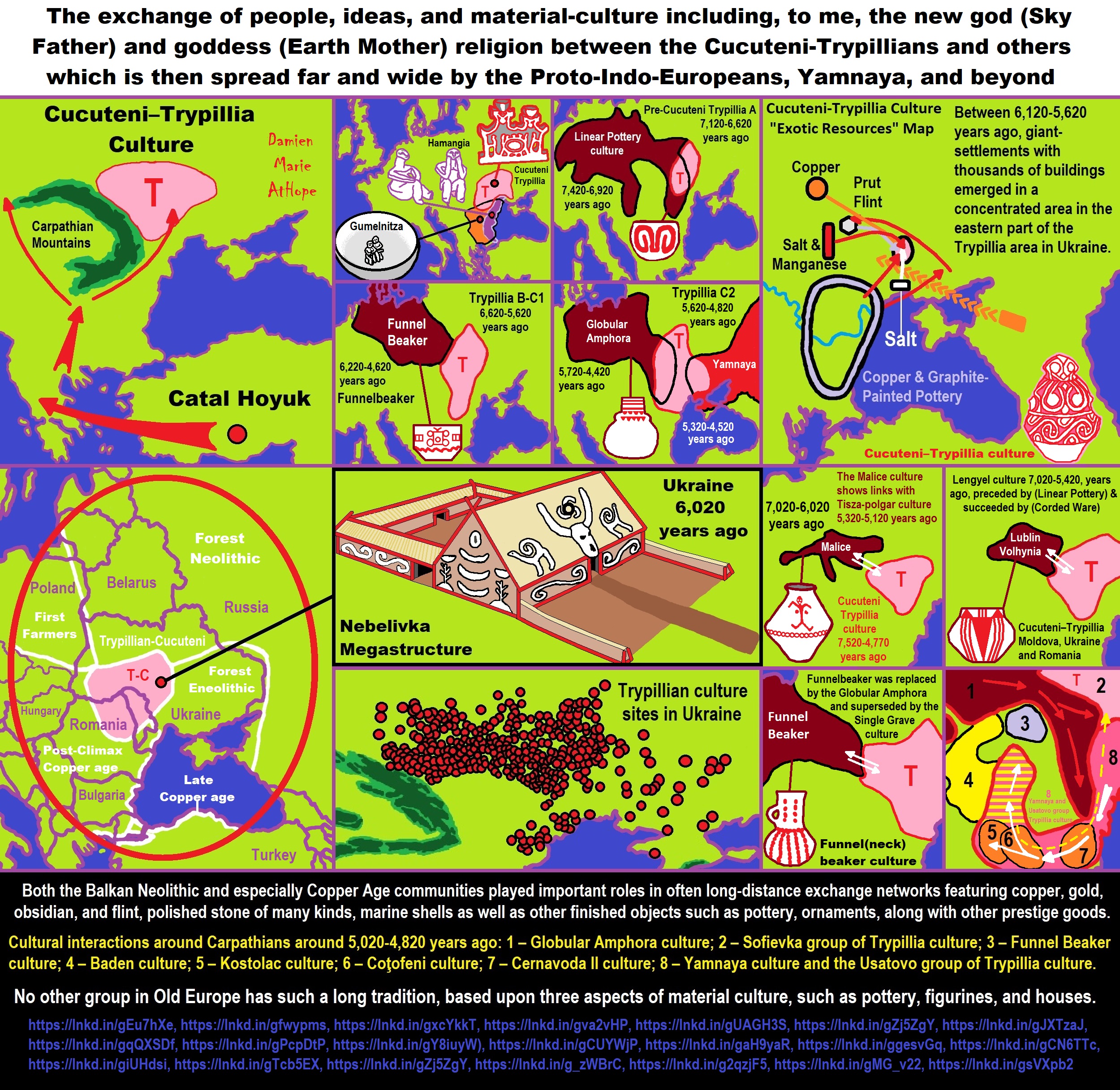
ref, ref, ref, ref, ref, ref, ref, ref, ref, ref, ref, ref, ref, ref, ref, ref, ref, ref, ref, ref
The exchange of people, ideas, and material-culture including, to me, the new god (Sky Father) and goddess (Earth Mother) religion between the Cucuteni-Trypillians and others which is then spread far and wide by the Proto-Indo-Europeans, Yamnaya, and beyond?
“These ideas are my speculations from the evidence.”
European Culture Links:

I am still researching the “god‘s origins” all over the world. So you know, it is very complicated but I am smart and willing to look, DEEP, if necessary, which going very deep does seem to be needed here, when trying to actually understand the evolution of gods and goddesses. I am sure of a few things and less sure of others, but even in stuff I am not fully grasping I still am slowly figuring it out, to explain it to others. But as I research more I am understanding things a little better, though I am still working on understanding it all or something close and thus always figuring out more.
Sky Father/Sky God?
“Egyptian: (Nut) Sky Mother and (Geb) Earth Father” (Egypt is different but similar)
Turkic/Mongolic: (Tengri/Tenger Etseg) Sky Father and (Eje/Gazar Eej) Earth Mother *Transeurasian*
Hawaiian: (Wākea) Sky Father and (Papahānaumoku) Earth Mother *Austronesian*
New Zealand/ Māori: (Ranginui) Sky Father and (Papatūānuku) Earth Mother *Austronesian*
Proto-Indo-European: (Dyḗus/Dyḗus ph₂tḗr) Sky Father and (Dʰéǵʰōm/Pleth₂wih₁) Earth Mother
Indo-Aryan: (Dyaus Pita) Sky Father and (Prithvi Mata) Earth Mother *Indo-European*
Italic: (Jupiter) Sky Father and (Juno) Sky Mother *Indo-European*
Etruscan: (Tinia) Sky Father and (Uni) Sky Mother *Tyrsenian/Italy Pre–Indo-European*
Hellenic/Greek: (Zeus) Sky Father and (Hera) Sky Mother who started as an “Earth Goddess” *Indo-European*
Nordic: (Dagr) Sky Father and (Nótt) Sky Mother *Indo-European*
Slavic: (Perun) Sky Father and (Mokosh) Earth Mother *Indo-European*
Illyrian: (Deipaturos) Sky Father and (Messapic Damatura’s “earth-mother” maybe) Earth Mother *Indo-European*
Albanian: (Zojz) Sky Father and (?) *Indo-European*
Baltic: (Perkūnas) Sky Father and (Saulė) Sky Mother *Indo-European*
Germanic: (Týr) Sky Father and (?) *Indo-European*
Colombian-Muisca: (Bochica) Sky Father and (Huythaca) Sky Mother *Chibchan*
Aztec: (Quetzalcoatl) Sky Father and (Xochiquetzal) Sky Mother *Uto-Aztecan*
Incan: (Viracocha) Sky Father and (Mama Runtucaya) Sky Mother *Quechuan*
China: (Tian/Shangdi) Sky Father and (Dì) Earth Mother *Sino-Tibetan*
Sumerian, Assyrian and Babylonian: (An/Anu) Sky Father and (Ki) Earth Mother
Finnish: (Ukko) Sky Father and (Akka) Earth Mother *Finno-Ugric*
Sami: (Horagalles) Sky Father and (Ravdna) Earth Mother *Finno-Ugric*
Puebloan-Zuni: (Ápoyan Ta’chu) Sky Father and (Áwitelin Tsíta) Earth Mother
Puebloan-Hopi: (Tawa) Sky Father and (Kokyangwuti/Spider Woman/Grandmother) Earth Mother *Uto-Aztecan*
Puebloan-Navajo: (Tsohanoai) Sky Father and (Estsanatlehi) Earth Mother *Na-Dene*
ref, ref, ref, ref, ref, ref, ref, ref, ref, ref, ref, ref, ref, ref, ref, ref, ref, ref, ref, ref, ref, ref, ref, ref, ref, ref, ref
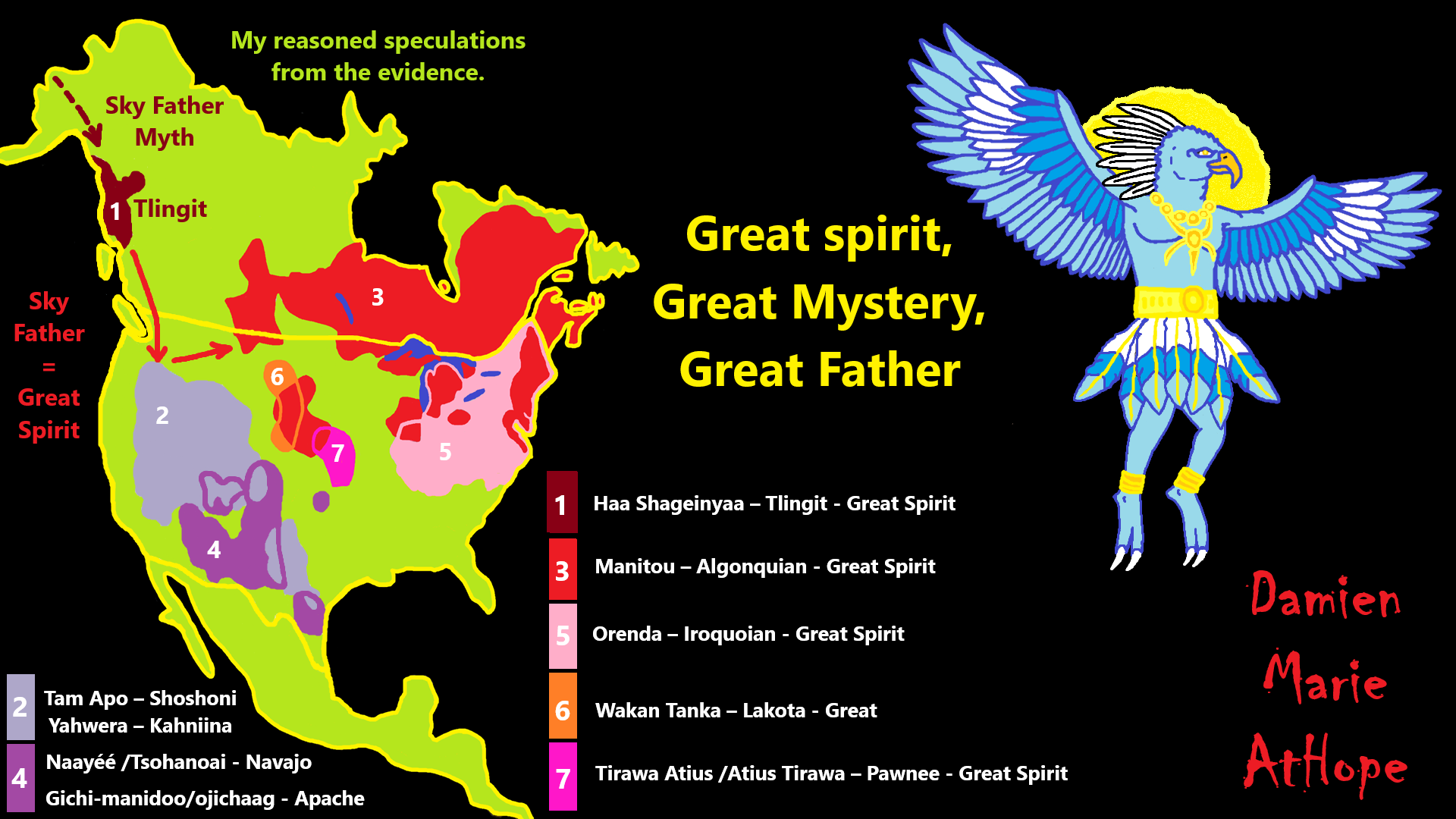
“The Great Spirt and the Evil one Native American (Navajo): the Fathers of All Fathers. The Supreme Being. The Father of the Holy People. The Great Spirit. (watches us by light like sun light or moon light) = Sky Father creator and maker to all things, corn pollen prayer are offered, sacred stone offering to, protect us by the light of the sun. The Great Spirit is a common reference among many Native American Tribes.” ref, ref
There are three types of the Great Spirit thinking (to me):
- Great Spirit (animistic type): “Great Mystery” likely no referred gender.
- Great Spirit (totemistic/shamanistic type): “Great Spirit” is likely not fully seen as a god/goddess-type spirit, it could be an animal but may have male or female gender.
- Great Spirit (paganistic type): “Great/High God” likely a male gender commonly related to the sun or blue/clear sky.
The Great Spirit
“The Great Spirit” is the English translation of the name of the creator god in many Native American traditions, particularly Algonquian and Siouan tribes. Since Algonquian tribes were the first Native American cultures encountered by English speakers, “Great Spirit” became a common term referring to Native American creator deities in general, and was also frequently used as the word for “God” in translations of Christian texts into Native American languages. Indeed, many Native American people consider the Great Spirit and the Christian God to be one and the same. Other Native American people are less receptive to this idea, believing that today’s notion of the Great Spirit was mostly constructed by missionaries. The truth is probably somewhere in the middle– many Native American tribal traditions definitely did include some form of the Great Spirit in their creation myths and religious rituals, but some tribes never had such traditions until after colonization. And in other tribes, while there had always been the belief in a Great Spirit or Great Mystery that provided order to the spiritual world, this belief system became significantly altered after contact with Christianity, and modern conceptions of the Native American Great Spirit may not be a very accurate representation of the original Native spirituality.” ref
“Makunaima: High God, Creator, “God” or “Great Spirit” but not personified. Tribal affiliation: Akawaio, Pemon, Macusi, Carib. Related figures in other tribes: Kururumany (Arawak). The Sun, the Frog, and the Fire-Sticks: A Guyanese Carib legend about Makunaima and his twin brother Pia.” ref
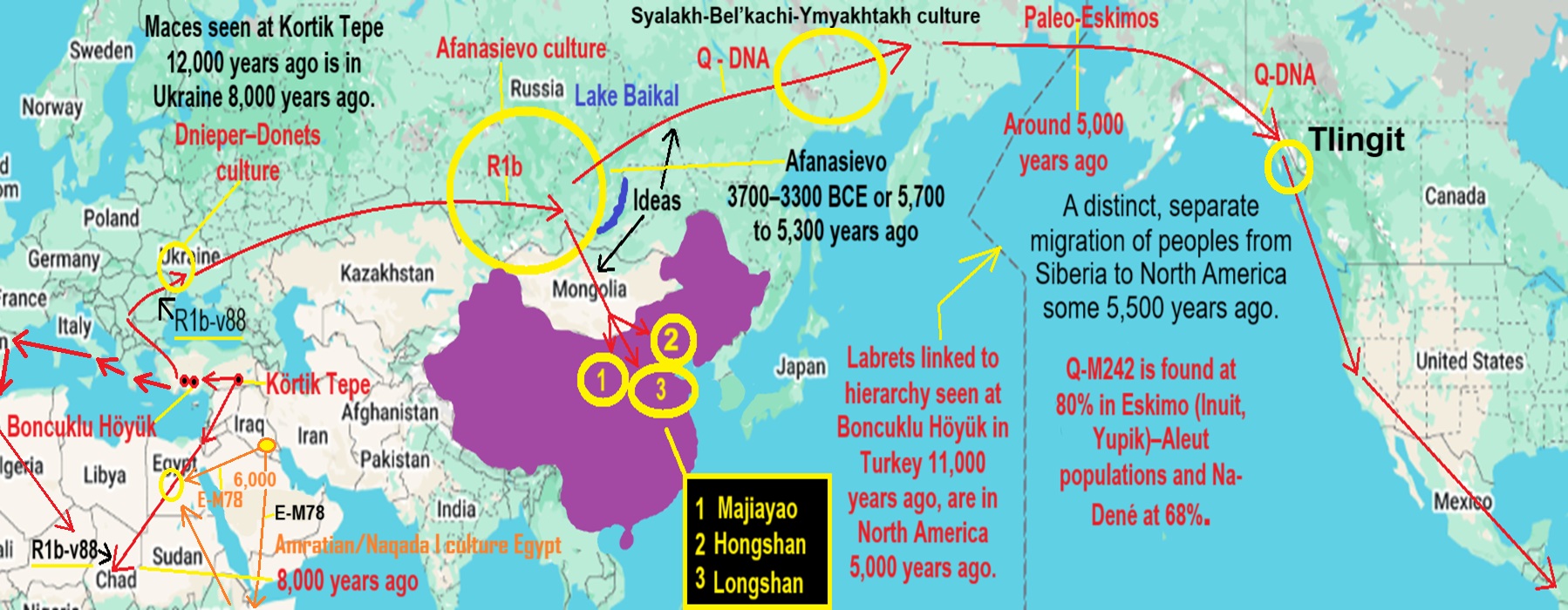
My map of how Mace heads that start in Turkey at Körtik Tepe 12,000 years ago go into Egypt and Ukraine at around 8,000 years ago, also taking the mace, ideas of male elites, Supreme god/high god/sun god/sky god, and several mythologies similar to proto-Indo-European mythology, (seeming to confirm it started in the area of East Turkey/South of the Caucasus Mountains as many think related to the Anatolian hypothesis 9,000 years ago or so).
These ideas went east to Siberia, then China, around 5,000 years ago, the time sun symbols show up in Siberia and Mongolia, and the mace gets to China, with ideas of kings too. These new cultural ideas went to North America around 5,000 years ago, seen in Q DNA, but also ideas of elites and the labrets, first seen 11,000 years ago at Boncuklu Höyük.
There were two intersections of ideas in pre-Egypt 8,000 R1b-v88 DNA, and then ideas related to Iraq and the Caucasus Mountain cultures 6,000 years ago. As the Mace heads in Egypt seem to start 6,000 years ago, Amratian/Naqada I culture, the mace must have gone to Egypt around 6,000 years ago, and likely some evolved mythology as well.
Also, Early European Farmers, a group of Anatolian Neolithic Farmers, brought agriculture to Europe and then Northwest Africa. In northwestern Africa, lifestyle transitioned from foraging to food production around 7,400 years ago, but what sparked that change remains unclear. The earliest basal R1b-V88 haplogroups were found in several Eastern European hunter-gatherers approximately 11,000 years ago; this DNA then migrated into Ukraine around 8,000 years ago. The haplogroup then seemingly spread with the expansion of Neolithic farmers, who established agriculture in the Western Mediterranean by around 7500 years ago.
I will add that R1b-v88 also came into North Africa through southern Europe, and moved to Chad, but I think it could have been both, as I see ideas moving a lot. I am open to it being just from the Northwest, it is still expressing that R1b-v88 brought more than just agriculture and pottery, it brought ideas of elites and the Supreme God, too. What I am saying. Eletes and High Gods were invented in the Middle East, with or around the time of agriculture, is my reasoned speculation. Antinola Neolithic farmers is a better word choice than Early European Farmers; calling them ANF, as EEF implies admixture to some extent. But both are used interchangeably.
“The Master of Animals or Lord of Animals is a motif in ancient art showing a human between and grasping two confronted animals. It is very widespread in the art of the Ancient Near East and Egypt. The figure is normally male, but not always, the animals may be realistic or fantastical, and the figure may have animal elements such as horns, or an animal’s upper body. Unless he is shown with specific divine attributes, he is typically described as a hero, although what the motif represented to the cultures which created the works probably varies greatly. The motif is so widespread and visually effective that many depictions were probably conceived as decoration with only a vague meaning attached to them. The Master of Animals is the “favorite motif of Achaemenian official seals“, but the figures in these cases should be understood as the king.” ref
“The human figure may be standing, found from the 4th millennium BC, or kneeling on one knee, these latter found from the 3rd millennium BC. They are usually shown looking frontally, but in Assyrian pieces typically shown from the side. Sometimes the animals are clearly alive, whether fairly passive and tamed, or still struggling or attacking. In other pieces, they may represent dead hunter’s prey. Other associated representations show a figure controlling or “taming” a single animal, usually to the right of the figure. But the many representations of heroes or kings killing an animal are distinguished from these. One of the earliest known depictions of the Master of Animals appears on stamp seals of the Ubaid period in Mesopotamia. The motif appears on a terracotta stamp seal from Tell Telloh, ancient Girsu, at the end of the prehistoric Ubaid period of Mesopotamia, c. 4000 BCE or 6,020 years ago.” ref
“The motif also takes pride of place at the top of the famous Gebel el-Arak Knife in the Louvre, an ivory and flint knife dating from the Naqada II d period of Egyptian prehistory, which began c. 3450 BC. Here a figure in the Mesopotamian dress, often taken to be a god, grapples with two lions. It has been connected to the famous Pashupati seal from the Indus Valley Civilization (2500-1500 BC), showing a figure seated in a yoga-like posture, with a horned headdress (or horns), and surrounded by animals. This in turn is related to a figure on the Gundestrup cauldron, who sits with legs part-crossed, has antlers, is surrounded by animals, and grasps a snake in one hand and a torc in the other. This famous and puzzling object probably dates to 200 BC, or possibly as late as 300 AD, and though found in Denmark was perhaps made in Thrace. A form of the master of animals motif appears on an Early Medieval belt buckle from Kanton Wallis, Switzerland, which depicts the biblical figure of Daniel between two lions.” ref
“The purse-lid from the Sutton Hoo burial of about 620 AD has two plaques with a man between two wolves, and the motif is common in Anglo-Saxon art and related Early Medieval styles, where the animals generally remain aggressive. Other notable examples of the motif in Germanic art include one of the Torslunda plates, and helmets from Vendel and Valsgärde. In the art of Mesopotamia the motif appears very early, usually with a “naked hero”, for example at Uruk in the Uruk period (c. 4000 to 3100 BC), but was “outmoded in Mesopotamia by the seventh century BC”. In Luristan bronzes the motif is extremely common, and often highly stylized. In terms of its composition, the Master of Animals motif compares with another very common motif in the art of the ancient Near East and Mediterranean, that of two confronted animals flanking and grazing on a Tree of Life.” ref
Master of Animals: Deity figures
“Although such figures are not all, or even usually, deities, the term can also be a generic name for a number of deities from a variety of cultures with close relationships to the animal kingdom or in part animal form (in cultures where that is not the norm). These figures control animals, usually wild ones, and are responsible for their continued reproduction and availability for hunters. They sometimes also have female equivalents, the so-called Mistress of the Animals. Many Mesopotamian examples may represent Enkidu, a central figure in the Ancient Mesopotamian Epic of Gilgamesh. They may all have a Stone Age precursor who was probably a hunter’s deity. Many relate to the horned deity of the hunt, another common type, typified by Cernunnos, and a variety of stag, bull, ram, and goat gods. Horned gods are not universal, however, and in some cultures bear gods, like Arktos might take the role, or even the more anthropomorphic deities who lead the Wild Hunt. Such figures are also often referred to as ‘Lord of the forest’* or ‘Lord of the mountain’. The Greek god seen as a “Master of Animals” is usually Apollo, the god of hunting. Shiva has the epithet Pashupati meaning the “Lord of animals”, and these figures may derive from an archetype. Chapter 39 of the Book of Job has been interpreted as an assertion of the God of the Hebrew Bible as Master of Animals.” ref
“Master of the animals, is generally a supernatural figure regarded as the protector of game in the traditions of foraging peoples. The name was devised by Western scholars who have studied such hunting and gathering societies. In some traditions, the master of the animals is believed to be the ruler of the forest and guardian of all animals; in others, he is the ruler of only one species, usually a large animal of economic or social importance to the tribe. Thus, among Eurasian peoples the animal most frequently is the bear; among the reindeer cultures of the tundra, the reindeer; among the northern coastal peoples of Eurasia and America, the whale, the seal, or the walrus; among the North American Indians, the bear, the beaver, or the caribou; and among Mesoamerican and South American Indians, the wild pig, jaguar, deer, or tapir. In some traditions he is pictured in human form, at times having animal attributes or riding an animal; in other traditions, he is a giant animal or can assume animal form at will.” ref
“A complex system of customs governs the relationship between the master of the animals, the game animal, and the hunter. The master controls the game animals or their spirits (in many myths, by penning them). He releases a certain number to humans as food. Only the allotted number may be killed, and the slain animals must be treated with respect. The master of the animals, if properly invoked, will also guide the hunter to the kill. The souls of the animals, when slain, return to the master’s pens and give him a report of their treatment. If this system is violated, the master will avenge an animal improperly slain, usually by withholding game. A ceremony then must be held to remove the offense or a shaman (a religious personage with healing and psychic transformation powers) sent to placate the master.” ref
“In Minoan and Mycenaean mythological and religious iconography appears a male deity, called later by the Greeks, Master of Animals. He is a counterpart of the Mistress of Wild Animals (Potnia theron) portrayed with wild animals, mainly lions, and exerting his power over them. Some authors suppose that the Master of Animals could represent a hunting deity and protector of nature, or even a nature god. But sometimes this deity, accompanied by a lion, is armed with a spear and a shield and at other times he is again armed, but without the company of animals. M.P. Nilsson posed an interesting observation about the close relationship between the Master of Animals and the armed god, as a hunter and war god. He believed, that the spear and the shield became a religious symbol of this god.” ref
“The Master of Animals could represent, at least, from the beginning of the Late Helladic period, a nature god who is related to hunting. The Mycenaeans took this type from the Minoan belief system, which was the origin of this deity. After 1500 BCE and during the fourteenth century BCE the nature of this figure changed. The warlike tendency of the Mycenaean society was growing, and this could be the reason why their male god had to assume another responsibility. His attributes, mainly the shield, became frequent decorative motives in Mycenaean art and pottery production. Thus it is possible that the male god, depicted from the beginning primarily with animals, and later on with a spear and a shield, could be Enyalius (Enualios), known from Linear B script, and who is equated in Greek literature with Ares, the god of war.” ref
“On seals and ring-reliefs, the Master of Animals is depicted in the Minoan manner, wearing only a small cloth around his slim waist and turning his body to show his muscular torso in a frontal position. The head, usually with a beard and rich hair, has a strong facial expression. A gem from Kydonia and the Mycenaean seal ring illustrates him as such, while the well-known Aegina Treasure-pendant represents the Master of Animals with an Egyptian influence. The motif is created in a completely different way. The deity looks like an Egyptian, holding waterbirds in his hands and his surroundings consists of double snakes and papyrus flowers. Oriental seals from the Palace of Cadmus in Thiva show the Master of Animals with goats, some vegetation, and various symbols from Syrian and Mesopotamian mythology.” ref
Paganism 12,000 years old: related to (Pre-Capitalism): LINK
Paganism 7,000-5,000 years old: related to (Capitalism) (World War 0) Elite & their slaves: LINK
Paganism 5,000 years old: progressed organized religion and the state: related to (Kings and the Rise of the State): LINK
Paganism 4,000 years old: related to (First Moralistic gods, then the Origin time of Monotheism): LINK
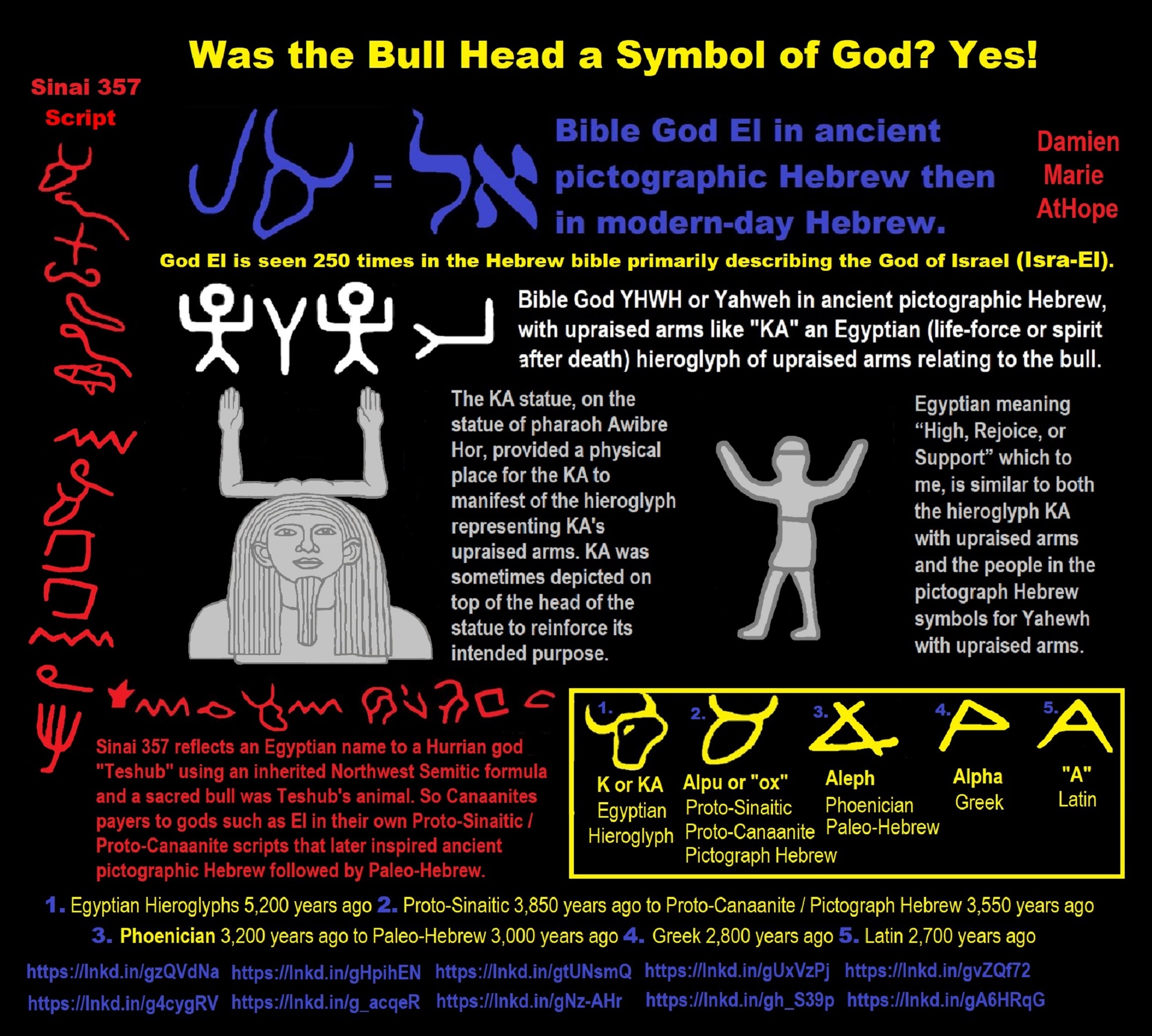
· Bible God El in ancient pictographic Hebrew then in modern-day Hebrew.
· God El is seen 250 times in the Hebrew bible primarily describing the God of Israel (Isra-El).
· Bible God YHWH or Yahweh in ancient pictographic Hebrew, with upraised arms like “KA” an Egyptian (life-force or spirit after death) hieroglyph of upraised arms relating to the bull.
· Egyptian with upraised arms means High, Rejoice, or Support, which to me, is similar to both the hieroglyph KA with upraised arms and the people pictographic Hebrew symbols (meaning Lo, Behold, “The”) for Yahweh with upraised arms.
· The KA statue, on the statue of pharaoh Awibre Hor, provided a physical place for the KA to manifest of the hieroglyph representing KA’s upraised arms. KA was sometimes depicted on top of the head of the statue to reinforce its intended purpose.
· Egyptian meaning “High, Rejoice, or Support” which to me, is similar to both the hieroglyph KA with upraised arms and the people in the pictograph Hebrew symbols for Yahewh with upraised arms.
· Sinai 357 reflects an Egyptian name to a Hurrian god “Teshub” using an inherited Northwest Semitic formula and a sacred bull was Teshub’s animal. So Canaanites payers to gods such as El in their own Proto-Sinaitic / Proto-Canaanite scripts that later inspired ancient pictographic Hebrew followed by Paleo-Hebrew.
· 1. Egyptian Hieroglyphs 5,200 years ago 2. Proto-Sinaitic 3,850 years ago to Proto-Canaanite / Pictograph Hebrew 3,550 years ago 3. Phoenician 3,200 years ago to Paleo-Hebrew 3,000 years ago 4. Greek 2,800 years ago 5. Latin 2,700 years ago. ref, ref, ref, ref, ref, ref, ref, ref, ref, ref, ref, ref, ref, ref
Here is my quick evolution of the Bible God’s names:
A Sky god, later named EL, was turned into El-Shaddai and El-ohim, then Yahweh, and later, the New Testament claimed Jesus.
“The sky often has important religious significance. Many polytheistic religions have deities associated with the sky. Daytime gods and nighttime gods are frequently deities of an “upper world” or “celestial world” as opposed to the earth and a “netherworld” (gods of the underworld are sometimes called “chthonic” deities). Any masculine sky god is often also king of the gods, taking the position of patriarch within a pantheon. Such king gods are collectively categorized as “sky father” deities, with a polarity between sky and earth often being expressed by pairing a “sky father” god with an “earth mother” goddess.” ref
“There is evidence that the Canaanite/Phoenician and Aramaic conception of El is essentially the same as the Amorite conception of El, which was popularized in the 18th century BCE but has origins in the pre-Sargonic period.” ref
“The Amorites are regarded as one of the ancient Semitic-speaking peoples. The Amorites were an ancient Northwest Semitic-speaking Bronze Age people from the Levant. Initially appearing in Sumerian records c. 2500 BCE, they expanded and ruled most of the Levant, Mesopotamia, and parts of Egypt from the 21st century BC to the late 17th century BCE.” ref
“Amurru, Amorite deity, occasionally called “lord of the steppe” or “lord of the mountain.” ref
“The term “El Shaddai” may mean “god of the mountains,” referring to the Mesopotamian divine mountain.” ref
“Elohim, morphologically, is the plural form of the word אֱלוֹהַּ[a] (eloah) and is related to El. It is cognate to the word ‘l-h-m, which is found in Ugaritic, where it is used as the pantheon for Canaanite gods, the children of El, and conventionally vocalized as “Elohim.” Rabbinic scholar Maimonides wrote that Elohim “Divinity” and elohim “gods” are commonly understood to be homonyms. One modern theory suggests that the notion of divinity underwent radical changes in the early period of Israelite identity and the development of Ancient Hebrew religion. In this view, the ambiguity of the term elohim is the result of such changes, cast in terms of “vertical translatability”, i.e. the re-interpretation of the gods of the earliest recalled period as the national god of monolatrism as it emerged in the 7th to 6th century BCE in the Kingdom of Judah and during the Babylonian captivity, and further in terms of monotheism by the emergence of Rabbinical Judaism in the 2nd century CE.” ref
“Yahweh[a] was an ancient Levantine deity worshiped in Israel and Judah as the primary deity and the head of the pantheon of the polytheistic religion of Yahwism. In later centuries, El and Yahweh became conflated, and El-linked epithets, such as ʾĒl Šadday (אֵל שַׁדַּי), came to be applied to Yahweh alone. Characteristics of other deities, such as Asherah and Baal, were also selectively “absorbed” in conceptions of Yahweh. In monotheistic Judaism the existence of other deities was denied outright, and Yahweh was proclaimed the creator deity and the sole deity to be worthy of worship. During the Second Temple period, Judaism began to substitute other Hebrew words, primarily ăḏōnāy (אֲדֹנָי, lit. ’My Lords’). By the time of the Jewish–Roman wars—namely following the Roman siege of Jerusalem and the concomitant destruction of the Second Temple in 70 CE—the original pronunciation of Yahweh’s name was forgotten entirely.” ref
“Yahwism is the name given by modern scholars to the religion of ancient Israel and Judah. An ancient Semitic religion of the Iron Age, Yahwism was essentially polytheistic and had a pantheon, with various gods and goddesses being worshipped by the Israelites. At the head of this pantheon was Yahweh, held in an especially high regard as the two Israelite kingdoms’ national god. Some scholars hold that the goddess Asherah was worshipped as Yahweh’s consort, though other scholars disagree. Following this duo were second-tier gods and goddesses, such as Baal, Shamash, Yarikh, Mot, and Astarte, each of whom had their own priests and prophets and numbered royalty among their devotees.” ref
To have faith is to make a presumption of faith towards something, and the most common use of faith is toward things that relate to concepts of gods, such as their names. Another way to have faith would mean to understand why a god would change their name. In the Jewish and Christian religions, their god’s name was changed. In the beginning, god’s eternal name is El, Near East god is the most holy and the father of all gods. El is a Semitic word meaning “god” or may relate to multiple ancient Near Eastern deities such as Hebrew: el, Amorite: il, Arabic ilah, Akkadian and Ugaritic: ilu, Aramaic and Phoenician: l, and is the known name of the original god to the Abrahamic religions. ref, ref, ref
In Judaism, the later Hebrew and Aramaic texts, as well as the Dead Sea Scrolls, dating around 2,408 to 1,700 years ago, used El or Elohim for the names of God and sometimes were in written paleo-Hebrew script dating about 3,000 years ago, and used in the ancient kingdoms of Israel and Judah, which shows that El was still treated as special. ref, ref
In the first statement of the Muslim confession of faith in the Quran, it states that “There is no god (ilah) except God (al-Lah or Allah).” And al-ilah, “the god” relates to El and Elah, the Hebrew and Aramaic words for God. ref, ref
Also what is interesting is that Hebrew is a Semitic language and according to a popular Israeli news source the Haaretz, the country Isra-El (Israel) expresses the relationship with the 3,300 years old Canaanite deity El who was the head of the Canaanite pantheon. ref
However, El’s name changed in the human-made Bible to El Shaddai. El Shaddai was the Bible-God’s name as first seen in Genesis 17:1, “God appeared to Abram, saying I am El Shaddai.” Similarly, in Genesis 35:11, Bible-God says to Jacob, “I am El Shaddai.” And seen in Exodus 6:2–3, El Shaddai was God’s name known to Abraham, Isaac, and Jacob. All must follow El and Baal whose features were absorbed into the Yahweh religion. ref
God El, the Semitic god, and the creator have a son named Baal “The Lord,” who is the governor of all adversaries to the fake god of the Jews, Yahweh or his other name El Shaddai. Bible-God, the Abrahamic god and the creator have a son named Jesus “The Lord.” It is interesting how people say that Jesus is “Lord” because Jesus is the son of Bible-God and without realizing they seem to be referencing Baal, which can mean “Lord” and is the son of El. No? Okay, let me try again! Why would a god go and change its name anyway? Some religious scholars have stated that the early Hebrews used the names Baʿal (“Lord”) and Baʿali (“My Lord”) to refer to the Lord of Israel, who is El and Yahweh. This use of Baʿal and Baʿali occurred both directly and as the divine element of some Hebrew theophoric names, which means consisting of the name of a deity and a verb. A few names that included the element Baʿal and presumably referring to Yahweh, including Saul’s son Eshbaʿal (“The Lord is Great”), and David’s son Beeliada (“The Lord Knows”). The name Bealiah is the combination of Baal and Yahweh (“The Lord is Jah” + “Yahweh is Baʿal” = “Yahweh is Lord”). ref
To have faith would mean you would have to believe that you already know all of your god’s different names and believe you have the right god and not some other religions’ god or a combination of gods.
Evolution of the Bible God’s names: Was the Bull Head a Symbol of God? Yes!
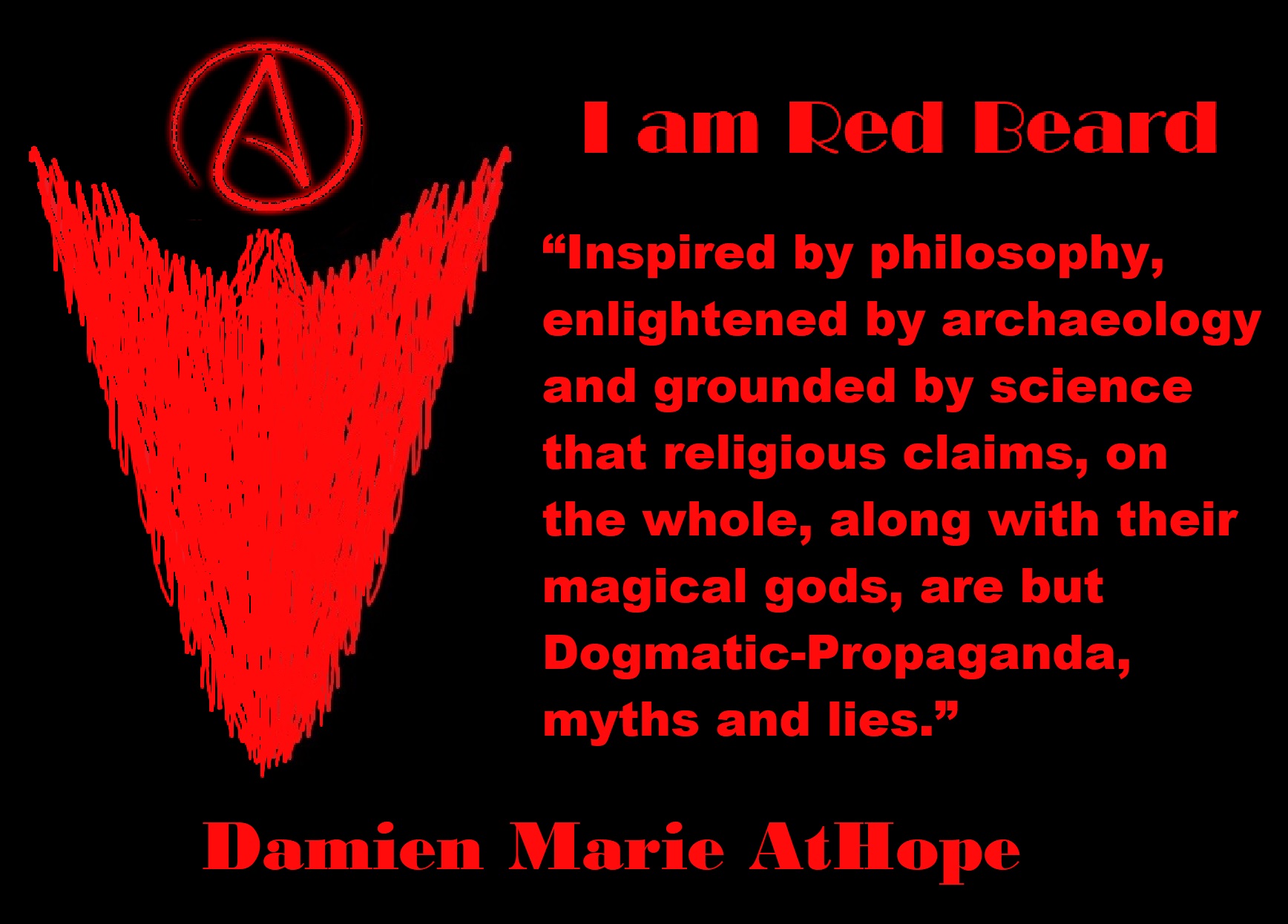
People don’t commonly teach religious history, even that of their own claimed religion. No, rather they teach a limited “pro their religion” history of their religion from a religious perspective favorable to the religion of choice.
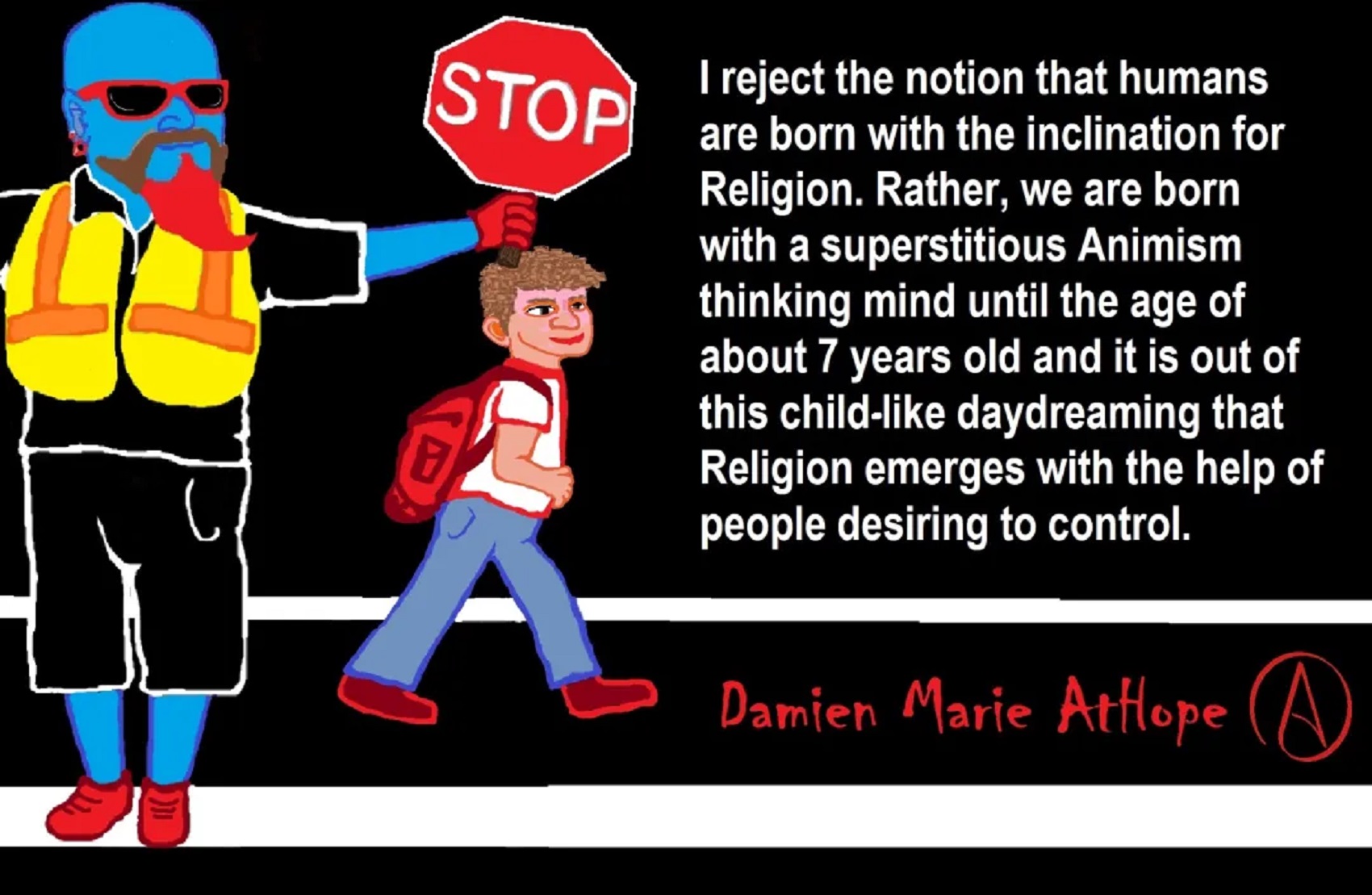
Do you truly think “Religious Belief” is only a matter of some personal choice?
Do you not see how coercive one’s world of choice is limited to the obvious hereditary belief, in most religious choices available to the child of religious parents or caregivers? Religion is more commonly like a family, culture, society, etc. available belief that limits the belief choices of the child and that is when “Religious Belief” is not only a matter of some personal choice and when it becomes hereditary faith, not because of the quality of its alleged facts or proposed truths but because everyone else important to the child believes similarly so they do as well simply mimicking authority beliefs handed to them. Because children are raised in religion rather than being presented all possible choices but rather one limited dogmatic brand of “Religious Belief” where children only have a choice of following the belief as instructed, and then personally claim the faith hereditary belief seen in the confirming to the belief they have held themselves all their lives. This is obvious in statements asked and answered by children claiming a faith they barely understand but they do understand that their family believes “this or that” faith, so they feel obligated to believe it too. While I do agree that “Religious Belief” should only be a matter of some personal choice, it rarely is… End Hereditary Religion!

Animism: Respecting the Living World by Graham Harvey
“How have human cultures engaged with and thought about animals, plants, rocks, clouds, and other elements in their natural surroundings? Do animals and other natural objects have a spirit or soul? What is their relationship to humans? In this new study, Graham Harvey explores current and past animistic beliefs and practices of Native Americans, Maori, Aboriginal Australians, and eco-pagans. He considers the varieties of animism found in these cultures as well as their shared desire to live respectfully within larger natural communities. Drawing on his extensive casework, Harvey also considers the linguistic, performative, ecological, and activist implications of these different animisms.” ref
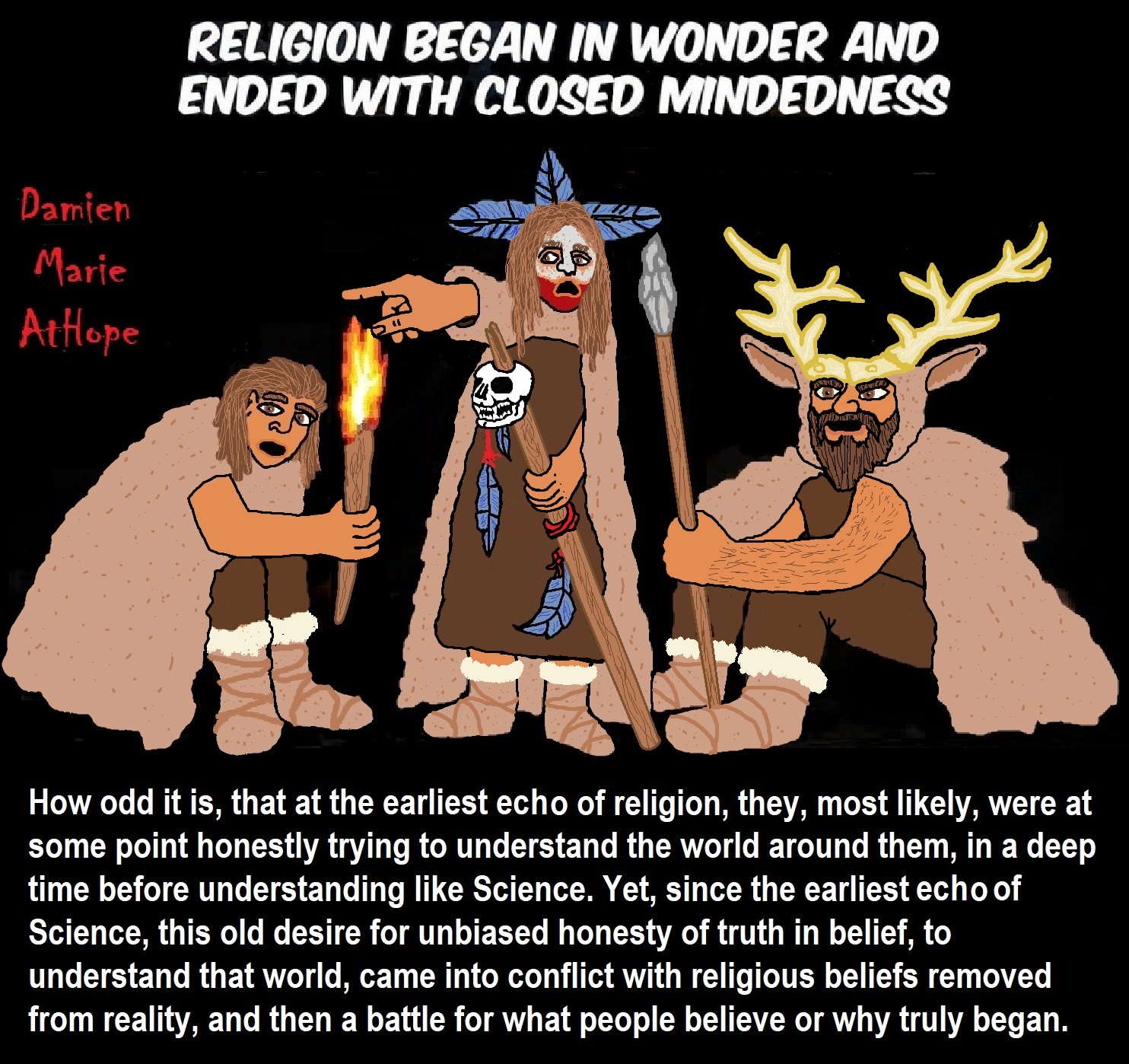
We are like believing machines we vacuum up ideas, like Velcro sticks to almost everything. We accumulate beliefs that we allow to negatively influence our lives, often without realizing it. Our willingness must be to alter skewed beliefs that impend our balance or reason, which allows us to achieve new positive thinking and accurate outcomes.
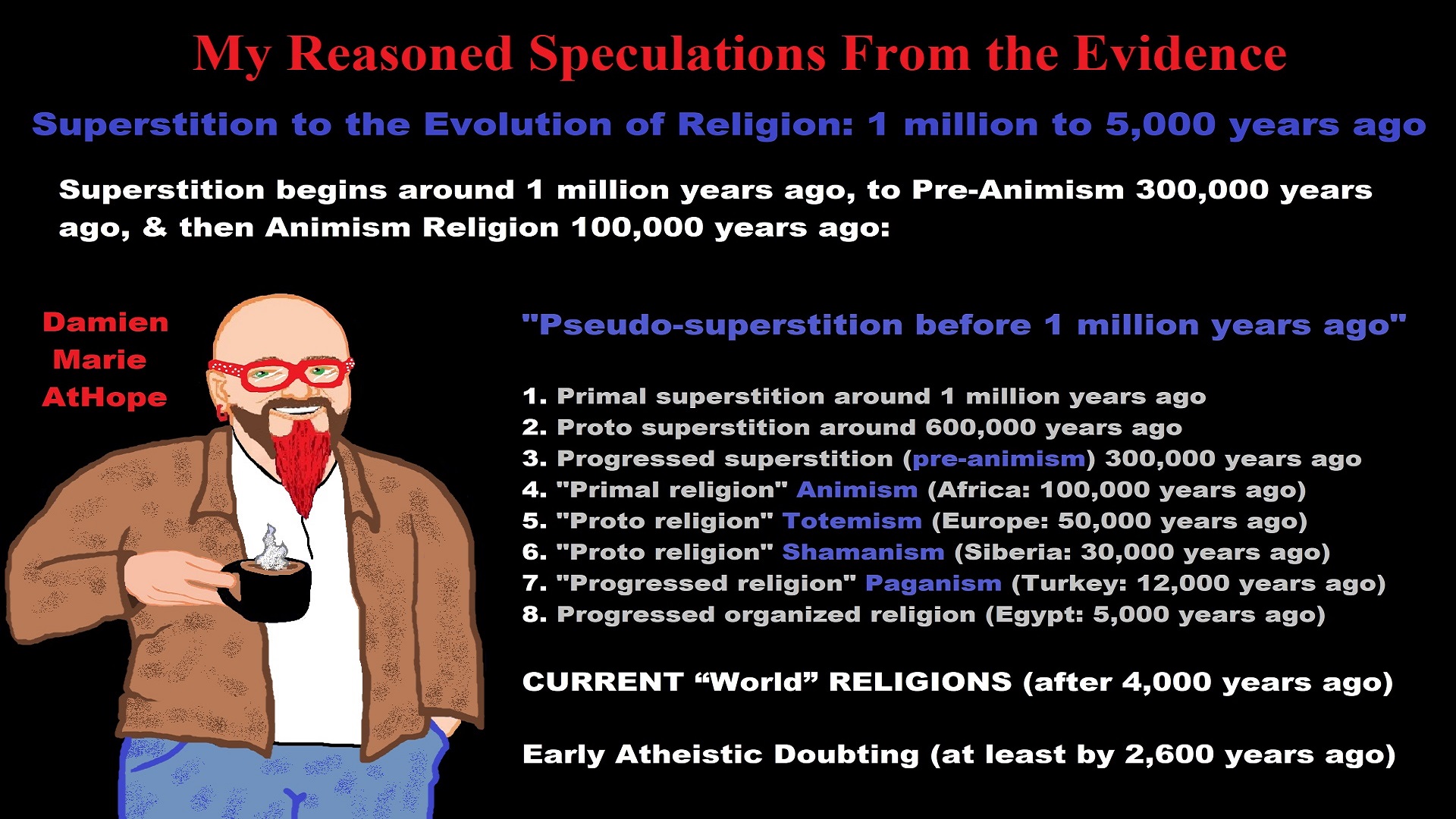
My thoughts on Religion Evolution with external links for more info:
- (Pre-Animism Africa mainly, but also Europe, and Asia at least 300,000 years ago), (Pre-Animism – Oxford Dictionaries)
- (Animism Africa around 100,000 years ago), (Animism – Britannica.com)
- (Totemism Europe around 50,000 years ago), (Totemism – Anthropology)
- (Shamanism Siberia around 30,000 years ago), (Shamanism – Britannica.com)
- (Paganism Turkey around 12,000 years ago), (Paganism – BBC Religion)
- (Progressed Organized Religion “Institutional Religion” Egypt around 5,000 years ago), (Ancient Egyptian Religion – Britannica.com)
- (CURRENT “World” RELIGIONS after 4,000 years ago) (Origin of Major Religions – Sacred Texts)
- (Early Atheistic Doubting at least by 2,600 years ago) (History of Atheism – Wikipedia)
“Religion is an Evolved Product” and Yes, Religion is Like Fear Given Wings…
Atheists talk about gods and religions for the same reason doctors talk about cancer, they are looking for a cure, or a firefighter talks about fires because they burn people and they care to stop them. We atheists too often feel a need to help the victims of mental slavery, held in the bondage that is the false beliefs of gods and the conspiracy theories of reality found in religions.
Understanding Religion Evolution:
- Pre-Animism (at least 300,000 years ago)
- Animism (Africa: 100,000 years ago)
- Totemism (Europe: 50,000 years ago)
- Shamanism (Siberia: 30,000 years ago)
- Paganism (Turkey: 12,000 years ago)
- Progressed organized religion (Egypt: 5,000 years ago), (Egypt, the First Dynasty 5,150 years ago)
- CURRENT “World” RELIGIONS (after 4,000 years ago)
- Early Atheistic Doubting (at least by 2,600 years ago)
“An Archaeological/Anthropological Understanding of Religion Evolution”
It seems ancient peoples had to survived amazing threats in a “dangerous universe (by superstition perceived as good and evil),” and human “immorality or imperfection of the soul” which was thought to affect the still living, leading to ancestor worship. This ancestor worship presumably led to the belief in supernatural beings, and then some of these were turned into the belief in gods. This feeble myth called gods were just a human conceived “made from nothing into something over and over, changing, again and again, taking on more as they evolve, all the while they are thought to be special,” but it is just supernatural animistic spirit-belief perceived as sacred.
Quick Evolution of Religion?
Pre-Animism (at least 300,000 years ago) pre-religion is a beginning that evolves into later Animism. So, Religion as we think of it, to me, all starts in a general way with Animism (Africa: 100,000 years ago) (theoretical belief in supernatural powers/spirits), then this is physically expressed in or with Totemism (Europe: 50,000 years ago) (theoretical belief in mythical relationship with powers/spirits through a totem item), which then enlists a full-time specific person to do this worship and believed interacting Shamanism (Siberia/Russia: 30,000 years ago) (theoretical belief in access and influence with spirits through ritual), and then there is the further employment of myths and gods added to all the above giving you Paganism (Turkey: 12,000 years ago) (often a lot more nature-based than most current top world religions, thus hinting to their close link to more ancient religious thinking it stems from). My hypothesis is expressed with an explanation of the building of a theatrical house (modern religions development). Progressed organized religion (Egypt: 5,000 years ago) with CURRENT “World” RELIGIONS (after 4,000 years ago).
Historically, in large city-state societies (such as Egypt or Iraq) starting around 5,000 years ago culminated to make religion something kind of new, a sociocultural-governmental-religious monarchy, where all or at least many of the people of such large city-state societies seem familiar with and committed to the existence of “religion” as the integrated life identity package of control dynamics with a fixed closed magical doctrine, but this juggernaut integrated religion identity package of Dogmatic-Propaganda certainly did not exist or if developed to an extent it was highly limited in most smaller prehistoric societies as they seem to lack most of the strong control dynamics with a fixed closed magical doctrine (magical beliefs could be at times be added or removed). Many people just want to see developed religious dynamics everywhere even if it is not. Instead, all that is found is largely fragments until the domestication of religion.
Religions, as we think of them today, are a new fad, even if they go back to around 6,000 years in the timeline of human existence, this amounts to almost nothing when seen in the long slow evolution of religion at least around 70,000 years ago with one of the oldest ritual worship. Stone Snake of South Africa: “first human worship” 70,000 years ago. This message of how religion and gods among them are clearly a man-made thing that was developed slowly as it was invented and then implemented peace by peace discrediting them all. Which seems to be a simple point some are just not grasping how devastating to any claims of truth when we can see the lie clearly in the archeological sites.
I wish people fought as hard for the actual values as they fight for the group/clan names political or otherwise they think support values. Every amount spent on war is theft to children in need of food or the homeless kept from shelter.
Here are several of my blog posts on history:
- To Find Truth You Must First Look
- (Magdalenian/Iberomaurusian) Connections to the First Paganists of the early Neolithic Near East Dating from around 17,000 to 12,000 Years Ago
- Natufians: an Ancient People at the Origins of Agriculture and Sedentary Life
- Possible Clan Leader/Special “MALE” Ancestor Totem Poles At Least 13,500 years ago?
- Jewish People with DNA at least 13,200 years old, Judaism, and the Origins of Some of its Ideas
- Baltic Reindeer Hunters: Swiderian, Lyngby, Ahrensburgian, and Krasnosillya cultures 12,020 to 11,020 years ago are evidence of powerful migratory waves during the last 13,000 years and a genetic link to Saami and the Finno-Ugric peoples.
- The Rise of Inequality: patriarchy and state hierarchy inequality
- Fertile Crescent 12,500 – 9,500 Years Ago: fertility and death cult belief system?
- 12,400 – 11,700 Years Ago – Kortik Tepe (Turkey) Pre/early-Agriculture Cultic Ritualism
- Ritualistic Bird Symbolism at Gobekli Tepe and its “Ancestor Cult”
- Male-Homosexual (female-like) / Trans-woman (female) Seated Figurine from Gobekli Tepe
- Could a 12,000-year-old Bull Geoglyph at Göbekli Tepe relate to older Bull and Female Art 25,000 years ago and Later Goddess and the Bull cults like Catal Huyuk?
- Sedentism and the Creation of goddesses around 12,000 years ago as well as male gods after 7,000 years ago.
- Alcohol, where Agriculture and Religion Become one? Such as Gobekli Tepe’s Ritualistic use of Grain as Food and Ritual Drink
- Neolithic Ritual Sites with T-Pillars and other Cultic Pillars
- Paganism: Goddesses around 12,000 years ago then Male Gods after 7,000 years ago
- First Patriarchy: Split of Women’s Status around 12,000 years ago & First Hierarchy: fall of Women’s Status around 5,000 years ago.
- Natufians: an Ancient People at the Origins of Agriculture and Sedentary Life
- J DNA and the Spread of Agricultural Religion (paganism)
- Paganism: an approximately 12,000-year-old belief system
- Paganism 12,000 years old: related to “Anarchism and Socialism” (Pre-Capitalism)
- Shaman burial in Israel 12,000 years ago and the Shamanism Phenomena
- Need to Mythicized: gods and goddesses
- 12,000 – 7,000 Years Ago – Paleo-Indian Culture (The Americas)
- 12,000 – 2,000 Years Ago – Indigenous-Scandinavians (Nordic)
- Norse did not wear helmets with horns?
- Pre-Pottery Neolithic Skull Cult around 11,500 to 8,400 Years Ago?
- 10,400 – 10,100 Years Ago, in Turkey the Nevail Cori Religious Settlement
- 9,000-6,500 Years Old Submerged Pre-Pottery/Pottery Neolithic Ritual Settlements off Israel’s Coast
- Catal Huyuk “first religious designed city” around 9,500 to 7,700 years ago (Turkey)
- Cultic Hunting at Catal Huyuk “first religious designed city”
- Special Items and Art as well as Special Elite Burials at Catal Huyuk
- New Rituals and Violence with the appearance of Pottery and People?
- Haplogroup N and its related Uralic Languages and Cultures
- Ainu people, Sámi people, Native Americans, the Ancient North Eurasians, and Paganistic-Shamanism with Totemism
- Ideas, Technology and People from Turkey, Europe, to China and Back again 9,000 to 5,000 years ago?
- First Pottery of Europe and the Related Cultures
- 9,000 years old Neolithic Artifacts Judean Desert and Hills Israel
- 9,000-7,000 years-old Sex and Death Rituals: Cult Sites in Israel, Jordan, and the Sinai
- 9,000-8500 year old Horned Female shaman Bad Dürrenberg Germany
- Neolithic Jewelry and the Spread of Farming in Europe Emerging out of West Turkey
- 8,600-year-old Tortoise Shells in Neolithic graves in central China have Early Writing and Shamanism
- Swing of the Mace: the rise of Elite, Forced Authority, and Inequality begin to Emerge 8,500 years ago?
- Migrations and Changing Europeans Beginning around 8,000 Years Ago
- My “Steppe-Anatolian-Kurgan hypothesis” 8,000/7,000 years ago
- Around 8,000-year-old Shared Idea of the Mistress of Animals, “Ritual” Motif
- Pre-Columbian Red-Paint (red ochre) Maritime Archaic Culture 8,000-3,000 years ago
- 7,522-6,522 years ago Linear Pottery culture which I think relates to Arcane Capitalism’s origins
- Arcane Capitalism: Primitive socialism, Primitive capital, Private ownership, Means of production, Market capitalism, Class discrimination, and Petite bourgeoisie (smaller capitalists)
- 7,500-4,750 years old Ritualistic Cucuteni-Trypillian culture of Moldova, Romania, and Ukraine
- Roots of a changing early society 7,200-6,700 years ago Jordan and Israel
- Agriculture religion (Paganism) with farming reached Britain between about 7,000 to 6,500 or so years ago and seemingly expressed in things like Western Europe’s Long Barrows
- My Thoughts on Possible Migrations of “R” DNA and Proto-Indo-European?
- “Millet” Spreading from China 7,022 years ago to Europe and related Language may have Spread with it leading to Proto-Indo-European
- Proto-Indo-European (PIE), ancestor of Indo-European languages: DNA, Society, Language, and Mythology
- The Dnieper–Donets culture and Asian varieties of Millet from China to the Black Sea region of Europe by 7,022 years ago
- Kurgan 6,000 years ago/dolmens 7,000 years ago: funeral, ritual, and other?
- 7,020 to 6,020-year-old Proto-Indo-European Homeland of Urheimat or proposed home of their Language and Religion
- Ancient Megaliths: Kurgan, Ziggurat, Pyramid, Menhir, Trilithon, Dolman, Kromlech, and Kromlech of Trilithons
- The Mytheme of Ancient North Eurasian Sacred-Dog belief and similar motifs are found in Indo-European, Native American, and Siberian comparative mythology
- Elite Power Accumulation: Ancient Trade, Tokens, Writing, Wealth, Merchants, and Priest-Kings
- Sacred Mounds, Mountains, Kurgans, and Pyramids may hold deep connections?
- Between 7,000-5,000 Years ago, rise of unequal hierarchy elite, leading to a “birth of the State” or worship of power, strong new sexism, oppression of non-elites, and the fall of Women’s equal status
- Paganism 7,000-5,000 years old: related to “Anarchism and Socialism” (Capitalism) (World War 0) Elite & their slaves
- Hell and Underworld mythologies starting maybe as far back as 7,000 to 5,000 years ago with the Proto-Indo-Europeans?
- The First Expression of the Male God around 7,000 years ago?
- White (light complexion skin) Bigotry and Sexism started 7,000 years ago?
- Around 7,000-year-old Shared Idea of the Divine Bird (Tutelary and/or Trickster spirit/deity), “Ritual” Motif
- Nekhbet an Ancient Egyptian Vulture Goddess and Tutelary Deity
- 6,720 to 4,920 years old Ritualistic Hongshan Culture of Inner Mongolia with 5,000-year-old Pyramid Mounds and Temples
- First proto-king in the Balkans, Varna culture around 6,500 years ago?
- 6,500–5,800 years ago in Israel Late Chalcolithic (Copper Age) Period in the Southern Levant Seems to Express Northern Levant Migrations, Cultural and Religious Transfer
- KING OF BEASTS: Master of Animals “Ritual” Motif, around 6,000 years old or older…
- Around 6000-year-old Shared Idea of the Solid Wheel & the Spoked Wheel-Shaped Ritual Motif
- “The Ghassulian Star,” a mysterious 6,000-year-old mural from Jordan; a Proto-Star of Ishtar, Star of Inanna or Star of Venus?
- Religious/Ritual Ideas, including goddesses and gods as well as ritual mounds or pyramids from Northeastern Asia at least 6,000 years old, seemingly filtering to Iran, Iraq, the Mediterranean, Europe, Egypt, and the Americas?
- Maykop (5,720–5,020 years ago) Caucasus region Bronze Age culture-related to Copper Age farmers from the south, influenced by the Ubaid period and Leyla-Tepe culture, as well as influencing the Kura-Araxes culture
- 5-600-year-old Tomb, Mummy, and First Bearded Male Figurine in a Grave
- Kura-Araxes Cultural 5,520 to 4,470 years old DNA traces to the Canaanites, Arabs, and Jews
- Minoan/Cretan (Keftiu) Civilization and Religion around 5,520 to 3,120 years ago
- Evolution Of Science at least by 5,500 years ago
- 5,500 Years old birth of the State, the rise of Hierarchy, and the fall of Women’s status
- “Jiroft culture” 5,100 – 4,200 years ago and the History of Iran
- Stonehenge: Paganistic Burial and Astrological Ritual Complex, England (5,100-3,600 years ago)
- Around 5,000-year-old Shared Idea of the “Tree of Life” Ritual Motif
- Complex rituals for elite, seen from China to Egypt, at least by 5,000 years ago
- Around 5,000 years ago: “Birth of the State” where Religion gets Military Power and Influence
- The Center of the World “Axis Mundi” and/or “Sacred Mountains” Mythology Could Relate to the Altai Mountains, Heart of the Steppe
- Progressed organized religion starts, an approximately 5,000-year-old belief system
- China’s Civilization between 5,000-3,000 years ago, was a time of war and class struggle, violent transition from free clans to a Slave or Elite society
- Origin of Logics is Naturalistic Observation at least by around 5,000 years ago.
- Paganism 5,000 years old: progressed organized religion and the state: related to “Anarchism and Socialism” (Kings and the Rise of the State)
- Ziggurats (multi-platform temples: 4,900 years old) to Pyramids (multi-platform tombs: 4,700 years old)
- Did a 4,520–4,420-year-old Volcano In Turkey Inspire the Bible God?
- Finland’s Horned Shaman and Pre-Horned-God at least 4,500 years ago?
- 4,000-year-Old Dolmens in Israel: A Connected Dolmen Religious Phenomenon?
- Creation myths: From chaos, Ex nihilo, Earth-diver, Emergence, World egg, and World parent
- Bronze Age “Ritual” connections of the Bell Beaker culture with the Corded Ware/Single Grave culture, which were related to the Yamnaya culture and Proto-Indo-European Languages/Religions
- Low Gods (Earth/ Tutelary deity), High Gods (Sky/Supreme deity), and Moralistic Gods (Deity enforcement/divine order)
- The exchange of people, ideas, and material-culture including, to me, the new god (Sky Father) and goddess (Earth Mother) religion between the Cucuteni-Trypillians and others which is then spread far and wide
- Koryaks: Indigenous People of the Russian Far East and Big Raven myths also found in Tlingit, Haida, Tsimshian, and other Indigenous People of North America
- 42 Principles Of Maat (Egyptian Goddess of the justice) around 4,400 years ago, 2000 Years Before Ten Commandments
- “Happy Easter” Well Happy Eostre/Ishter
- 4,320-3,820 years old “Shimao” (North China) site with Totemistic-Shamanistic Paganism and a Stepped Pyramid
- 4,250 to 3,400 Year old Stonehenge from Russia: Arkaim?
- 4,100-year-old beaker with medicinal & flowering plants in a grave of a woman in Scotland
- Early European Farmer ancestry, Kelif el Boroud people with the Cardial Ware culture, and the Bell Beaker culture Paganists too, spread into North Africa, then to the Canary Islands off West Africa
- Flood Accounts: Gilgamesh epic (4,100 years ago) Noah in Genesis (2,600 years ago)
- Paganism 4,000 years old: related to “Anarchism and Socialism” (First Moralistic gods, then the Origin time of Monotheism)
- When was the beginning: TIMELINE OF CURRENT RELIGIONS, which start around 4,000 years ago.
- Early Religions Thought to Express Proto-Monotheistic Systems around 4,000 years ago
- Kultepe? An archaeological site with a 4,000 years old women’s rights document.
- Single God Religions (Monotheism) = “Man-o-theism” started around 4,000 years ago with the Great Sky Spirit/God Tiān (天)?
- Confucianism’s Tiān (Shangdi god 4,000 years old): Supernaturalism, Pantheism or Theism?
- Yes, Your Male God is Ridiculous
- Mythology, a Lunar Deity is a Goddess or God of the Moon
- Sacred Land, Hills, and Mountains: Sami Mythology (Paganistic Shamanism)
- Horse Worship/Sacrifice: mythical union of Ruling Elite/Kingship and the Horse
- The Amorite/Amurru people’s God Amurru “Lord of the Steppe”, relates to the Origins of the Bible God?
- Bronze Age Exotic Trade Routes Spread Quite Far as well as Spread Religious Ideas with Them
- Sami and the Northern Indigenous Peoples Landscape, Language, and its Connection to Religion
- Prototype of Ancient Analemmatic Sundials around 3,900-3,150 years ago and a Possible Solar Connection to gods?
- Judaism is around 3,450 or 3,250 years old. (“Paleo-Hebrew” 3,000 years ago and Torah 2,500 years ago)
- The Weakening of Ancient Trade and the Strengthening of Religions around 3000 years ago?
- Are you aware that there are religions that worship women gods, explain now religion tears women down?
- Animistic, Totemistic, and Paganistic Superstition Origins of bible god and the bible’s Religion.
- Myths and Folklore: “Trickster gods and goddesses”
- Jews, Judaism, and the Origins of Some of its Ideas
- An Old Branch of Religion Still Giving Fruit: Sacred Trees
- Dating the BIBLE: naming names and telling times (written less than 3,000 years ago, provable to 2,200 years ago)
- Did a Volcano Inspire the bible god?
- Dené–Yeniseian language, Old Copper Complex, and Pre-Columbian Mound Builders?
- No “dinosaurs and humans didn’t exist together just because some think they are in the bible itself”
- Sacred Shit and Sacred Animals?
- Everyone Killed in the Bible Flood? “Nephilim” (giants)?
- Hey, Damien dude, I have a question for you regarding “the bible” Exodus.
- Archaeology Disproves the Bible
- Bible Battle, Just More, Bible Babble
- The Jericho Conquest lie?
- Canaanites and Israelites?
- Accurate Account on how did Christianity Began?
- Let’s talk about Christianity.
- So the 10 commandments isn’t anything to go by either right?
- Misinformed christian
- Debunking Jesus?
- Paulism vs Jesus
- Ok, you seem confused so let’s talk about Buddhism.
- Unacknowledged Buddhism: Gods, Savior, Demons, Rebirth, Heavens, Hells, and Terrorism
- His Foolishness The Dalai Lama
- Yin and Yang is sexist with an ORIGIN around 2,300 years ago?
- I Believe Archaeology, not Myths & Why Not, as the Religious Myths Already Violate Reason!
- Archaeological, Scientific, & Philosophic evidence shows the god myth is man-made nonsense.
- Aquatic Ape Theory/Hypothesis? As Always, Just Pseudoscience.
- Ancient Aliens Conspiracy Theorists are Pseudohistorians
- The Pseudohistoric and Pseudoscientific claims about “Bakoni Ruins” of South Africa
- Why do people think Religion is much more than supernaturalism and superstitionism?
- Religion is an Evolved Product
- Was the Value of Ancient Women Different?
- 1000 to 1100 CE, human sacrifice Cahokia Mounds a pre-Columbian Native American site
- Feminist atheists as far back as the 1800s?
- Promoting Religion as Real is Mentally Harmful to a Flourishing Humanity
- Screw All Religions and Their Toxic lies, they are all fraud
- Forget Religions’ Unfounded Myths, I Have Substantiated “Archaeology Facts.”
- Religion Dispersal throughout the World
- I Hate Religion Just as I Hate all Pseudoscience
- Exposing Scientology, Eckankar, Wicca and Other Nonsense?
- Main deity or religious belief systems
- Quit Trying to Invent Your God From the Scraps of Science.
- Archaeological, Scientific, & Philosophic evidence shows the god myth is man-made nonsense.
- Ancient Alien Conspiracy Theorists: Misunderstanding, Rhetoric, Misinformation, Fabrications, and Lies
- Misinformation, Distortion, and Pseudoscience in Talking with a Christian Creationist
- Judging the Lack of Goodness in Gods, Even the Norse God Odin
- Challenging the Belief in God-like Aliens and Gods in General
- A Challenge to Christian use of Torture Devices?
- Yes, Hinduism is a Religion
- Trump is One of the Most Reactionary Forces of Far-right Christian Extremism
- Was the Bull Head a Symbol of God? Yes!
- Primate Death Rituals
- Christian – “God and Christianity are objectively true”
- Australopithecus afarensis Death Ritual?
- You Claim Global Warming is a Hoax?
- Doubter of Science and Defamer of Atheists?
- I think that sounds like the Bible?
- History of the Antifa (“anti-fascist”) Movements
- Indianapolis Anti-Blasphemy Laws #Free Soheil Rally
- Damien, you repeat the golden rule in so many forms then you say religion is dogmatic?
- Science is a Trustable Methodology whereas Faith is not Trustable at all!
- Was I ever a believer, before I was an atheist?
- Atheists rise in reason
- Mistrust of science?
- Open to Talking About the Definition of ‘God’? But first, we address Faith.
- ‘United Monarchy’ full of splendor and power – Saul, David, and Solomon? Most likely not.
- Is there EXODUS ARCHAEOLOGY? The short answer is “no.”
- Lacking Proof of Bigfoots, Unicorns, and Gods is Just a Lack of Research?
- Religion and Politics: Faith Beliefs vs. Rational Thinking
- Hammer of Truth that lying pig RELIGION: challenged by an archaeologist
- “The Hammer of Truth” -ontology question- What do You Mean by That?
- Navigation of a bad argument: Ad Hominem vs. Attack
- Why is it Often Claimed that Gods have a Gender?
- Why are basically all monotheistic religions ones that have a male god?
- Shifting through the Claims in support of Faith
- Dear Mr. AtHope, The 20th Century is an Indictment of Secularism and a Failed Atheist Century
- An Understanding of the Worldwide Statistics and Dynamics of Terrorist Incidents and Suicide Attacks
- Intoxication and Evolution? Addressing and Assessing the “Stoned Ape” or “Drunken Monkey” Theories as Catalysts in Human Evolution
- Sacred Menstrual cloth? Inanna’s knot, Isis knot, and maybe Ma’at’s feather?
- Damien, why don’t the Hebrews accept the bible stories?
- Dealing with a Troll and Arguing Over Word Meaning
- Knowledge without Belief? Justified beliefs or disbeliefs worthy of Knowledge?
- Afrocentrism and African Religions
- Crecganford @crecganford offers history & stories of the people, places, gods, & culture
- Empiricism-Denier?
I am not an academic. I am a revolutionary that teaches in public, in places like social media, and in the streets. I am not a leader by some title given but from my commanding leadership style of simply to start teaching everywhere to everyone, all manner of positive education.
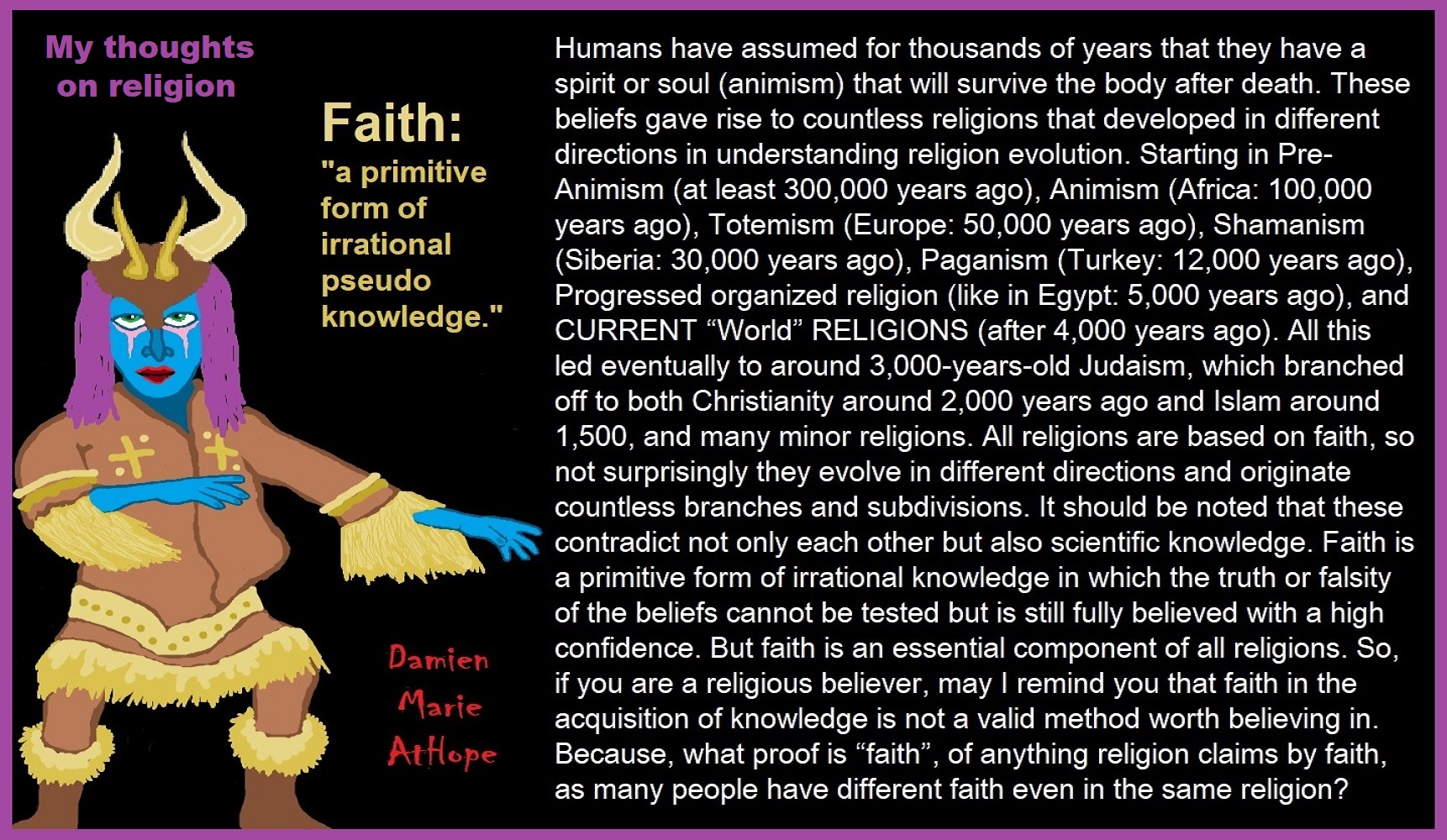


To me, Animism starts in Southern Africa, then to West Europe, and becomes Totemism. Another split goes near the Russia and Siberia border becoming Shamanism, which heads into Central Europe meeting up with Totemism, which also had moved there, mixing the two which then heads to Lake Baikal in Siberia. From there this Shamanism-Totemism heads to Turkey where it becomes Paganism.
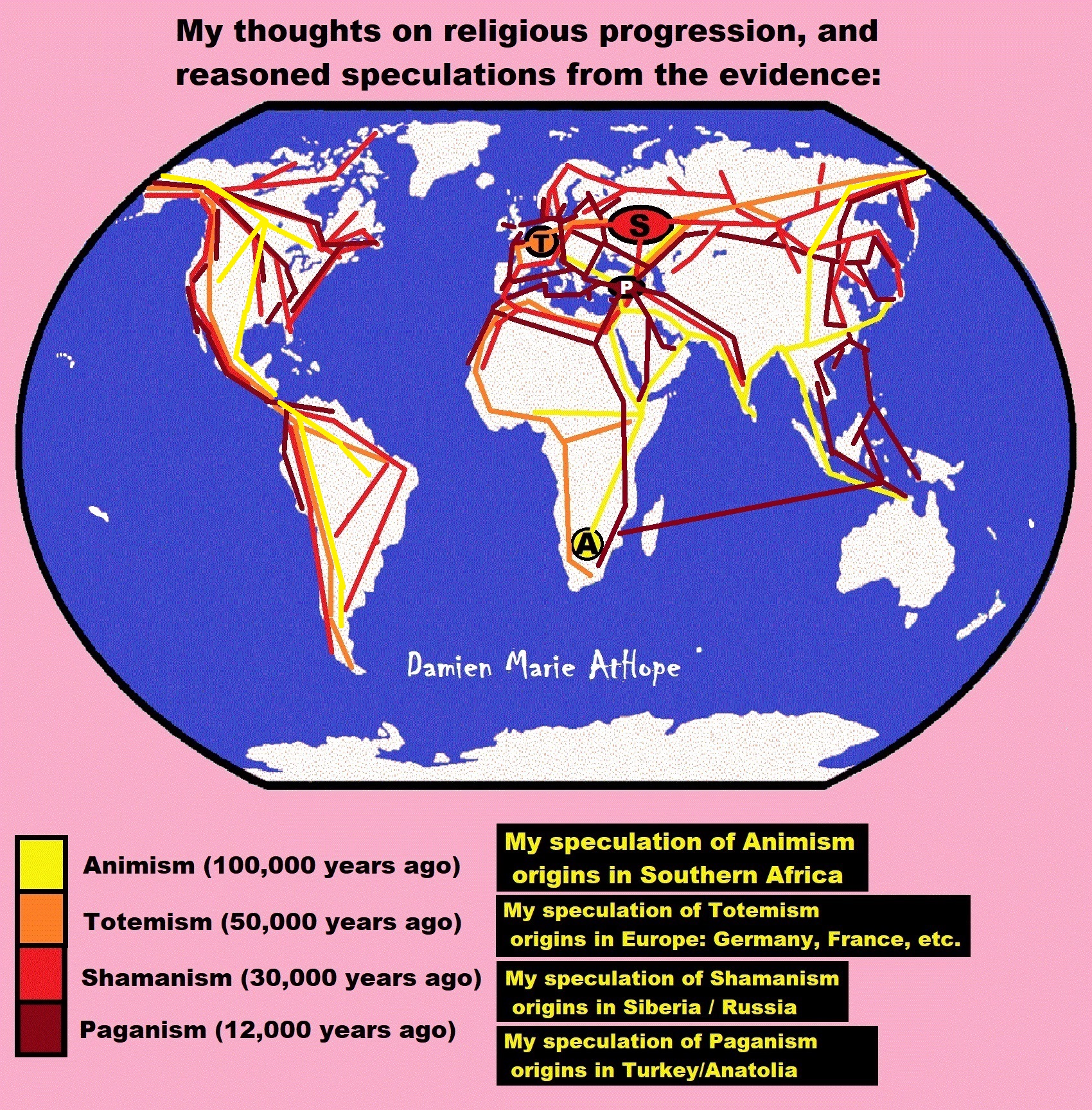
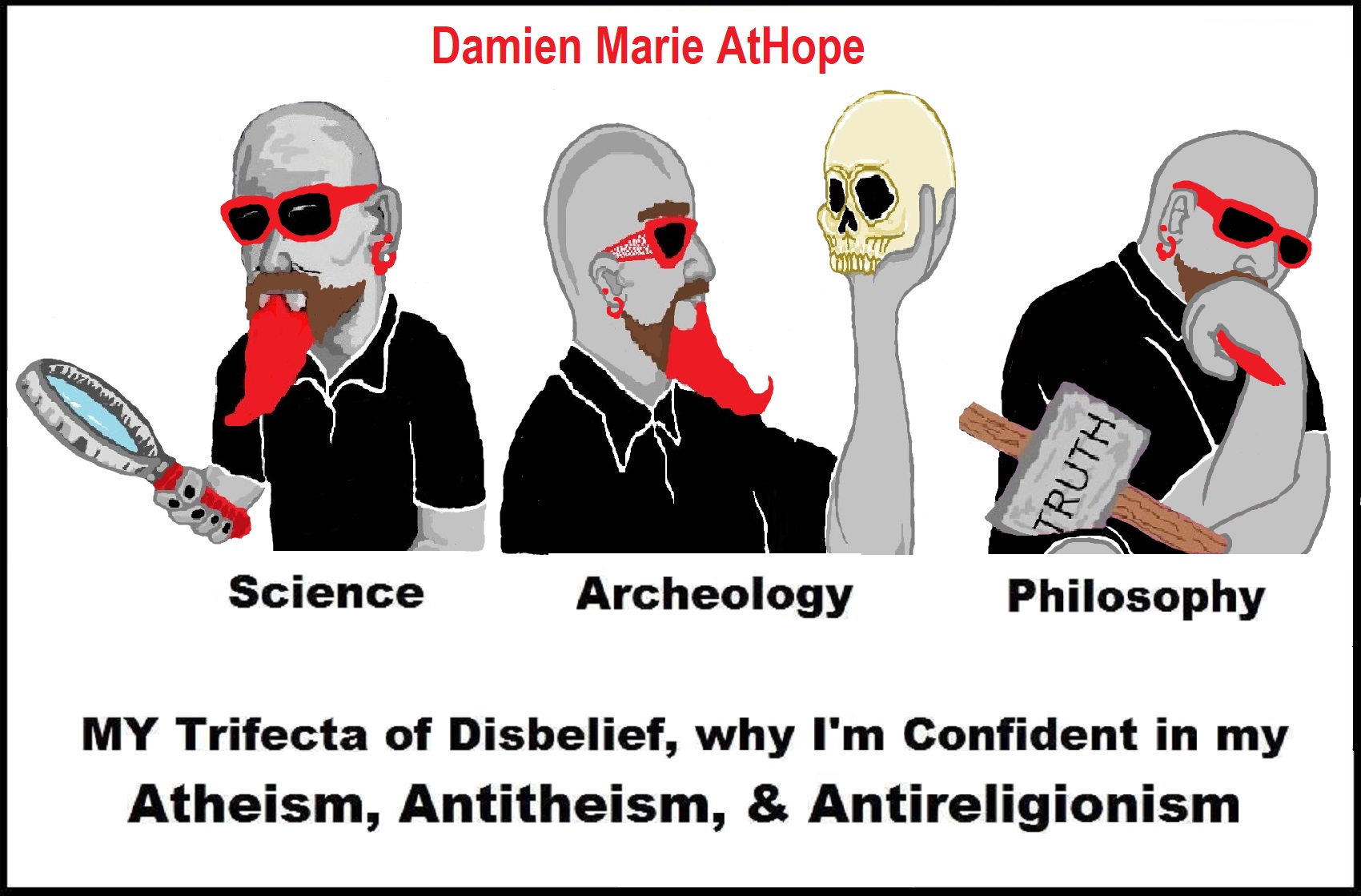
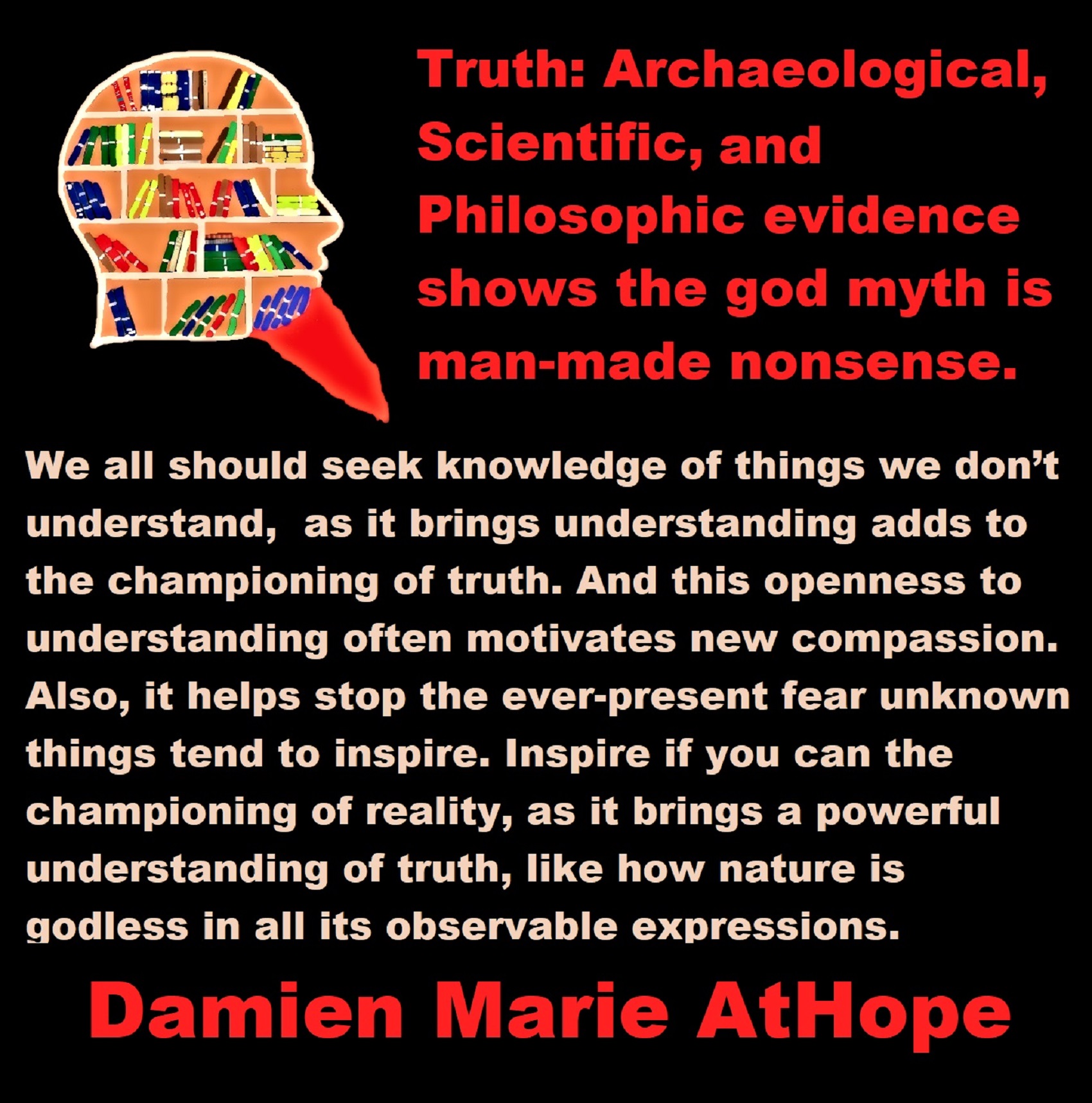

Not all “Religions” or “Religious Persuasions” have a god(s) but
All can be said to believe in some imaginary beings or imaginary things like spirits, afterlives, etc.
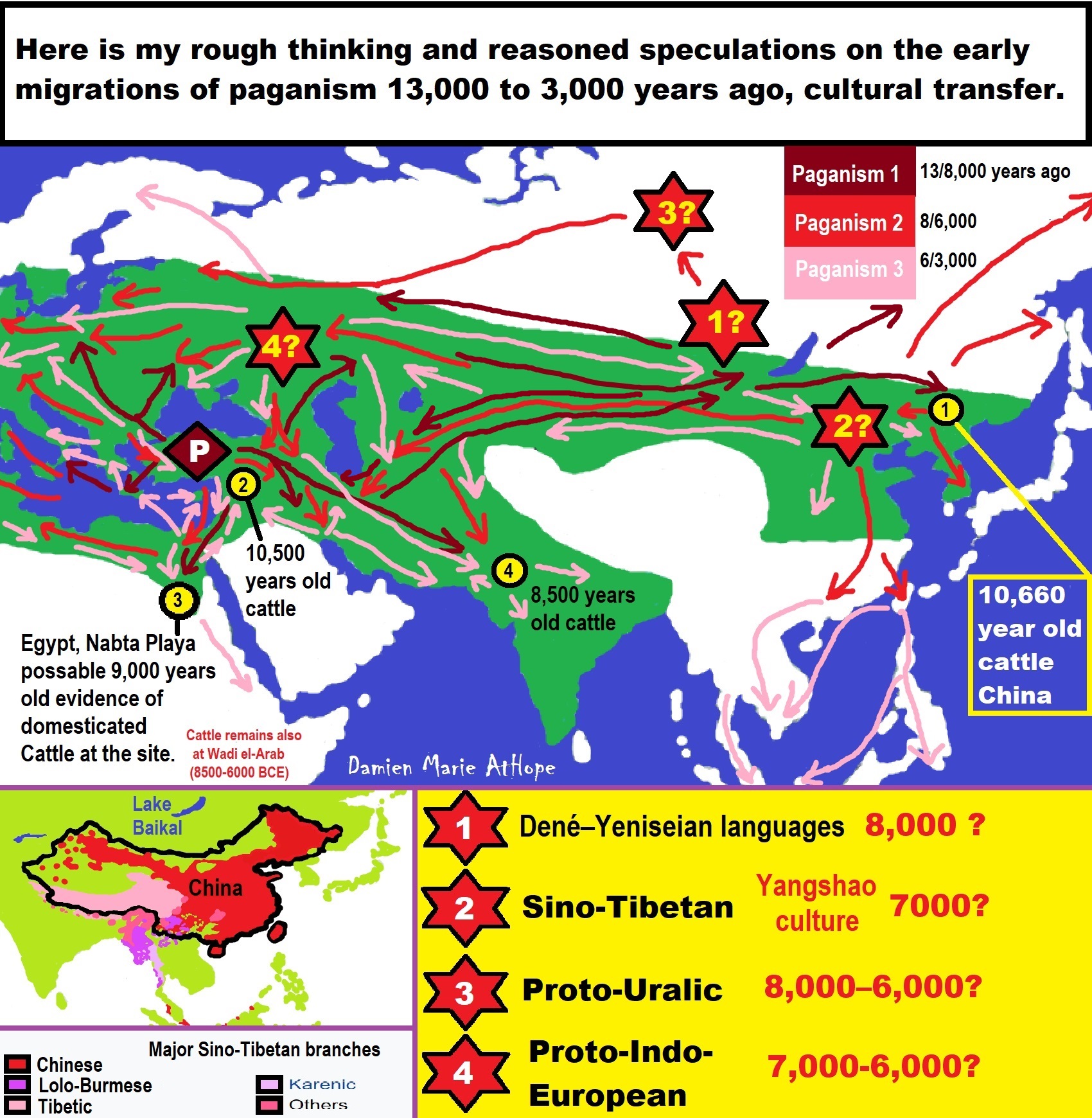
Paganism 12,000-4,000 years old
12,000-7,000 years old: related to (Pre-Capitalism)
7,000-5,000 years old: related to (Capitalism) (World War 0) Elite and their slaves!
5,000 years old: related to (Kings and the Rise of the State)
4,000 years old: related to (First Moralistic gods, then the Origin time of Monotheism)
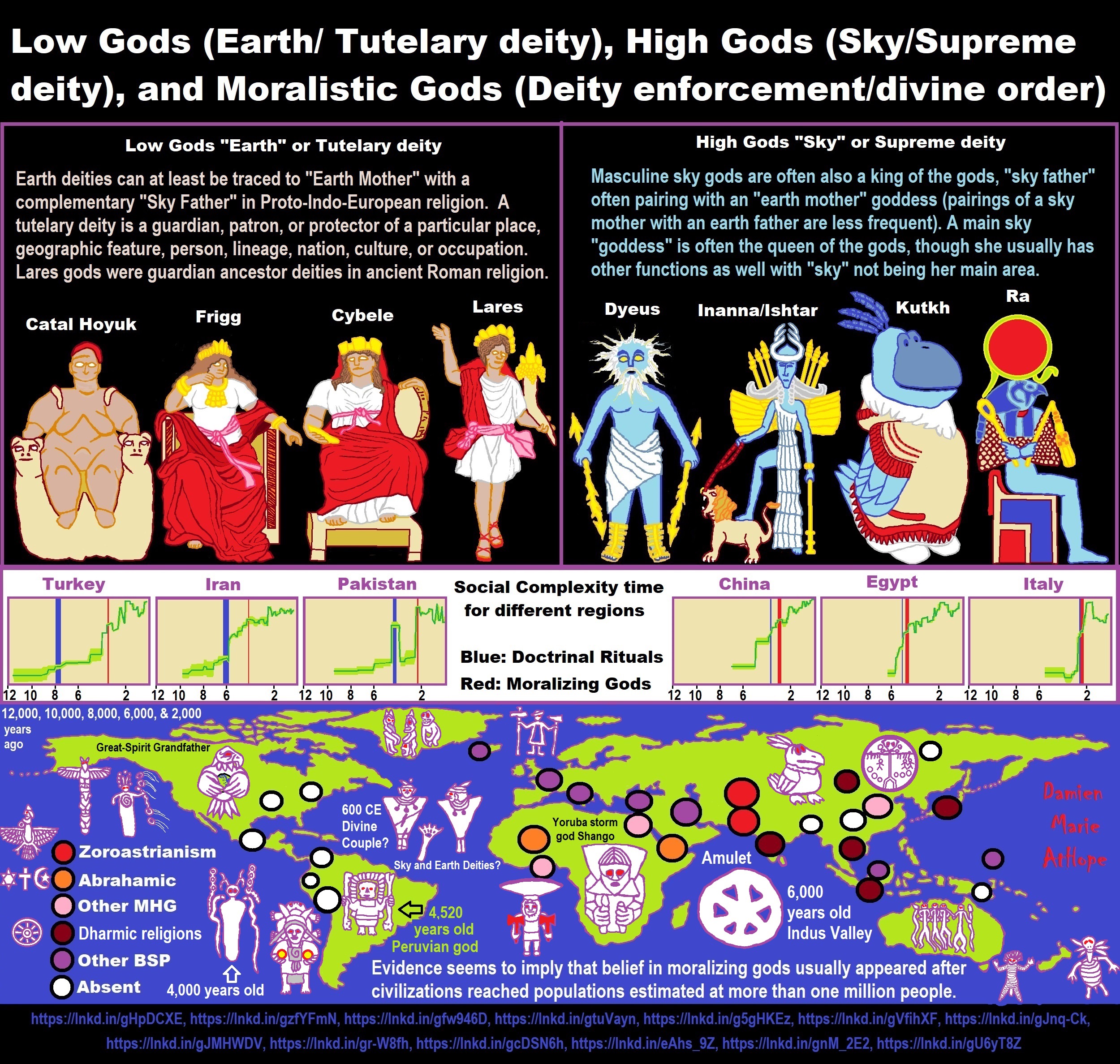
ref, ref, ref, ref, ref, ref, ref, ref, ref, ref, ref, ref, ref, ref, ref, ref, ref, ref, ref, ref, ref
Low Gods “Earth” or Tutelary deity and High Gods “Sky” or Supreme deity
“An Earth goddess is a deification of the Earth. Earth goddesses are often associated with the “chthonic” deities of the underworld. Ki and Ninhursag are Mesopotamian earth goddesses. In Greek mythology, the Earth is personified as Gaia, corresponding to Roman Terra, Indic Prithvi/Bhūmi, etc. traced to an “Earth Mother” complementary to the “Sky Father” in Proto-Indo-European religion. Egyptian mythology exceptionally has a sky goddess and an Earth god.” ref
“A mother goddess is a goddess who represents or is a personification of nature, motherhood, fertility, creation, destruction or who embodies the bounty of the Earth. When equated with the Earth or the natural world, such goddesses are sometimes referred to as Mother Earth or as the Earth Mother. In some religious traditions or movements, Heavenly Mother (also referred to as Mother in Heaven or Sky Mother) is the wife or feminine counterpart of the Sky father or God the Father.” ref
“Any masculine sky god is often also king of the gods, taking the position of patriarch within a pantheon. Such king gods are collectively categorized as “sky father” deities, with a polarity between sky and earth often being expressed by pairing a “sky father” god with an “earth mother” goddess (pairings of a sky mother with an earth father are less frequent). A main sky goddess is often the queen of the gods and may be an air/sky goddess in her own right, though she usually has other functions as well with “sky” not being her main. In antiquity, several sky goddesses in ancient Egypt, Mesopotamia, and the Near East were called Queen of Heaven. Neopagans often apply it with impunity to sky goddesses from other regions who were never associated with the term historically. The sky often has important religious significance. Many religions, both polytheistic and monotheistic, have deities associated with the sky.” ref
“In comparative mythology, sky father is a term for a recurring concept in polytheistic religions of a sky god who is addressed as a “father”, often the father of a pantheon and is often either a reigning or former King of the Gods. The concept of “sky father” may also be taken to include Sun gods with similar characteristics, such as Ra. The concept is complementary to an “earth mother“. “Sky Father” is a direct translation of the Vedic Dyaus Pita, etymologically descended from the same Proto-Indo-European deity name as the Greek Zeûs Pater and Roman Jupiter and Germanic Týr, Tir or Tiwaz, all of which are reflexes of the same Proto-Indo-European deity’s name, *Dyēus Ph₂tḗr. While there are numerous parallels adduced from outside of Indo-European mythology, there are exceptions (e.g. In Egyptian mythology, Nut is the sky mother and Geb is the earth father).” ref
Tutelary deity
“A tutelary (also tutelar) is a deity or spirit who is a guardian, patron, or protector of a particular place, geographic feature, person, lineage, nation, culture, or occupation. The etymology of “tutelary” expresses the concept of safety and thus of guardianship. In late Greek and Roman religion, one type of tutelary deity, the genius, functions as the personal deity or daimon of an individual from birth to death. Another form of personal tutelary spirit is the familiar spirit of European folklore.” ref
“A tutelary (also tutelar) in Korean shamanism, jangseung and sotdae were placed at the edge of villages to frighten off demons. They were also worshiped as deities. Seonangshin is the patron deity of the village in Korean tradition and was believed to embody the Seonangdang. In Philippine animism, Diwata or Lambana are deities or spirits that inhabit sacred places like mountains and mounds and serve as guardians. Such as: Maria Makiling is the deity who guards Mt. Makiling and Maria Cacao and Maria Sinukuan. In Shinto, the spirits, or kami, which give life to human bodies come from nature and return to it after death. Ancestors are therefore themselves tutelaries to be worshiped. And similarly, Native American beliefs such as Tonás, tutelary animal spirit among the Zapotec and Totems, familial or clan spirits among the Ojibwe, can be animals.” ref
“A tutelary (also tutelar) in Austronesian beliefs such as: Atua (gods and spirits of the Polynesian peoples such as the Māori or the Hawaiians), Hanitu (Bunun of Taiwan‘s term for spirit), Hyang (Kawi, Sundanese, Javanese, and Balinese Supreme Being, in ancient Java and Bali mythology and this spiritual entity, can be either divine or ancestral), Kaitiaki (New Zealand Māori term used for the concept of guardianship, for the sky, the sea, and the land), Kawas (mythology) (divided into 6 groups: gods, ancestors, souls of the living, spirits of living things, spirits of lifeless objects, and ghosts), Tiki (Māori mythology, Tiki is the first man created by either Tūmatauenga or Tāne and represents deified ancestors found in most Polynesian cultures). ” ref, ref, ref, ref, ref, ref, ref
Mesopotamian Tutelary Deities can be seen as ones related to City-States
“Historical city-states included Sumerian cities such as Uruk and Ur; Ancient Egyptian city-states, such as Thebes and Memphis; the Phoenician cities (such as Tyre and Sidon); the five Philistine city-states; the Berber city-states of the Garamantes; the city-states of ancient Greece (the poleis such as Athens, Sparta, Thebes, and Corinth); the Roman Republic (which grew from a city-state into a vast empire); the Italian city-states from the Middle Ages to the early modern period, such as Florence, Siena, Ferrara, Milan (which as they grew in power began to dominate neighboring cities) and Genoa and Venice, which became powerful thalassocracies; the Mayan and other cultures of pre-Columbian Mesoamerica (including cities such as Chichen Itza, Tikal, Copán and Monte Albán); the central Asian cities along the Silk Road; the city-states of the Swahili coast; Ragusa; states of the medieval Russian lands such as Novgorod and Pskov; and many others.” ref
“The Uruk period (ca. 4000 to 3100 BCE; also known as Protoliterate period) of Mesopotamia, named after the Sumerian city of Uruk, this period saw the emergence of urban life in Mesopotamia and the Sumerian civilization. City-States like Uruk and others had a patron tutelary City Deity along with a Priest-King.” ref
“Chinese folk religion, both past, and present, includes myriad tutelary deities. Exceptional individuals, highly cultivated sages, and prominent ancestors can be deified and honored after death. Lord Guan is the patron of military personnel and police, while Mazu is the patron of fishermen and sailors. Such as Tu Di Gong (Earth Deity) is the tutelary deity of a locality, and each individual locality has its own Earth Deity and Cheng Huang Gong (City God) is the guardian deity of an individual city, worshipped by local officials and locals since imperial times.” ref
“A tutelary (also tutelar) in Hinduism, personal tutelary deities are known as ishta-devata, while family tutelary deities are known as Kuladevata. Gramadevata are guardian deities of villages. Devas can also be seen as tutelary. Shiva is the patron of yogis and renunciants. City goddesses include: Mumbadevi (Mumbai), Sachchika (Osian); Kuladevis include: Ambika (Porwad), and Mahalakshmi. In NorthEast India Meitei mythology and religion (Sanamahism) of Manipur, there are various types of tutelary deities, among which Lam Lais are the most predominant ones. Tibetan Buddhism has Yidam as a tutelary deity. Dakini is the patron of those who seek knowledge.” ref
“A tutelary (also tutelar) The Greeks also thought deities guarded specific places: for instance, Athena was the patron goddess of the city of Athens. Socrates spoke of hearing the voice of his personal spirit or daimonion:
You have often heard me speak of an oracle or sign which comes to me … . This sign I have had ever since I was a child. The sign is a voice which comes to me and always forbids me to do something which I am going to do, but never commands me to do anything, and this is what stands in the way of my being a politician.” ref
“Tutelary deities who guard and preserve a place or a person are fundamental to ancient Roman religion. The tutelary deity of a man was his Genius, that of a woman her Juno. In the Imperial era, the Genius of the Emperor was a focus of Imperial cult. An emperor might also adopt a major deity as his personal patron or tutelary, as Augustus did Apollo. Precedents for claiming the personal protection of a deity were established in the Republican era, when for instance the Roman dictator Sulla advertised the goddess Victory as his tutelary by holding public games (ludi) in her honor.” ref
“Each town or city had one or more tutelary deities, whose protection was considered particularly vital in time of war and siege. Rome itself was protected by a goddess whose name was to be kept ritually secret on pain of death (for a supposed case, see Quintus Valerius Soranus). The Capitoline Triad of Juno, Jupiter, and Minerva were also tutelaries of Rome. The Italic towns had their own tutelary deities. Juno often had this function, as at the Latin town of Lanuvium and the Etruscan city of Veii, and was often housed in an especially grand temple on the arx (citadel) or other prominent or central location. The tutelary deity of Praeneste was Fortuna, whose oracle was renowned.” ref
“The Roman ritual of evocatio was premised on the belief that a town could be made vulnerable to military defeat if the power of its tutelary deity were diverted outside the city, perhaps by the offer of superior cult at Rome. The depiction of some goddesses such as the Magna Mater (Great Mother, or Cybele) as “tower-crowned” represents their capacity to preserve the city. A town in the provinces might adopt a deity from within the Roman religious sphere to serve as its guardian, or syncretize its own tutelary with such; for instance, a community within the civitas of the Remi in Gaul adopted Apollo as its tutelary, and at the capital of the Remi (present-day Rheims), the tutelary was Mars Camulus.” ref
Household deity (a kind of or related to a Tutelary deity)
“A household deity is a deity or spirit that protects the home, looking after the entire household or certain key members. It has been a common belief in paganism as well as in folklore across many parts of the world. Household deities fit into two types; firstly, a specific deity – typically a goddess – often referred to as a hearth goddess or domestic goddess who is associated with the home and hearth, such as the ancient Greek Hestia.” ref
“The second type of household deities are those that are not one singular deity, but a type, or species of animistic deity, who usually have lesser powers than major deities. This type was common in the religions of antiquity, such as the Lares of ancient Roman religion, the Gashin of Korean shamanism, and Cofgodas of Anglo-Saxon paganism. These survived Christianisation as fairy-like creatures existing in folklore, such as the Anglo-Scottish Brownie and Slavic Domovoy.” ref
“Household deities were usually worshipped not in temples but in the home, where they would be represented by small idols (such as the teraphim of the Bible, often translated as “household gods” in Genesis 31:19 for example), amulets, paintings, or reliefs. They could also be found on domestic objects, such as cosmetic articles in the case of Tawaret. The more prosperous houses might have a small shrine to the household god(s); the lararium served this purpose in the case of the Romans. The gods would be treated as members of the family and invited to join in meals, or be given offerings of food and drink.” ref
“In many religions, both ancient and modern, a god would preside over the home. Certain species, or types, of household deities, existed. An example of this was the Roman Lares. Many European cultures retained house spirits into the modern period. Some examples of these include:
- Brownie (Scotland and England) or Hob (England) / Kobold (Germany) / Goblin / Hobgoblin
- Domovoy (Slavic)
- Nisse (Norwegian or Danish) / Tomte (Swedish) / Tonttu (Finnish)
- Húsvættir (Norse)” ref
“Although the cosmic status of household deities was not as lofty as that of the Twelve Olympians or the Aesir, they were also jealous of their dignity and also had to be appeased with shrines and offerings, however humble. Because of their immediacy they had arguably more influence on the day-to-day affairs of men than the remote gods did. Vestiges of their worship persisted long after Christianity and other major religions extirpated nearly every trace of the major pagan pantheons. Elements of the practice can be seen even today, with Christian accretions, where statues to various saints (such as St. Francis) protect gardens and grottos. Even the gargoyles found on older churches, could be viewed as guardians partitioning a sacred space.” ref
“For centuries, Christianity fought a mop-up war against these lingering minor pagan deities, but they proved tenacious. For example, Martin Luther‘s Tischreden have numerous – quite serious – references to dealing with kobolds. Eventually, rationalism and the Industrial Revolution threatened to erase most of these minor deities, until the advent of romantic nationalism rehabilitated them and embellished them into objects of literary curiosity in the 19th century. Since the 20th century this literature has been mined for characters for role-playing games, video games, and other fantasy personae, not infrequently invested with invented traits and hierarchies somewhat different from their mythological and folkloric roots.” ref
“In contradistinction to both Herbert Spencer and Edward Burnett Tylor, who defended theories of animistic origins of ancestor worship, Émile Durkheim saw its origin in totemism. In reality, this distinction is somewhat academic, since totemism may be regarded as a particularized manifestation of animism, and something of a synthesis of the two positions was attempted by Sigmund Freud. In Freud’s Totem and Taboo, both totem and taboo are outward expressions or manifestations of the same psychological tendency, a concept which is complementary to, or which rather reconciles, the apparent conflict. Freud preferred to emphasize the psychoanalytic implications of the reification of metaphysical forces, but with particular emphasis on its familial nature. This emphasis underscores, rather than weakens, the ancestral component.” ref
“William Edward Hearn, a noted classicist, and jurist, traced the origin of domestic deities from the earliest stages as an expression of animism, a belief system thought to have existed also in the neolithic, and the forerunner of Indo-European religion. In his analysis of the Indo-European household, in Chapter II “The House Spirit”, Section 1, he states:
The belief which guided the conduct of our forefathers was … the spirit rule of dead ancestors.” ref
“In Section 2 he proceeds to elaborate:
It is thus certain that the worship of deceased ancestors is a vera causa, and not a mere hypothesis. …
In the other European nations, the Slavs, the Teutons, and the Kelts, the House Spirit appears with no less distinctness. … [T]he existence of that worship does not admit of doubt. … The House Spirits had a multitude of other names which it is needless here to enumerate, but all of which are more or less expressive of their friendly relations with man. … In [England] … [h]e is the Brownie. … In Scotland this same Brownie is well known. He is usually described as attached to particular families, with whom he has been known to reside for centuries, threshing the corn, cleaning the house, and performing similar household tasks. His favorite gratification was milk and honey.” ref

ref, ref, ref, ref, ref, ref, ref, ref, ref, ref, ref, ref, ref, ref, ref, ref, ref
“These ideas are my speculations from the evidence.”
I am still researching the “god‘s origins” all over the world. So you know, it is very complicated but I am smart and willing to look, DEEP, if necessary, which going very deep does seem to be needed here, when trying to actually understand the evolution of gods and goddesses. I am sure of a few things and less sure of others, but even in stuff I am not fully grasping I still am slowly figuring it out, to explain it to others. But as I research more I am understanding things a little better, though I am still working on understanding it all or something close and thus always figuring out more.
Sky Father/Sky God?
“Egyptian: (Nut) Sky Mother and (Geb) Earth Father” (Egypt is different but similar)
Turkic/Mongolic: (Tengri/Tenger Etseg) Sky Father and (Eje/Gazar Eej) Earth Mother *Transeurasian*
Hawaiian: (Wākea) Sky Father and (Papahānaumoku) Earth Mother *Austronesian*
New Zealand/ Māori: (Ranginui) Sky Father and (Papatūānuku) Earth Mother *Austronesian*
Proto-Indo-European: (Dyḗus/Dyḗus ph₂tḗr) Sky Father and (Dʰéǵʰōm/Pleth₂wih₁) Earth Mother
Indo-Aryan: (Dyaus Pita) Sky Father and (Prithvi Mata) Earth Mother *Indo-European*
Italic: (Jupiter) Sky Father and (Juno) Sky Mother *Indo-European*
Etruscan: (Tinia) Sky Father and (Uni) Sky Mother *Tyrsenian/Italy Pre–Indo-European*
Hellenic/Greek: (Zeus) Sky Father and (Hera) Sky Mother who started as an “Earth Goddess” *Indo-European*
Nordic: (Dagr) Sky Father and (Nótt) Sky Mother *Indo-European*
Slavic: (Perun) Sky Father and (Mokosh) Earth Mother *Indo-European*
Illyrian: (Deipaturos) Sky Father and (Messapic Damatura’s “earth-mother” maybe) Earth Mother *Indo-European*
Albanian: (Zojz) Sky Father and (?) *Indo-European*
Baltic: (Perkūnas) Sky Father and (Saulė) Sky Mother *Indo-European*
Germanic: (Týr) Sky Father and (?) *Indo-European*
Colombian-Muisca: (Bochica) Sky Father and (Huythaca) Sky Mother *Chibchan*
Aztec: (Quetzalcoatl) Sky Father and (Xochiquetzal) Sky Mother *Uto-Aztecan*
Incan: (Viracocha) Sky Father and (Mama Runtucaya) Sky Mother *Quechuan*
China: (Tian/Shangdi) Sky Father and (Dì) Earth Mother *Sino-Tibetan*
Sumerian, Assyrian and Babylonian: (An/Anu) Sky Father and (Ki) Earth Mother
Finnish: (Ukko) Sky Father and (Akka) Earth Mother *Finno-Ugric*
Sami: (Horagalles) Sky Father and (Ravdna) Earth Mother *Finno-Ugric*
Puebloan-Zuni: (Ápoyan Ta’chu) Sky Father and (Áwitelin Tsíta) Earth Mother
Puebloan-Hopi: (Tawa) Sky Father and (Kokyangwuti/Spider Woman/Grandmother) Earth Mother *Uto-Aztecan*
Puebloan-Navajo: (Tsohanoai) Sky Father and (Estsanatlehi) Earth Mother *Na-Dene*
ref, ref, ref, ref, ref, ref, ref, ref, ref, ref, ref, ref, ref, ref, ref, ref, ref, ref, ref, ref, ref, ref, ref, ref, ref, ref, ref

Hinduism around 3,700 to 3,500 years old. ref
Judaism around 3,450 or 3,250 years old. (The first writing in the bible was “Paleo-Hebrew” dated to around 3,000 years ago Khirbet Qeiyafa is the site of an ancient fortress city overlooking the Elah Valley. And many believe the religious Jewish texts were completed around 2,500) ref, ref
Judaism is around 3,450 or 3,250 years old. (“Paleo-Hebrew” 3,000 years ago and Torah 2,500 years ago)
“Judaism is an Abrahamic, its roots as an organized religion in the Middle East during the Bronze Age. Some scholars argue that modern Judaism evolved from Yahwism, the religion of ancient Israel and Judah, by the late 6th century BCE, and is thus considered to be one of the oldest monotheistic religions.” ref
“Yahwism is the name given by modern scholars to the religion of ancient Israel, essentially polytheistic, with a plethora of gods and goddesses. Heading the pantheon was Yahweh, the national god of the Israelite kingdoms of Israel and Judah, with his consort, the goddess Asherah; below them were second-tier gods and goddesses such as Baal, Shamash, Yarikh, Mot, and Astarte, all of whom had their own priests and prophets and numbered royalty among their devotees, and a third and fourth tier of minor divine beings, including the mal’ak, the messengers of the higher gods, who in later times became the angels of Judaism, Christianity and Islam. Yahweh, however, was not the ‘original’ god of Israel “Isra-El”; it is El, the head of the Canaanite pantheon, whose name forms the basis of the name “Israel”, and none of the Old Testament patriarchs, the tribes of Israel, the Judges, or the earliest monarchs, have a Yahwistic theophoric name (i.e., one incorporating the name of Yahweh).” ref
“El is a Northwest Semitic word meaning “god” or “deity“, or referring (as a proper name) to any one of multiple major ancient Near Eastern deities. A rarer form, ‘ila, represents the predicate form in Old Akkadian and in Amorite. The word is derived from the Proto-Semitic *ʔil-, meaning “god”. Specific deities known as ‘El or ‘Il include the supreme god of the ancient Canaanite religion and the supreme god of East Semitic speakers in Mesopotamia’s Early Dynastic Period. ʼĒl is listed at the head of many pantheons. In some Canaanite and Ugaritic sources, ʼĒl played a role as father of the gods, of creation, or both. For example, in the Ugaritic texts, ʾil mlk is understood to mean “ʼĒl the King” but ʾil hd as “the god Hadad“. The Semitic root ʾlh (Arabic ʾilāh, Aramaic ʾAlāh, ʾElāh, Hebrew ʾelōah) may be ʾl with a parasitic h, and ʾl may be an abbreviated form of ʾlh. In Ugaritic the plural form meaning “gods” is ʾilhm, equivalent to Hebrew ʾelōhîm “powers”. In the Hebrew texts this word is interpreted as being semantically singular for “god” by biblical commentators. However the documentary hypothesis for the Old Testament (corresponds to the Jewish Torah) developed originally in the 1870s, identifies these that different authors – the Jahwist, Elohist, Deuteronomist, and the Priestly source – were responsible for editing stories from a polytheistic religion into those of a monotheistic religion. Inconsistencies that arise between monotheism and polytheism in the texts are reflective of this hypothesis.” ref
Jainism around 2,599 – 2,527 years old. ref
Confucianism around 2,600 – 2,551 years old. ref
Buddhism around 2,563/2,480 – 2,483/2,400 years old. ref
Christianity around 2,o00 years old. ref
Shinto around 1,305 years old. ref
Islam around 1407–1385 years old. ref
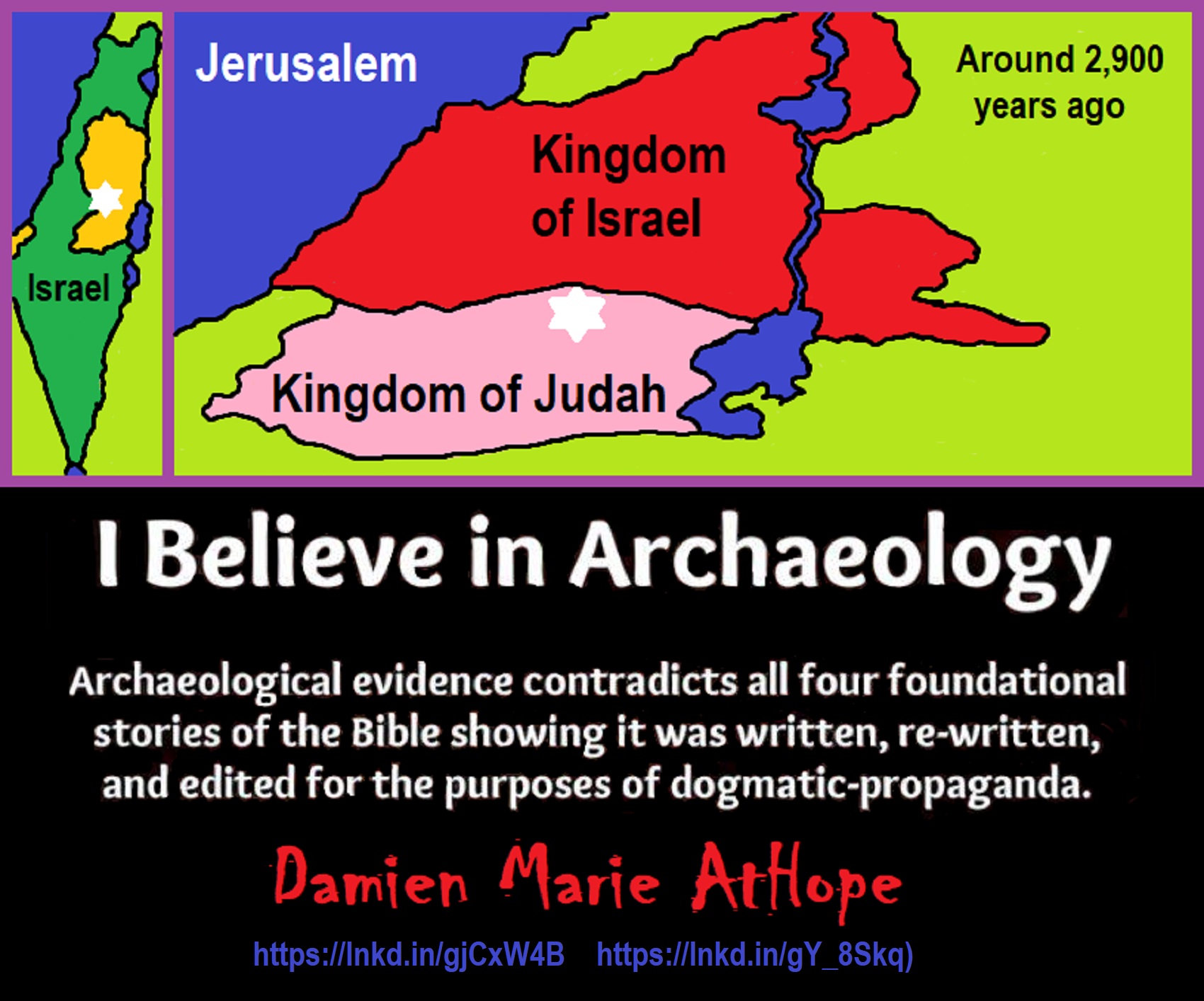
Knowledge to Ponder:
Stars/Astrology:
- Possibly, around 30,000 years ago (in simpler form) to 6,000 years ago, Stars/Astrology are connected to Ancestors, Spirit Animals, and Deities.
- The star also seems to be a possible proto-star for Star of Ishtar, Star of Inanna, or Star of Venus.
- Around 7,000 to 6,000 years ago, Star Constellations/Astrology have connections to the “Kurgan phenomenon” of below-ground “mound” stone/wood burial structures and “Dolmen phenomenon” of above-ground stone burial structures.
- Around 6,500–5,800 years ago, The Northern Levant migrations into Jordon and Israel in the Southern Levant brought new cultural and religious transfer from Turkey and Iran.
- “The Ghassulian Star,” a mysterious 6,000-year-old mural from Jordan may have connections to the European paganstic kurgan/dolmens phenomenon.
“Astrology is a range of divinatory practices, recognized as pseudoscientific since the 18th century, that claim to discern information about human affairs and terrestrial events by studying the apparent positions of celestial objects. Different cultures have employed forms of astrology since at least the 2nd millennium BCE, these practices having originated in calendrical systems used to predict seasonal shifts and to interpret celestial cycles as signs of divine communications. Most, if not all, cultures have attached importance to what they observed in the sky, and some—such as the Hindus, Chinese, and the Maya—developed elaborate systems for predicting terrestrial events from celestial observations. Western astrology, one of the oldest astrological systems still in use, can trace its roots to 19th–17th century BCE Mesopotamia, from where it spread to Ancient Greece, Rome, the Islamicate world and eventually Central and Western Europe. Contemporary Western astrology is often associated with systems of horoscopes that purport to explain aspects of a person’s personality and predict significant events in their lives based on the positions of celestial objects; the majority of professional astrologers rely on such systems.” ref
Around 5,500 years ago, Science evolves, The first evidence of science was 5,500 years ago and was demonstrated by a body of empirical, theoretical, and practical knowledge about the natural world. ref
Around 5,000 years ago, Origin of Logics is a Naturalistic Observation (principles of valid reasoning, inference, & demonstration) ref
Around 4,150 to 4,000 years ago: The earliest surviving versions of the Sumerian Epic of Gilgamesh, which was originally titled “He who Saw the Deep” (Sha naqba īmuru) or “Surpassing All Other Kings” (Shūtur eli sharrī) were written. ref
Hinduism:
- 3,700 years ago or so, the oldest of the Hindu Vedas (scriptures), the Rig Veda was composed.
- 3,500 years ago or so, the Vedic Age began in India after the collapse of the Indus Valley Civilization.
Judaism:
- around 3,000 years ago, the first writing in the bible was “Paleo-Hebrew”
- around 2,500 years ago, many believe the religious Jewish texts were completed
Myths: The bible inspired religion is not just one religion or one myth but a grouping of several religions and myths
- Around 3,450 or 3,250 years ago, according to legend, is the traditionally accepted period in which the Israelite lawgiver, Moses, provided the Ten Commandments.
- Around 2,500 to 2,400 years ago, a collection of ancient religious writings by the Israelites based primarily upon the Hebrew Bible, Tanakh, or Old Testament is the first part of Christianity’s bible.
- Around 2,400 years ago, the most accepted hypothesis is that the canon was formed in stages, first the Pentateuch (Torah).
- Around 2,140 to 2,116 years ago, the Prophets was written during the Hasmonean dynasty, and finally the remaining books.
- Christians traditionally divide the Old Testament into four sections:
- The first five books or Pentateuch (Torah).
- The proposed history books telling the history of the Israelites from their conquest of Canaan to their defeat and exile in Babylon.
- The poetic and proposed “Wisdom books” dealing, in various forms, with questions of good and evil in the world.
- The books of the biblical prophets, warning of the consequences of turning away from God:
- Henotheism:
- Exodus 20:23 “You shall not make other gods besides Me (not saying there are no other gods just not to worship them); gods of silver or gods of gold, you shall not make for yourselves.”
- Polytheism:
- Judges 10:6 “Then the sons of Israel again did evil in the sight of the LORD, served the Baals and the Ashtaroth, the gods of Aram, the gods of Sidon, the gods of Moab, the gods of the sons of Ammon, and the gods of the Philistines; thus they forsook the LORD and did not serve Him.”
- 1 Corinthians 8:5 “For even if there are so-called gods whether in heaven or on earth, as indeed there are many gods and many lords.”
- Monotheism:
- Isaiah 43:10 “You are my witnesses,” declares the LORD, “and my servant whom I have chosen, so that you may know and believe me and understand that I am he. Before me no god was formed, nor will there be one after me.
Around 2,570 to 2,270 Years Ago, there is a confirmation of atheistic doubting as well as atheistic thinking, mainly by Greek philosophers. However, doubting gods is likely as old as the invention of gods and should destroy the thinking that belief in god(s) is the “default belief”. The Greek word is apistos (a “not” and pistos “faithful,”), thus not faithful or faithless because one is unpersuaded and unconvinced by a god(s) claim. Short Definition: unbelieving, unbeliever, or unbelief.
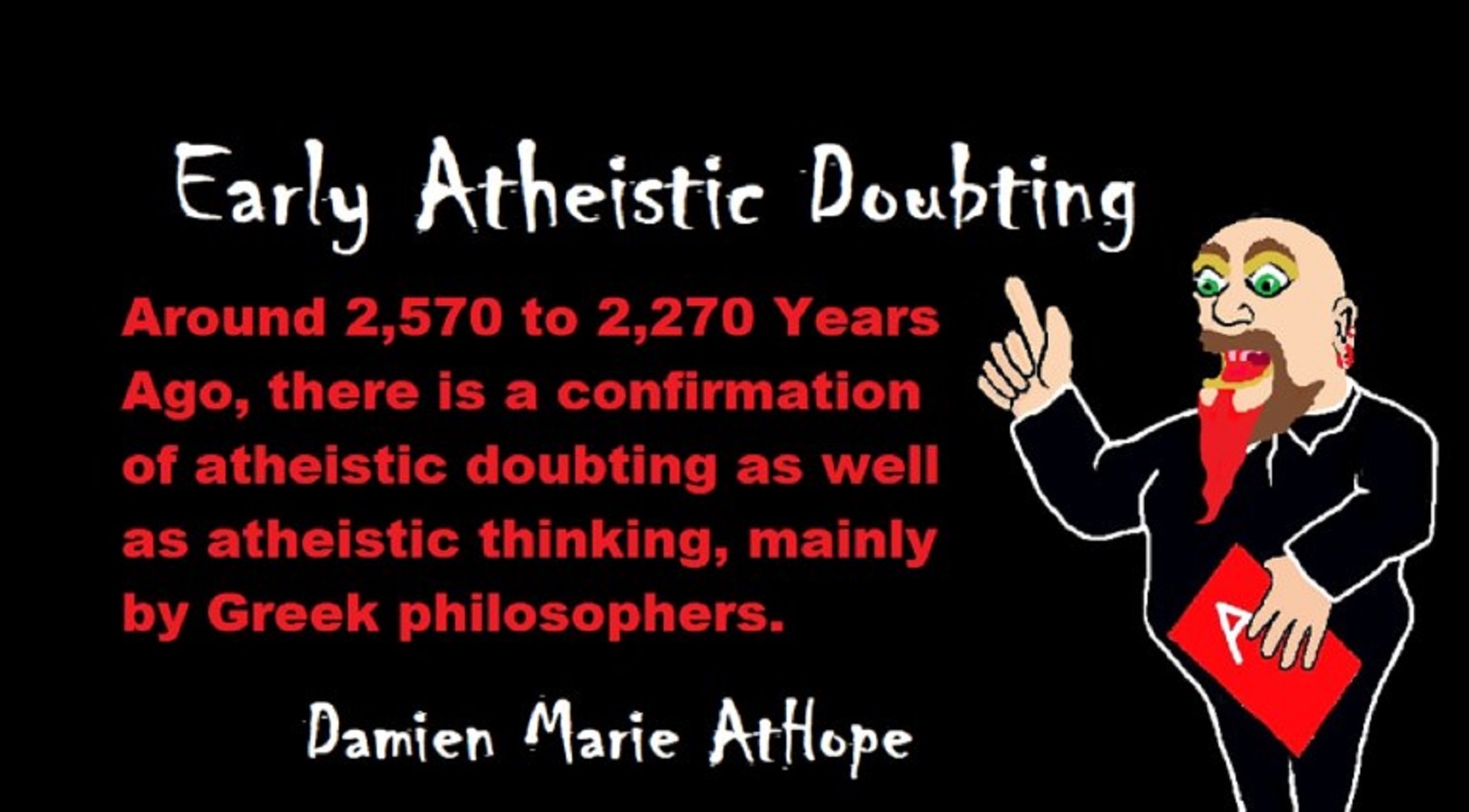
Expressions of Atheistic Thinking:
- Around 2,600 years ago, Ajita Kesakambali, ancient Indian philosopher, who is the first known proponent of Indian materialism. ref
- Around 2,535 to 2,475 years ago, Heraclitus, Greek pre-Socratic philosopher, a native of the Greek city Ephesus, Ionia, on the coast of Anatolia, also known as Asia Minor or modern Turkey. ref
- Around 2,500 to 2,400 years ago, according to The Story of Civilization book series certain African pygmy tribes have no identifiable gods, spirits, or religious beliefs or rituals, and even what burials accrue are without ceremony. ref
- Around 2,490 to 2,430 years ago, Empedocles, Greek pre-Socratic philosopher and a citizen of Agrigentum, a Greek city in Sicily. ref
- Around 2,460 to 2,370 years ago, Democritus, Greek pre-Socratic philosopher considered to be the “father of modern science” possibly had some disbelief amounting to atheism. ref
- Around 2,399 years ago or so, Socrates, a famous Greek philosopher was tried for sinfulness by teaching doubt of state gods. ref
- Around 2,341 to 2,270 years ago, Epicurus, a Greek philosopher known for composing atheistic critics and famously stated, “Is God willing to prevent evil, but not able? Then he is not omnipotent. Is he able, but not willing? Then he is malevolent. Is he both able and willing? Then whence cometh evil? Is he neither able nor willing? Then why call him god?” ref
This last expression by Epicurus, seems to be an expression of Axiological Atheism. To understand and utilize value or actually possess “Value Conscious/Consciousness” to both give a strong moral “axiological” argument (the problem of evil) as well as use it to fortify humanism and positive ethical persuasion of human helping and care responsibilities. Because value-blindness gives rise to sociopathic/psychopathic evil.
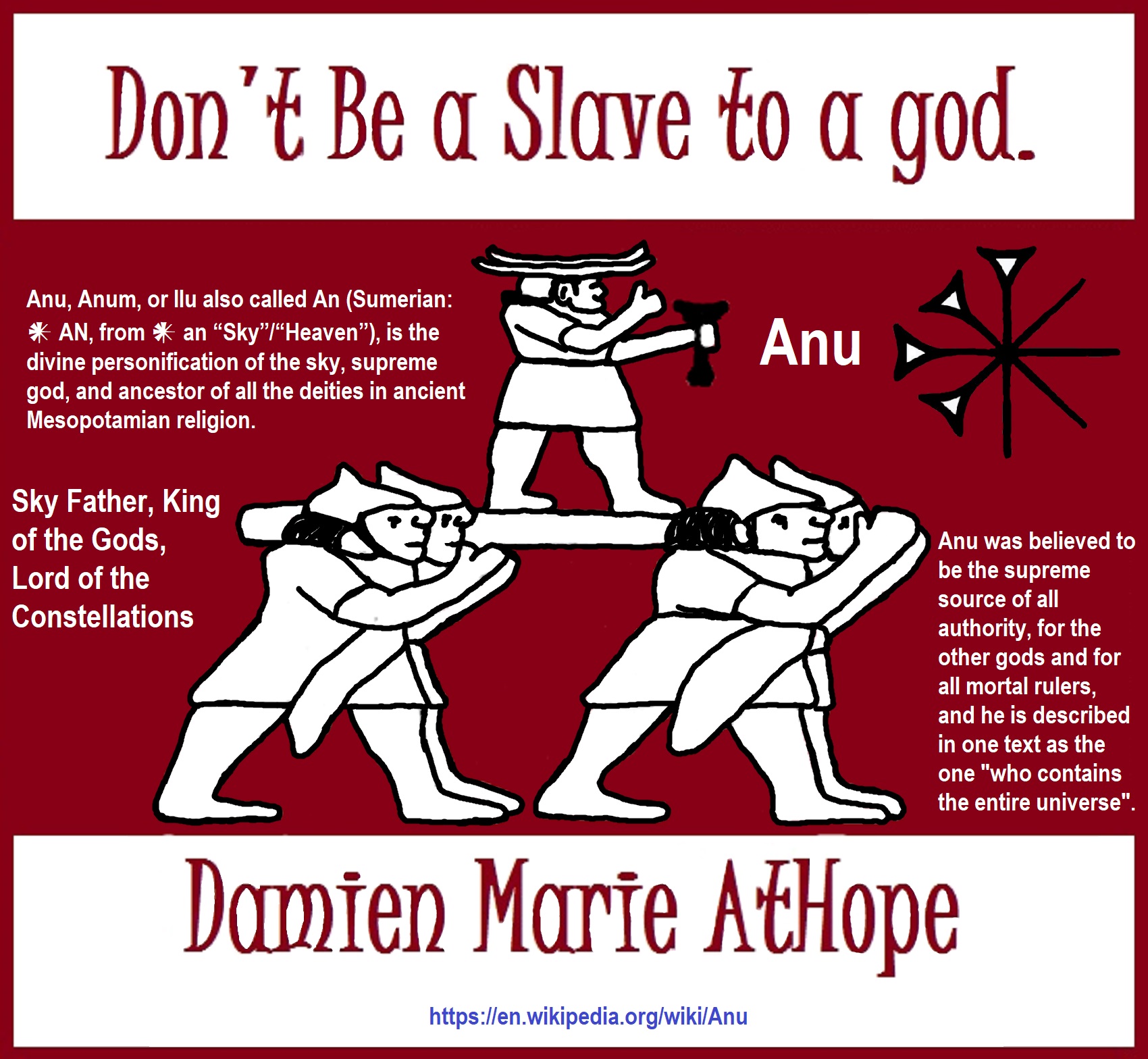
“Theists, there has to be a god, as something can not come from nothing.”
Well, thus something (unknown) happened and then there was something. This does not tell us what the something that may have been involved with something coming from nothing. A supposed first cause, thus something (unknown) happened and then there was something is not an open invitation to claim it as known, neither is it justified to call or label such an unknown as anything, especially an unsubstantiated magical thinking belief born of mythology and religious storytelling.

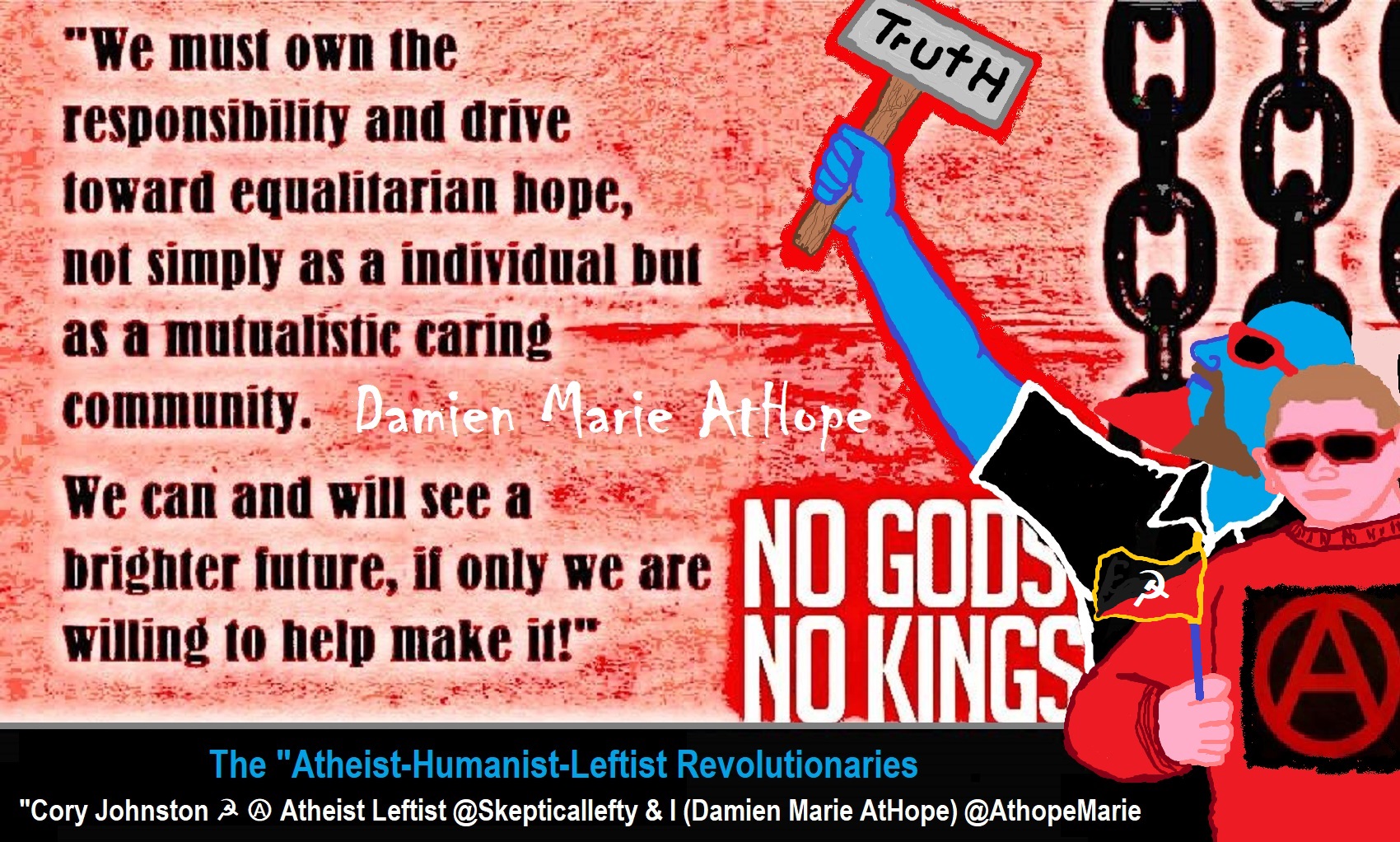
While hallucinogens are associated with shamanism, it is alcohol that is associated with paganism.
The Atheist-Humanist-Leftist Revolutionaries Shows in the prehistory series:
Show two: Pre-animism 300,000 years old and animism 100,000 years old: related to “Anarchism and Socialism”
Show tree: Totemism 50,000 years old: related to “Anarchism and Socialism”
Show four: Shamanism 30,000 years old: related to “Anarchism and Socialism”
Show five: Paganism 12,000 years old: related to “Anarchism and Socialism”
Show six: Emergence of hierarchy, sexism, slavery, and the new male god dominance: Paganism 7,000-5,000 years old: related to “Anarchism and Socialism” (Capitalism) (World War 0) Elite and their slaves!
Prehistory: related to “Anarchism and Socialism” the division of labor, power, rights, and recourses: VIDEO
Pre-animism 300,000 years old and animism 100,000 years old: related to “Anarchism and Socialism”: VIDEO
Totemism 50,000 years old: related to “Anarchism and Socialism”: VIDEO
Shamanism 30,000 years old: related to “Anarchism and Socialism”: VIDEO
Paganism 12,000 years old: related to “Anarchism and Socialism” (Pre-Capitalism): VIDEO
Paganism 7,000-5,000 years old: related to “Anarchism and Socialism” (Capitalism) (World War 0) Elite and their slaves: VIEDO
Paganism 5,000 years old: progressed organized religion and the state: related to “Anarchism and Socialism” (Kings and the Rise of the State): VIEDO
Paganism 4,000 years old: related to “Anarchism and Socialism” (First Moralistic gods, then the Origin time of Monotheism): VIEDO
I do not hate simply because I challenge and expose myths or lies any more than others being thought of as loving simply because of the protection and hiding from challenge their favored myths or lies.
The truth is best championed in the sunlight of challenge.
An archaeologist once said to me “Damien religion and culture are very different”
My response, So are you saying that was always that way, such as would you say Native Americans’ cultures are separate from their religions? And do you think it always was the way you believe?
I had said that religion was a cultural product. That is still how I see it and there are other archaeologists that think close to me as well. Gods too are the myths of cultures that did not understand science or the world around them, seeing magic/supernatural everywhere.
I personally think there is a goddess and not enough evidence to support a male god at Çatalhöyük but if there was both a male and female god and goddess then I know the kind of gods they were like Proto-Indo-European mythology.
This series idea was addressed in, Anarchist Teaching as Free Public Education or Free Education in the Public: VIDEO
Our 12 video series: Organized Oppression: Mesopotamian State Force and the Politics of power (9,000-4,000 years ago), is adapted from: The Complete and Concise History of the Sumerians and Early Bronze Age Mesopotamia (7000-2000 BC): https://www.youtube.com/watch?v=szFjxmY7jQA by “History with Cy“
Show #1: Mesopotamian State Force and the Politics of Power (Samarra, Halaf, Ubaid)
Show #2: Mesopotamian State Force and the Politics of Power
Show #3: Mesopotamian State Force and the Politics of Power (Uruk and the First Cities)
Show #4: Mesopotamian State Force and the Politics of Power (First Kings)
Show #5: Mesopotamian State Force and the Politics of Power (Early Dynastic Period)
Show #6: Mesopotamian State Force and the Politics of Power
Show #7: Mesopotamian State Force and the Politics of Power (Sargon and Akkadian Rule)
Show #9: Mesopotamian State Force and the Politics of Power (Gudea of Lagash and Utu-hegal)
Show #12: Mesopotamian State Force and the Politics of Power (Aftermath and Legacy of Sumer)

The “Atheist-Humanist-Leftist Revolutionaries”
Cory Johnston ☭ Ⓐ Atheist Leftist @Skepticallefty & I (Damien Marie AtHope) @AthopeMarie (my YouTube & related blog) are working jointly in atheist, antitheist, antireligionist, antifascist, anarchist, socialist, and humanist endeavors in our videos together, generally, every other Saturday.
Why Does Power Bring Responsibility?
Think, how often is it the powerless that start wars, oppress others, or commit genocide? So, I guess the question is to us all, to ask, how can power not carry responsibility in a humanity concept? I know I see the deep ethical responsibility that if there is power their must be a humanistic responsibility of ethical and empathic stewardship of that power. Will I be brave enough to be kind? Will I possess enough courage to be compassionate? Will my valor reach its height of empathy? I as everyone, earns our justified respect by our actions, that are good, ethical, just, protecting, and kind. Do I have enough self-respect to put my love for humanity’s flushing, over being brought down by some of its bad actors? May we all be the ones doing good actions in the world, to help human flourishing.
I create the world I want to live in, striving for flourishing. Which is not a place but a positive potential involvement and promotion; a life of humanist goal precision. To master oneself, also means mastering positive prosocial behaviors needed for human flourishing. I may have lost a god myth as an atheist, but I am happy to tell you, my friend, it is exactly because of that, leaving the mental terrorizer, god belief, that I truly regained my connected ethical as well as kind humanity.
Cory and I will talk about prehistory and theism, addressing the relevance to atheism, anarchism, and socialism.
At the same time as the rise of the male god, 7,000 years ago, there was also the very time there was the rise of violence, war, and clans to kingdoms, then empires, then states. It is all connected back to 7,000 years ago, and it moved across the world.
Cory Johnston: https://damienmarieathope.com/2021/04/cory-johnston-mind-of-a-skeptical-leftist/?v=32aec8db952d
The Mind of a Skeptical Leftist (YouTube)
Cory Johnston: Mind of a Skeptical Leftist @Skepticallefty
The Mind of a Skeptical Leftist By Cory Johnston: “Promoting critical thinking, social justice, and left-wing politics by covering current events and talking to a variety of people. Cory Johnston has been thoughtfully talking to people and attempting to promote critical thinking, social justice, and left-wing politics.” http://anchor.fm/skepticalleft
Cory needs our support. We rise by helping each other.
Cory Johnston ☭ Ⓐ @Skepticallefty Evidence-based atheist leftist (he/him) Producer, host, and co-host of 4 podcasts @skeptarchy @skpoliticspod and @AthopeMarie
Damien Marie AtHope (“At Hope”) Axiological Atheist, Anti-theist, Anti-religionist, Secular Humanist. Rationalist, Writer, Artist, Poet, Philosopher, Advocate, Activist, Psychology, and Armchair Archaeology/Anthropology/Historian.
Damien is interested in: Freedom, Liberty, Justice, Equality, Ethics, Humanism, Science, Atheism, Antiteism, Antireligionism, Ignosticism, Left-Libertarianism, Anarchism, Socialism, Mutualism, Axiology, Metaphysics, LGBTQI, Philosophy, Advocacy, Activism, Mental Health, Psychology, Archaeology, Social Work, Sexual Rights, Marriage Rights, Woman’s Rights, Gender Rights, Child Rights, Secular Rights, Race Equality, Ageism/Disability Equality, Etc. And a far-leftist, “Anarcho-Humanist.”
I am not a good fit in the atheist movement that is mostly pro-capitalist, I am anti-capitalist. Mostly pro-skeptic, I am a rationalist not valuing skepticism. Mostly pro-agnostic, I am anti-agnostic. Mostly limited to anti-Abrahamic religions, I am an anti-religionist.
To me, the “male god” seems to have either emerged or become prominent around 7,000 years ago, whereas the now favored monotheism “male god” is more like 4,000 years ago or so. To me, the “female goddess” seems to have either emerged or become prominent around 11,000-10,000 years ago or so, losing the majority of its once prominence around 2,000 years ago due largely to the now favored monotheism “male god” that grow in prominence after 4,000 years ago or so.
My Thought on the Evolution of Gods?
Animal protector deities from old totems/spirit animal beliefs come first to me, 13,000/12,000 years ago, then women as deities 11,000/10,000 years ago, then male gods around 7,000/8,000 years ago. Moralistic gods around 5,000/4,000 years ago, and monotheistic gods around 4,000/3,000 years ago.
To me, animal gods were likely first related to totemism animals around 13,000 to 12,000 years ago or older. Female as goddesses was next to me, 11,000 to 10,000 years ago or so with the emergence of agriculture. Then male gods come about 8,000 to 7,000 years ago with clan wars. Many monotheism-themed religions started in henotheism, emerging out of polytheism/paganism.


Damien Marie AtHope (Said as “At” “Hope”)/(Autodidact Polymath but not good at math):
Axiological Atheist, Anti-theist, Anti-religionist, Secular Humanist, Rationalist, Writer, Artist, Jeweler, Poet, “autodidact” Philosopher, schooled in Psychology, and “autodidact” Armchair Archaeology/Anthropology/Pre-Historian (Knowledgeable in the range of: 1 million to 5,000/4,000 years ago). I am an anarchist socialist politically. Reasons for or Types of Atheism
My Website, My Blog, & Short-writing or Quotes, My YouTube, Twitter: @AthopeMarie, and My Email: damien.marie.athope@gmail.com


